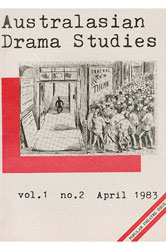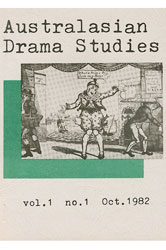ADS Journal Archive 1982-
From 2018 (Issue 72), Australasian Drama Studies will be published in digital format only.
Members of the Australasian Association for Theatre, Drama and Performance Studies are provided with access to the entire archive of the journal from its first issue in 1982 using the login provided.
Recent Issues and the ADS Archive from 1982 to the present will become visible in the drop down menu once you log in.
Online retrieval of articles is also available from APAFT (Australian Public Affairs Full Text Service) and from Informit (RMIT Publishing).
A new subscription system is currently under construction. Please check the Subscriptions page for updates.
Below is a list of all past issues...
Issue 87
Tue, 9 Dec 2025Printable version
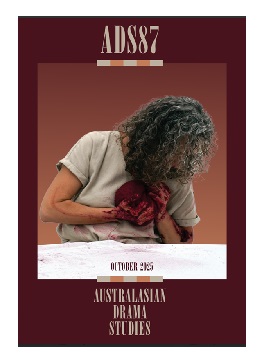 Australasian Drama Studies
Australasian Drama Studies
Issue 87| October 2025
- Issue 87 (Full Issue PDF)
- Contents
- EDITORIAL: CARE, DISCOMFORT AND PERFORMANCE
-
Careful Laughter and Queer Futurity in the Translating and Staging of Austere Rex Gamao’s Ambot sa Essay Kwoah – Erika M. Carreon, Austere Rex Gamao and Chloe Ho
This collaboratively written article highlights the care work at play in the authoring and staging of an agi’s experience by writer Austere Rex Gamao and Manila-based genderqueer collective Ang Mga Baklang Kanal (BKNL) respectively. It includes a first-hand discussion of discomfort experienced by Gamao in the process of textually translating the written essay from English, published in Cordite Poetry Review, to Sward-Hiligaynon, published in Art+Australia. Gamao’s discomfort, mirrored by the uncertainty of BKNL’s audience, is eased but not fully released in nervous laughter whenever performers and stage elements give permission to laugh through linguistic context, lighting and other stage and performative cues. These linguistic and dramatic translations of humour are discussed in relation to Glissant’s notion of opacity and as strategies of resisting queer erasure. We underline the laughter that results from this to open up the potential of experiencing queer time, a glimpse of queer futurity in the here and now.
Keywords
Queer time, queer futurity, discomfort, care -
Devising, Discomfort and Working with the Unknown: Making a Show with Music and Theatre Students at a Regional University – Hannah Joyce Banks and Briony Luttrell In this article, we reflect on our experiences as practitioners and educators leading an annual devising collaboration between Music and Theatre at the University of the Sunshine Coast, that results in a new, one-hour production. We discuss the complexities of devising, in particular how we navigate the balance of wellbeing with encouraging students to work outside of their comfort zones in a devised theatre process full of uncertainty. In response to pedagogy and devising scholarship, and themes that emerged from our four case studies, we propose a new approach, the Creative Collaboration SeeSaw. Our aim in writing this article is to articulate our experiences of being director, musical director, and teachers, as we navigate with our cohorts the tensions between care, comfort, discomfort, learning and safety in a collaborative devising process full of doubt and the unknown.
Keywords
Devising, interdisciplinary collaboration, pedagogy, creative practice, discomfort - Rebus Theatre’s Project Alchemy: On the Limits of Trauma-Informed Approaches in Applied Arts Projects – Vahri McKenzie and Robin Davidson Rebus Theatre’s Project Alchemy recruited fifteen regional artists from five Local Government Areas severely impacted by the Black Summer Bushfires. They produced five major artist-led community projects, including participatory events, public performances and exhibitions. Taking Project Alchemy as a starting point, this collaborative article engages critically with trauma-informed approaches in applied arts contexts, suggesting that the automatic adoption of this now-standardised health training should be re-evaluated in projects prioritising creative practice expertise. Interpreting our discoveries alongside recent and relevant literature, we found, first, that an uncritical over-reliance on health-oriented, trauma-informed frameworks can undermine such approaches’ best intentions. Second, further research is needed to understand the caring relations provided by creative practice itself in projects that adopt trauma-informed approaches in applied arts settings. Creative practice expertise is a distinct social and epistemological category that may be diminished in arts–health work because it lacks the financial resources of health and disaster recovery systems.
Keywords
Trauma-informed care and practice, arts–health, applied arts, creative practice expertise, arts-based evaluation
- Who Cares for the Carers? Verbatim Theatre and Hospital Workplace Culture – Paul Dwyer, Claire Hooker, Louise Nash, Karen Scott and David Williams There is ample evidence of the damage that healthcare practitioners sometimes do to one another in the too-frequently toxic workplaces to which they have become acculturated. Bullying, sexual harassment and discrimination are a common experience in hospitals, for doctors, nurses and allied health workers, and particularly for medical students, junior doctors and trainee specialists. Rates of clinical depression and anxiety, suicidal ideation and suicidal behaviour among this population are well above the norm. In this article, we offer a methodological commentary on the making of Grace Under Pressure, a verbatim theatre project that aimed to help make sense of some of the distress and discomfort experienced by healthcare workers and to support efforts to challenge the culture that produces such mistreatment. We do so in a spirit of critical reflexivity, acknowledging that verbatim theatre has the potential to harm as well as to repair. The questions we address here include: What are the risks against which the promise of verbatim theatre practice must be weighed? What tensions exist between verbatim theatre practice and qualitative methods of research as they are typically deployed by health researchers? How do interviewees/ research participants exercise agency within a process where theatre-makers are often pursuing their own dramaturgical logic
Keywords
Verbatim theatre, methodology, healthcare, hospitals, workplace culture - Whakamana: Enhancing Dignity in Theatre with Precarious Communities – Punitive Welfare and the Deficit of Care in Un-Welfare State (2023) – Rand Hazou and Adrian Jackson This article interrogates various aspects of care, safety, risk and discomfort in the Hobson Street Theatre Company production Un-Welfare State (2023). The verbatim drama explored experiences of the welfare system in Aotearoa and highlighted the apparent deficit of ‘care’ within an increasingly ‘punitive’ welfare system.Using Un-Welfare State as a case study, this article suggests that within the discourse of applied theatre, where practice is arguably increasingly regulated by tighter ‘health and safety’ regimes, attention is increasingly skewed towards notions of care that often uncritically emphasise the need to create safety and minimise risk and discomfort. This article argues that theatre made in such conditions should focus on ‘enhancing dignity’ to bring some nuance to considerations of care in our practice. Drawing on the scholarship of the Dignity of Risk (DofR) from disability and aged care studies, we argue that the notion of dignity opens up potentially useful considerations for arts practitioners and scholars working in precarious settings. This approach acknowledges the value of risk in nurturing the dignity and inherent worth of community participants.In this article, we are interested in what happens when we centre ‘dignity’ within theatre practice, particularly when working in spaces and with communities where notions of ‘care’ and ‘safety’ are tenuous, and where potential for ‘risk’ and ‘discomfort’ is substantial. This article argues that focusing on dignity may be a useful approach to negotiate aspects of care, safety, risk and discomfort within applied theatre projects with precarious communities.
Keywords
Documentary theatre, risk, care, dignity, punitive welfare - Discomfort, Access and Care in (Learning-)Disabled Theatre – Tony McCaffrey The article draws on twenty years of practical experience with Different Light Theatre to highlight issues of access intimacy and friction within the company in the encounter of performers with different disabilities. It shows how these difficulties emerge in collective theatre-making and become the material for performance. It locates these practices within the wider context of disability performance art that confronts audiences with their own vulnerability. Finally, it suggests how performance that incorporates pain and discomfort opens up personal and political possibilities, different modes of understanding and practising access and care, and a more diverse and disability-led experience of theatre.
Keywords
Learning disabled theatre, ethics of care, care aesthetics, access intimacy/ friction, dignity of risk - Disrupting the ‘Double Empathy’ Problem: Creating Cultural Safety for Neurominorities in Performing Arts Education and Employment – Bree Hadley The arts industry in Australia currently demonstrates a commitment to diversity. d/Deaf, Disabled and/or Neurodivergent artists – particularly ‘invisibly’ disabled Neurodivergent artists – have not always felt foregrounded in this discourse. Policy and funding programmes have not equalised our education and employment outcomes. In a recent Psychology PhD, Christine Antonopoulos (2024) examines policy, stated intention and workplace practice, finding that – despite stated intentions – 80 per cent of Australians implicitly perceive Disabled people as cold, incompetent and childlike. In Autism studies, Damian Milton (2012) describes this as a ‘double empathy’ problem. Neurodivergent ways of communicating, collaborating and co-working can ‘discomfort’ Neurotypical workers. Masking to fit into Neurotypical workplaces, projects and processes can ‘discomfort’ Neurodivergent workers. This, theatre-maker Alexander Leggett (2023) says, is not a competence problem – it is a ‘translation’ problem. In this article, I draw on education, employment and arts research, including interviews with Australian artists, to consider strategies to bridge this gap in understanding, and create cultural safety for neurominorities in the performing arts.
Keywords
Performing arts education, performing arts employment, equity, access, neurodiversity, neuroinclusion, cultural safety - Collaborative Care: Artistic Reflection on the Creation of Agiles, an AR Prototype for Creativity and Mobility – Sarah Neville, Eva Sifis, Alex DeGaris, Scott Coleman, Matthew J.W. Thomas and This article offers an artistic reflection on care within cross-disciplinary co-creation, focusing on the development of the Agiles Augmented Reality (AR) application during an artist residency at Assemblage: Centre for Creative Arts. Agiles AR is a digital performance prototype designed as an instrument of care for use in healthcare contexts, encouraging users to explore mobility and balance through creative movement. The co-creation process was underpinned by principles of collaborative care, ensuring the inclusion of participants with and without lived experience of acquired brain injury and disability. Reflections focus on the ethics of care required to navigate interdisciplinary collaboration, and on negotiating discomfort and ease within embodied practice. These insights emerge from within the specific challenges of academic research structures, artistic collaboration, and the embodied experiences of the creative team.
Keywords
Co-creation, care, Augmented Reality, mobility, creativity - Embodied Healing: Scar, Touch and Poetic Witnessing in Performance Art – Tingyu Liu This article explores Marks, Skin and Silent Verbs, a participatory performance art project by Chinese artist Wang Xiyue, presented in Chengdu, China, 2024. Focusing on physical scars, this performance transforms the skin into a site of memory, trauma and healing. Drawing on Didier Anzieu’s concept of the Moi-Peau (Skin-Ego), this article examines how Wang uses intimate gestures, such as touch and temporary poetic tattooing, to reframe scars as symbols of resilience. Through embodied interaction, discomfort becomes a necessary prelude to healing, allowing participants to encounter and explore vulnerability as it emerges in the performance and to reclaim a sense of narrative agency. Participants’ responses reveal the profound emotional impact of the performance, highlighting its ability to foster empathy and empowerment. This article argues that Wang’s performance exemplifies how performance art can act as a relational and ethical practice, offering new possibilities for healing, recognition and the transformation of bodily memory into shared, poetic archives.
Keywords
Performance art, trauma, healing, embodied interaction, scar - Relational Patterns in Performance Art Practices: A Dialogue Between Representative and Performative Care – Cinzia Cremona This article aims to activate a productive dialogue between different modalities of performance, participation and care. The first part of the text introduces the key concepts that inform and shape the research – care, participation and performative relationality are defined in the context of performance art practices. These concepts overlap and lean on each other to form a solid conceptual framework. Performative writing and affective ethnography methodologies complement these analytical tools with a structured first-person voice better suited to access affect.
The body of this text discusses the implications of these concepts and methods for care-focused performances. The meaningful examination of performative and representative care in action, and the concluding comments, are intended to serve as a provocation for productive conversations.
Keywords
Relationality, performativity, caring, performance, affective ethnography - Performing Scenographies of Care: Finding Agency for Environmental Sustainability and Performance Design within Conventional Theatre Practices – Penny Challen, Paula Martins and Tanja Beer Practices of care are evident in theatre’s global shift towards environmental sustainability over the last decade. The ecological turn in the performing arts has seen a rise in efforts to reduce the environmental impacts of theatre production, including questioning the extractivist and unhealthy habits of theatre-making. Historically, an ‘at-all-costs’ approach where the ‘show must go on’, irrespective of the damage to the environment, or individuals involved, has been normalised. For many performance designers, the materially intensive customs of conventional theatre represent a disconnect between personal ecological values and practice, manifesting as a personal conflict with theatre creation systems. Explored through semi-structured interviews with five performance designers, this article examines how Australian practitioners are currently finding agency for ecologically sustainable practices within conventional theatre. Findings revealed the complexity and potential of care as a scenographic criterion, including the personal cost of and discomfort in the pursuit of ecological considerations in an industry yet to embrace sustainable ethics.
Keywords
Ecoscenography, performance design, care, sustainability, conventional theatre - Reviews
- Contributors
Issue 86
Thu, 29 May 2025Printable version
Australasian Drama Studies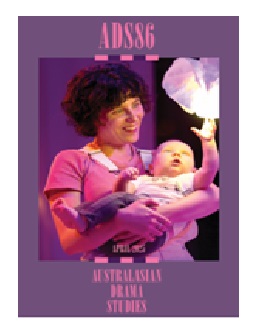
Issue 86| April 2025
2. Contents
3. Editorial
4. Reframing ‘Theatrical Hazards’: Risk and Ambition in Theatre for Early Years
The practice of creatingI and professionally presenting performance works for and with very young children, and their adults, is known as Theatre for Early Years (TEY). Noting that TEY is still considered emergent in Australia because of the extremely small field of Australia-based practitioners, this article builds out of two recent Australian works devised by artist-scholars Sarah Austin and Sally Chance, linking their scholarship and practice in an exploration of what might constitute risk and ambition in TEY, with artistic implications for the dramaturgical frameworks of the works.
Keywords
Theatre for Early Years, young children, participatory theatre, co-creation, participatory dramaturgy
The Negro Ensemble Company (NEC) explicitly aimed to improve the lives of African Americans, both culturally and materially, by producing work about Black experiences, for Black audiences, and by Black theatre practitioners. However, in apparent contradiction to these aims, the NEC’s co-founder and Artistic Director, Douglas Turner Ward, programmed Ray Lawler’s Summer of the Seventeenth Doll in its inaugural season in 1968. In a move that would surprise Australian readers, Ward relocated the play from Melbourne to New Orleans and cast it entirely with Black actors. What had been seen as a quintessentially (white) Australian play now spoke about Black lives and Black experiences. It was a politically contentious choice, and Ward and the NEC faced criticism over the lack of African American playwrights in their first season.
Keywords
Seventeenth Doll, Negro Ensemble Company
6. Pain, Anger and Hope in Prima Facie: Politicising the Contemporary Subject Through Affective Depictions of Rape on Stage
Suzie Miller’s Prima Facie has arguably been the most successful contemporary Australian play of the last decade. Its trajectory since its inaugural 2019 Griffin Theatre Company production in Sydney has been unprecedented: performed in at least fifteen countries, adapted into a novel, and a feature length film underway. Framed through Sara Ahmed’s cultural feminist theory on affective modes of feeling, Prima Facie acts as a powerful impetus for politicising sexual violence on stage. The play’s success hinges on its ability to tap into the power of affective feelings, like anger, pain and hope, intertwined with the embodied experience of sexual violence, as a potential method for politicising the contemporary subject into collectivised action. Consequently, Prima Facie enacts a seemingly impossible twofold task: positioning the complex emotions of sexual violence to political and social efficacy, and, in turn, potentially mobilising audiences to collectively be at the helm of demanding this change.
Keywords
Rape, emotion, affect, embodiment, feminism
7. Liveness in the Work of Ranters Theatre
While the work of Ranters has undergone a clear evolution since our inception as a company in 1994, our practice and methodology have always been grounded in a consistent exploration of liveness in terms of theory, and its practical application. The work of Ranters is designed to highlight what is essential and unrepeatable, a manifesting of the real, in the live exchange between audience and performers. For Ranters, the audient and the performer have always been considered active constituents, inseparable from what is defined as theatre. Over time there has been an increased focus
on the everyday and a theoretical exploration of everydayness to make visible the minutiae of actions within the live physical encounter. There has been a progressive shift in the emphasis to greater liveness, more immediacy and unpredictability.
Keywords
Liveness, everyday, postdramatic, dramaturgy, Ranters
8. Redefining Performance Relationships: Stretching the Limits of Bodily Co-Presence in the Audiovisual Exhibition Near Sighted
This article interrogates the ways in which we understand performance – as a process, as an outcome, and as a philosophical approach. Drawing on the innovative audiovisual exhibition Near Sighted (2023) as a case study, the article examines the ways in which notions of performance can be disrupted and reimagined. The authors employ three primary channels of analysis, drawing on relevant scholarship for each: critical reflection on the creation of work that employs expanded scenography and sonic dramaturgy; analysis of audience role in performance works; and critical engagement with how posthumanism informs performance-making. The article proposes that small shifts in artistic practice can have profound implications for an individual artist and also for the field of performance-making as artists contend with a swiftly changing and unsettled world.
Keywords
Expanded scenography, sonic dramaturgy, posthuman performance-making, participatory performance
9. Cities Under Strain in a Strange Epoch: Writing the Urban Anthropocene in Pomona and The Turquoise Elephant
This article suggests that city space and the Anthropocene can collide innovatively and productively on stage (as they collide outside it) in contemporary theatre. It proposes that writing for performance that embraces the absurdity of the Anthropocene – and that seeks to uncover and interrupt current dominant processes in city space which are driven by late capitalism – is found in Pomona (2014) by Alistair McDowall and The Turquoise Elephant (2016) by Stephen Carleton. These strange and disquieting works satirise late capitalism through heightened form, and use formal innovation to express the urban malaise/ climate anxiety bearing down on the content of the plays. The horror-adjacent, city-focused neoliberal critique of Pomona and the climate change satire of The Turquoise Elephant usefully offer formally connected but tonally disparate examples of this appropriately challenging turn in writing cities and the Anthropocene.
Keywords
Anthropocene, city space, ecological, playwriting
Hélène Cixous’ call for women to write themselves – ‘Woman must write woman’ – has been a guiding principle in my feminist adaptations of classical myths. Inspired by Cixous concept of écriture féminine, a fluid and poetic writing style rooted in the female body, the theatre performance Monstrous Woman (2022) was developed through a methodology grounded in corporeal writing, symbolic imagery, dreamlike fragmentation, emotional excess and polyvocality - embracing its open-ended nature as a feminist practice. This approach acknowledges and critiques traditional structures that have marginalised women in theatre. The labyrinth becomes both a metaphor and a method – an affective, non-linear path requiring emotional awareness, resilience and critical reflection. By rewriting myth, this work aimed to reveal the embedded inequities of the past and reimagine them for contemporary feminist theatre. This work contributes to a global feminist map, offering tools and waypoints for others navigating similar creative and political terrain.
Keywords
Feminist theatre, feminist theory, theatre directing and adaptation, devising, Cixous
11. Connecting Yoga, Playwriting and Romani Culture Through Autoethnography: An Investigation into How Yoga Was Utilised to Create a Dramatic Text for Theatre
This article investigates the relationships among yoga, playwriting and Romani culture in the creation of a dramatic work for theatre. The work’s development was grounded in the author’s experience as a playwright and yoga practitioner of Romani origin. Historically, yoga has adapted to changing societal circumstances and cultural traditions. However, the traditional eightfold path of yoga has not previously been implemented as a developmental structure for playwriting. This autoethnographic, practice-led research project investigates the relationship between yoga and the writing of a play exploring aspects of Romani culture derived from the author’s personal and anecdotal experiences. Yoga principles and practices from the eightfold path were applied to stimulate a state of flow, which fed directly into the playwriting process. Journal writing was concurrently undertaken as a means of reflecting on and guiding the playwriting process and the emerging content. The outcomes suggest the benefits of this approach to dramaturgical development.
Keywords
Yoga, playwriting, autoethnography, flow, Romani
12. Belvoir Beyond the Boys’ Club: Data Feminism and Australian Theatre
At its 2010 season launch, marking long-time Artistic Director Neil Armfield’s final season, Sydney’s Belvoir Street Theatre invited the directors of the season’s productions to take to the stage. Only one woman was present in this group of ten. This moment became a lightning rod for examining women’s career paths to the Australian mainstage at this company and beyond. This article follows performance data to reveal
how Belvoir responded to this outcry. Using improved AusStage records and data visualisations, the authors map women’s representation in positions of creative leadership on the mainstage over time, following Belvoir’s history from 1984 to 2024 as a case study. The AusStage database’s rich holdings also allow us to further contextualise these contemporary trends in the representation of female-identifying and non-binary directors and playwrights on the mainstage within the wider sweep of modern Australian theatre history from the 1950s to the 2010s.
Keywords
Australian theatre, data, feminism, Belvoir, AusStage
13. Disorganised Labour: The Melbourne Workers Theatre and the Cultural Impact of the Prices and Incomes Accord (1983–1996)
This article examines a critical period of transformation in Australian industrial relations. Between 1983 and 1996, trade union membership declined from 60 per cent to 32 per cent, profoundly reshaping the Australian working class. Established in 1987, the Melbourne Workers Theatre produced plays that captured the lived experiences of workers during this transformative era. Close readings of five key plays situate these works within the broader context of neoliberal economic policy and industrial relations. Using an interdisciplinary framework combining theatre and labour history, the article argues that the company’s early plays offer a unique insight into the human impact of trade union decline. By centring the voices of workers, these plays provide a crucial cultural record of this era, challenging abstract economic narratives. This study highlights the value of integrating theatre and labour history to illuminate the lasting legacy of neoliberal policies on Australian working life and the cultural implications of trade union decline.
Keywords
Trade unions; community theatre; Melbourne Workers Theatre; neoliberalism; Art and Working Life
14. A Beautiful Disaster: Bringing the Commons to Convivial Theatrical Emergency Scenario Planning
This article introduces the idea of Disaster Theatre as a form of applied theatre that engages directly with emergency readiness, and response. The production of Disaster at Vogelmorn: The Dress Rehearsal is a case study to draw attention to the generative tension between command-and-control and relational practices within and between emergencies. Enabling convivial commoning, knowledge sharing, and problem solving within a liminal space, may support communities to build capacity. However, there is still a call for a more intentional approach to readiness training and planning between disasters. Finding a balance between structure and improvisation, calmness and ‘intra-festum’ in training approaches could help to realise policy aspirations for emergency management agencies in Aotearoa New Zealand. It could support community-led responses and strengthen community resilience – goals sometimes put into the ‘too hard’ basket – and also offer a new seam of creative opportunity to applied theatre practitioners.
Keywords
Applied theatre, emergency planning, spatial commoning, intra-festum, Disaster Theatre
15. Reviews
16. Contributors
Table of Contents
- Issue 86 (Full Issue PDF)
- Contents
- Editorial
- Reframing ‘Theatrical Hazards’: Risk and Ambition in Theatre for Early Years
- ‘Nobody Who Saw the Play Would Ever Think That It Was Set in Australia Originally’: The Negro Ensemble Company’s Production of Summer of the Seventeenth Doll
- Pain, Anger and Hope in Prima Facie: Politicising the Contemporary Subject Through Affective Depictions of Rape on Stage
- Liveness in the Work of Ranters Theatr
- Redefining Performance Relationships: Stretching the Limits of Bodily Co-Presence in the Audiovisual Exhibition Near Sighted
- Cities Under Strain in a Strange Epoch: Writing the Urban Anthropocene in Pomona and The Turquoise Elephant
- Woman Writes Woman: A Way Through the Labyrinth Using Hélène Cixous’ Model of Écriture Féminine to Adapt Classical Texts into New Feminist Theatre Performance
- Connecting Yoga, Playwriting and Romani Culture Through Autoethnography: An Investigation into How Yoga Was Utilised to Create a Dramatic Text for Theatre
- Belvoir Beyond the Boys’ Club: Data Feminism and Australian Theatre
- Disorganised Labour: The Melbourne Workers Theatre and the Cultural Impact of the Prices and Incomes Accord (1983–1996)
- A Beautiful Disaster: Bringing the Commons to Convivial Theatrical Emergency Scenario Planning
- Reviews
- Contributors
Issue 85
Fri, 22 Nov 2024Printable version
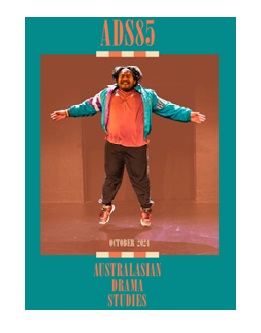 Australasian Drama Studies
Australasian Drama Studies
Issue 85| October 2024
- Issue 85 (Full Issue PDF)
- Contents
- Editorial
- Karakia in Rehearsal: A Reflection on Indigenous Praxis Fran Kewene
This article is a short reflective piece which explores a personal approach to using a Māori ritual called karakia. This reflection explores the importance of karakia as a culturally responsive theatre praxis and an act of decolonising and embodied love within the context of the rehearsal process in Aotearoa New Zealand. Told using a personal story of grief and loss, this reflection introduces the reader to: the whakapapa of karakia, and how karakia is used in Marae Theatre in Aotearoa New Zealand. It also provides examples of karakia used in theatre praxis and concludes with a challenge to the reader to explore their own biases before including karakia authentically into their own theatre praxis.
Keywords
Decolonisation, karakia, Māori theatre, rehearsal, praxis
- The Waka of Love: Decolonial Anti-Racist Praxis of Aro Ki Te Hā led by, with and for Indigenous Kids in Aotearoa
This article describes The Waka of Love, a Theatre Marae-informed stage production situated within a Kaupapa Māori research project examining impacts of racism on mokopuna Māori in Aotearoa. Underpinned by ethical co-designing – an approach aligned with Indigenous rights that emphasises power-sharing, accountability and positive transformation – and through wānanga-based creative participatory inquiry grounded in Te Ao Māori, mokopuna Māori collaborated to address racism and its impacts on hauora. The Waka of Love serves to illustrate decolonial anti-racist praxis that challenges colonial knowledge systems through empowerment of mātauranga Māori and whakamoemoeā for mokopuna Māori. Central to The Waka of Love is that of aro ki te hā – the sacred reverence for the breath – fostering deep interconnectedness, compassion, empathy, and respect for oneself, one another, Papatūānuku, and the universe. The Waka of Love underscores decolonial anti-racist
efforts toward liberation, enabling the flourishing of mātauranga and hauora for mokopuna Māori, their whānau and communities.
Keywords
Love, Indigenous, Māori, decolonial, racism
- Seeing Yourself to See Others: The Importance of Critical Love in Work with Marginalised Communities
This article discusses the unintended harm that Applied Theatre practitioners can inflict on their participants due to their unconscious biases and assumptions. The author argues that this is the result of ‘fake love’, wherein practitioners only centre the vulnerabilities and experiences of their participants while neglecting how they participate in broader systemic issues. The article proposes a shift from ‘fake love’ to ‘Critical Love’, which requires practitioners to engage in a critical and deep self-reflection on their own biases, privileges, and the power dynamics they bring to the room. The author provides examples of her own critical self-reflection and how these may affect participants, and she encourages practitioners to do the same. Through Critical Love, the article argues, practitioners can foster more authentic and empowering relationships with participants, which has the potential to drive real social change and justice within Applied Theatre practice and beyond.
Keywords
Critical Love, Applied Theatre, facilitation
- Performing Compassion/Performing Aroha in Learning Disabled Theatre
In 2023, eight learning disabled performers from Different Light Theatre collaborated with eighteen drama school students from NASDA (National Academy of Singing and Dramatic Art) in Christchurch on a production of Faust.Us based on Marlowe’s
text. The framing principles of the process were intended to be whanaungatanga (kinship and belonging), kotahitanga (unity) and, particularly, manaakitanga (hospitality) in which the non-disabled staff and students would afford support for the learning disabled performers. However, the emotional and theatrical outcome of this process was a profound reversal of this ‘economy of affection’ in the collaboration and the performance. It was in fact the support of the learning disabled actors for their non-disabled colleagues that proved invaluable and unshakeable. While in inclusive theatre we might assume that the performance of compassion would be for the benefit of the learning disabled actors, this flipping of the script had real power to hit everyone in the guts.
Keywords
Learning disability, inclusion, radical compassion, manaakitanga
- ‘Approaching with Alofa’: Transforming Acting Spaces for BIPOC Creatives
This talanoa (conversation) between final year PhD candidate Sepelini Mua’au (Levī-Saleīmoa & Matāutu Falelātai) and Nicola Hyland (Te Ati-Haunui-a-Pāpārangi/Ngāti Hauiti) explores the ‘why’ of Sepe’s project that centres around decolonising frameworks and Theatre in Aotearoa. Exploring the whakapapa of this research, Sepe speaks to his upbringing as a second-generation, New Zealand-born Samoan and delves into key moments in his creative journey as an actor, writer, director and theatre-maker. The talanoa questions historical institutions with colonial foundations to encourage conversations around decolonised ways of working as a BIPOC (Black, Indigenous, Person of Colour) creative in Aotearoa. What does approaching rehearsal spaces with alofa/aroha mean for BIPOC creatives? This talanoa acknowledges Sepe’s experiences within the Samoan concept of the vā, which centres around the formation and maintenance of meaningful relationships with people, and. in this instance, Sepe’s creative practice.
Keywords
Decolonial, BIPOC, actor training, Pasifika
- Indigenous Performances of Love beyond Settler Recognition in Vigil and The Unnatural and Accidental Women
The proliferation of the discourse of recognition in state politics is, as many anti-colonial scholars have argued, a form of governmentality in settler colonial nations. How does love among the colonised disrupt colonial recognition? What learnings do we gain when we theorise acts of decentering colonial recognition in terms of love? This article explores these questions through Anishinaabe artist Rebecca Belmore’s performance Vigil, and Métis playwright Marie Clements’ play The Unnatural and Accidental Women from northern Turtle Island (Canada). The article theorises love as an insurgence against what Dylan Robinson calls ‘perceptual logics of settler colonialism’.
Keywords
Recognition, Canada, love, MMIW (Missing and Murdered Indigenous Women), performance
- Adaraye Aragalaya (Struggle for Love): Sri Lanka’s ‘Occupy’ Moment, Plural Political Enactments, and the End of the Rajapaksas
The article explores how Aragalaya embodies Judith Butler’s concept of plural performativity as a call for justice and rejection of precarity. This unique Sri Lankan socio-political movement, often called ‘Adaraye Aragalaya’ (struggle for love), reflects its non-violent ethos and practice of inclusivity. In April 2022, groups of young people occupied the Galle Face promenade beside the Presidential Secretariat building in Colombo to demand that the Sri Lankan President, Gotabaya Rajapaksa, resign. Butler suggests that when masses occupy public spaces to protest, exercising their ‘plural and performative right to appear’, the gatherings embody ‘plural performativity’, and the bodies enact ‘political meanings’. The article features an
analysis of three artists’ performances: a trans woman, a man who carried a large wooden cross, demanding justice for the victims of the 2019 Easter bombings, and a performer who painted his body red to commemorate the 1983 Black July massacre victims.
Keywords
Sri Lanka, Aragalaya, plural performativity, Judith Butler, non-violent protest
- Wellbeing in the Performance of Morally Questionable Characters: Enacting Love and Compassion for Human Woundedness
The Healthy Conservatoires (UK), covering drama, music and dance training institutions, has included the spiritual (defined as ‘exploring beliefs, values and ethics and creating a sense of purpose and meaning in life’) as one of eight key dimensions in its online wellbeing framework. Yet few drama schools have formally incorporated considerations of moral and spiritual development as part of their curriculum. In 2020, interviews with nine professional actors documented the impacts of playing a villain or other amorally inclined characters. The study found that three factors can impact actors’ personal and relational wellbeing in enacting such characters: 1. the requirements of empathy in the creation and performance of character; 2. the potentiality of moral distress and injury in the creation and performance of character; and 3. the shaping of intrinsic and extrinsic values during professional identity formation. Love and compassion for human woundedness needs to be honoured in drama schools.
Keywords
Actor training, moral injury, spirituality, intrinsic values, wellbeing
- Hine’s Monologue Delivered to Her Husband Talite at His Tangihanga, on the Eve of the Poroporoaki
Hine’s Monologue is a poroporoaki to her late husband Talite, as she comes to terms with his passing after the unfortunate collapse of their marriage. Despite enduring love, the obstacles they faced together in the form of personal challenges exacerbated by societal inequities and mandates from church authorities undermined their ability to live in love. Hine’s monologue is a call to whānau and community to better support young, brown couples and their families, and a reminder that the kupu aroha is both tūingoa (noun) and tūmahi (verb); in equal parts a nameable thing, a destination, an action, state, and condition. Hine’s monologue, performed by Erina Daniels and Emma Katene, was one of six monologues woven together under the title ONO and presented at both Tahi Festival 2023, Wellington and Koanga Festival 2023, Auckland.
Keywords
Aroha, Māui, Whānau, Church, Poroporoaki
- Contributors
Issue 84
Wed, 24 Apr 2024Printable version

Australasian Drama Studies
Issue 84| April 2024
Table of Contents
- Issue 084 (Full Issue PDF)
- Contents
- Editorial
- ‘Poor Gaels Are Tormented, Troubled and in Sorry Plight’: Reimagining an Anti-Colonial Irish Performance Tradition Through the Voices of Australian Female Convicts – Melita Rowston
- Witnessing Touch in Theatre-Making Processes: Exploring Agency for ‘Witness-Participants’ of Staged Intimacy and Violence – Susan Fenty Studham and Gabrielle Metcalf
- His Book, Her Play: Kate Mulvany’s Adaptations of Masquerade and Jasper Jones – David Simes
- The Audience as Social Collective: The Role of Intra-Audience Interaction in the Communication of Narrative in Immersive Theatre – Melissa Herburg
- The Rough and the Tumble: Queer Themes in Robert Lord’s Plays – Chris Brickell
- ‘Hello Person That Is Me’: Voices of Regional Youth in Playwriting Projects – David Megarrity, Jenna Gillett-Swan and Maisie Crosdale
- Embedding Indigenous Perspectives within Actor Training: An Account of Inclusive Teaching Practices – Andrea L. Moor and Nicole Reilly
- The Flower and the Frame: On Transplanting an Heirloom Play into Fresh Ground – Jane Woollard and Peta Murray
- Imaging People Who Use Drugs: How Parliamentary Actors Picture and Tell Stories about the Subjects of Drug Law Reform – Sean Mulcahy and Kate Seear
- Remember My Name: The Critical Role of ‘Selves’ in Transformative Acting – Suzie J. Jarmain
- Bodies of Truth: Considering the Ethics of Physical Dramaturgy in Documentary Theatre – Missy Mooney
- Waltzing Around the Veranda: Reclaiming the Dandy in Australian Bush Drama – Matthew Bapty
- Review
- Contributors
Issue 83
Wed, 20 Dec 2023Printable version
Australasian Drama Studies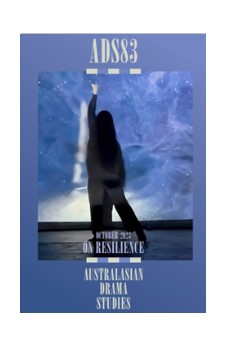
Issue 83| October 2023
Table of Contents
- Issue 083 (Full Issue PDF)
- Contents
- Editorial
- Performing Arts and the Climate Emergency: Horizon-Scanning the Futures of Practice and Scholarship Susanne Thurow, Helena Grehan and Jane Davidson
- The Myth of the Resilient Artist: Goodwill and In-Kind Contribution in the Performing Arts Sector Rea Dennis and Katy Maudlin
- Pivoting ‘Resilience’: Australian Women Playwrights, Community and the COVID-19 Crisis Rebecca Clode and Julieanne Lamond
- Performing Precarity and Transilience Rand Hazou
- Femme Queen Energy: Community as Protest and Embodied Transfeminine Resistance in Vogue Ballroom Tristan Niemi
- Digital Dance Practices: A Model for New Mobility in Performing Arts Rebecca Weber
- The Brink: Receptive Generosity and Kindness in the Development of a Choreographic Pedagogy of Consent for Actor Training Samantha Chester and Renée Newman
- Emotional Aesthetic(s): Re:orienting Desires Joanna Cook
- In the Ruins of the Future: The Role of the Creative Artist in a Time of ‘Thin’ Belief Julian Meyrick
- Reviews
- Contributors
Issue 82
Fri, 23 Jun 2023Printable version
Australasian Drama Studies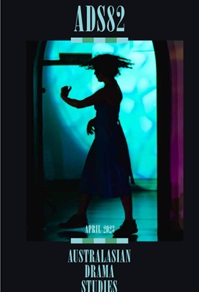
Issue 82 | April 2023
Table of Contents
- Issue 082 (Full Issue PDF)
- Contents
- Editorial
- Provocation #1: Why I Make Theatre: For Now – A Theatre of the Everyday Raimondo Cortese
- Performance Improvisation: No Former Performer Has Performed This Performance Before and the Aesthetics of Play Rea Dennis, Penny Baron, Carolyn Hanna
- ‘Brave Space’: Investigating Consent and Boundaries as a Framework for Culturally Safe Collaborative Arts Practice Sarah Austin, Isabella Vadiveloo
- The 1948 Old Vic Tour: Viv and Larry Down Under Chris Hay
- A Workshop in Process: The Playwrights Workshop in Aotearoa Murray Edmond
- The 25th Anniversary Tour of Krishnan’s Dairy: Touring Aotearoa New Zealand during the COVID-19 Pandemic James Wenley .
- Navigating the Staging of Richard Brome’s ‘Comic Therapy’ in The Sparagus Garden Kim Durban
- Our Own Time and Space: Locating Autistic Poetics in Theatre Sarah Wilson
- A Playwright in Exile: Mammad Aidani Russell Fewster
- Provocation #2 Brisbane Festival’s Hyperlocal Hope: The Dramaturgical Feat of Live and In-Person Programming During COVID-19 Hannah-Leigh Mason
- Reviews
- Contributors
Issue 81
Fri, 18 Nov 2022Printable version
Australasian Drama Studies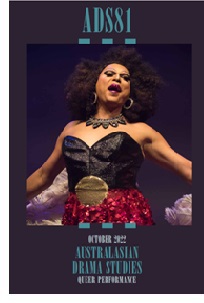
Issue 81 | October 2022
Table of Contents
- Issue 081 (Full Issue PDF)
- Contents
- Editorial: Queer Performance Jonathan Bollen , Alyson Campbelland, Liza-Mare Syron
- Koori Gras: A radical celebration of sparkling defiance – Liza-Mare Syron
- An HIV love story: Jacob Boehme’s Blood on the Dance Floor’s queer and Indigenous revolt – Jacob Boehme, Alyson Campbell and Jonathan Graffam
- Tracing Transitions – Stace Callaghan and Leah Mercer
- A Queer Performance New Wave in Sydney: Inside Club Bent 1995-1998–exploring hybridity and community – Catherine Fargher
- The Future is Now: Queer Utopian Longing and the Utopian Performative in Today x Future in Metro Manila – Ian Rafael Ramirez
- “Show me how you do it down under”: Realness at The West Ball II and the translation of vogue ballroom in Australia – Billy Kanafani
- Theatre as a Space of Resistance and Protest: Queer Politics and Colour of Trans 2.0 – Neethu Das. K and Vellikkeel Raghavan
- “We’ll meet you underground”: transcultural performance practices in queer space and time – Jeremy Neideck, Nathan Stoneham, Younghee Park, and M’ck McKeague
- Birds of A Feather: On Queerness, Performance, The Coming Back Out Ball, and LGBTIQ+ Elders Dance Club – Peta Murray, Adelaide Rief, Marnie Badham, Tristan Meecham, Bec Reid, Lenine Bourke
- A Rainbow in the Age of Covid: Contemporary Queer Theatre in Aotearoa – James Wenley and Nathan Joe
- Reviews
- Contributors
- test
Issue 80
Thu, 2 Jun 2022Printable version
Australasian Drama Studies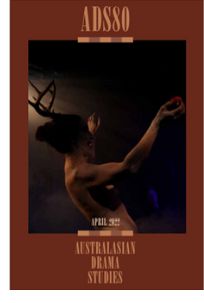
Issue 80 | April 2022
Table of Contents
- Issue 080 (Full Issue PDF)
- Contents
- Editorial Yoni Prior
- Looking Forwards to the 1950s: Utilising the Concept of Hauntology to Investigate Australian Theatre History Julian Meyrick
- Before Neo-Burlesque, There Was Queer Cabaret: Revisiting Queer Performances from Melbourne in the 1990s Maude Davey
- Shadows of the Australian Performing Arts Ecology Görkem Acaroğlu
- ‘Time’s Up, Motherf*%ker’: Emasculation and Restaging Justice for Women in Aotearoa New Zealand Nicola Hyland
- The Use of Irony in Pākehā Performance Adriann Smith
- Director/Mother/Outlaw Katy Maudlin
- Traversing the Proscenium: Audience Enworlding in Musical Theatre Stuart Grant, Narelle Yeo and Melissa Fenton
- ‘What Do You Mean We Aren’t Performing Shakespeare?’: A Contemporary, Devised Performance Curriculum at a Regional Australian University Gillian Arrighi, Clare Irvine, Brian Joyce and Carine
- Between Freedom and Control: A Chorus-Centred Bakkhai for Community Ensemble Vahri McKenzie
- Driving “Transformational change”: using ecodramaturgy to develop a more sustainable theatre ecosystem Dr Saffron Benner
- Oppression and allyship in Australia’s Deaf Arts. Racheal Missingham and Bree Hadley
- Reviews
- Contributors
Issue 79
Mon, 20 Dec 2021Printable version
Australasian Drama Studies
Issue 79 | December 2021
Table of Contents
- Issue 079 (Full Issue PDF)
- Contents
- Editorial Pia Johnson and Miles O’Neil
- A Conversation Between Performance Photographers Brett Boardman and Jeff Busby, with Notes by Heidrun Lohr Pia Johnson
- The Intimate and the Epic in Plunge: A Writer-Director’s Approach to Heterarchical Composition Kate Shearer
- A Performative Investigation of the Agency of Sound: Mapping the Sound/ Soundscape Portrait Angela Viora
- ‘Where’s the AV Guy?’: A Conversation with Rhian Hinkley, Margie Medlin and Nick Roux Yoni Prior
- Seed Value: Collaboration and Creative Development in Composed Theatre David Megarrity
- Siren Song: Strengthening Community through Sonic Insurgency Miles O’Neil
- Towards a Post-Pandemics of Sound in Performance Chris Wenn
- Liveness in the Digital Age: Performance Case Studies Russell Fewster, Geordie Brookman and Richard Chew
- Authenticity within Digital Performance: A New Framework to Understand the Relationship between Audience, Vision Technology and Scenography Tessa Rixon, Gene Moyle, Steph Hutchison and Joslin
- A Feminist Lens in the Rehearsal Room: On the Bodily Education of Young Girls Pia Johnson in conversation with Adena Jacobs
- Genealogies of Darkness Paul Jackson
- A Sound Conversation: Performance-Makers and Sound Practices with Roslyn Oades, Madeleine Flynn and Tamara Saulwick Kate Hunter
- Reviews
- Contributors
Issue 78
Thu, 27 May 2021Printable version
Australasian Drama Studies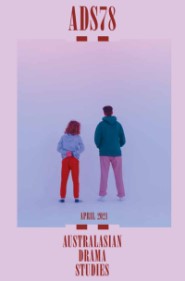
Issue 78 | April 2021
Table of Contents
- Issue 078 (Full Issue PDF)
- Contents
- Editorial Yoni Prior
- Staging Music in Shakespeare Richard Fotheringham
- From Bejewelled Crucifix to Modern Dress: ‘Shakespeare and Stage Costume’ from Wilkie to Bell Rachel Fensham
- Visualising the Story of Theatre in Sydney: Venues, Repertoire and Change, 1920–2020 Jonathan Bollen
- The Guthrie Report and Its Discontents Chris Hay
- Recognising the Face of Australian Theatre: Authentic Diversity and the Case of Metanoia Glenn D’Cruz in interview with Görkem Acaroğlu, Shane Grant and Greg Ulfan
- ‘It Caught the Zeitgeist’: Interview with Andrew Bovell Nathan Hastie
- ‘Sustained Personal Contact’: Recent Australian Productions on Tour in China Anne Pender
- What Are The Ties That Hold Us Together? The Smartphone Networks in As If No One Is Watching and Body of Knowledge Abbie Victoria Trott
- Reviews
- Contributors
Issue 77
Wed, 20 Jan 2021Printable version
Australasian Drama Studies
Issue 77 | January 2021
Table of Contents
- Issue 077 (Full Issue PDF)
- Contents
- Editorial: Regional Theatre in Australia Jennifer Beckett, Rachel Fensham and Paul Rae
- Passionate, Not Parochial: Local Theatre in Launceston Asher Warren and Jane Woollard
- Flexible Theatrics in Early Goldfields Ballarat Ailsa Brackley du Bois
- The Suitcase Royale: Sonic Explorations of Gothic Victorian Towns Miles O’Neil
- A Community of Producers: A Conversation about Vocabulary, Weather, Creative Problem-Cracking, Distance and Performance in Regional Western Australia Chloe Flockhart and Paul McPhail
- A Gym for Empathy: A Conversation about Regional Migrant Stories, Theatre and the Banquet of Life Elena Carapetis and Anthony Peluso
- The Anchor, the Centre, the Shelter, the Dwelling: A Conversation about Contemporary Theatre Practice in Regional Australia Jude Anderson and Joe Toohey
- That Very Specific Place: A Regional Australian Theatre Conversation Ros Abercrombie, Paul McPhail, Anthony Peluso and Joe Toohey
- The Economic Aesthetics of Three Regional, Unpaid-Led Theatre-Producing Companies Anna Loewendahl
- Ariel Songs: Performing Cultural Ecologies of Ballarat Angela Campbell, Tanja Beer, Richard Chew and Kim Durban
- ‘It Was a Cracker’: Listening in to Youth Audiences, Regional and Urban, with Show Reports Abbie Victoria Trott
- Desert Stages: The Place of Theatre in the Barkly Region’s Creative Ecology Sarah Woodland and Brydie-Leigh Bartleet
- ‘Dreaming, It Is Like Breathing Air’ Edwin Lee Mulligan and Dalisa Pigram Ross
- Shared Bodies: Dramaturgies of/for Listening and Hearing Angela Conquet
- Reviews
- Contributors
Issue 76
Thu, 28 May 2020Printable version
Australasian Drama Studies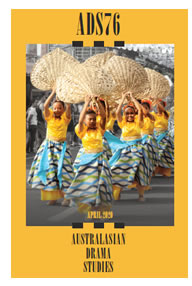
Issue 76 | April 2020
Table of Contents
- Issue 076 (Full Issue PDF)
- Abstracts
- Editorial Yoni Prior
- Dancing, Marching and Baton Twirling with the Virgin: Performing Community at the Peñafrancia Festival in the Philippines William Peterson
- Festivals, Funerals and Circuses: The Impact of Space and Design in the Construction of Meaning and Audience Experience Natalie Lazaroo and Jennifer Penton
- Polyfest Postponed: Performing ‘Us’ in Christchurch in 2019 Tony McCaffrey
- Disciplined Subjects and Social Performance: Entertainments at the Fremantle Lunatic Asylum, 1873–1906 Jonathan W. Marshall
- Wassailing and Festive Music in Shakespeare’s Twelfth Night Kathryn Roberts Parker
- Local Archive, Distant Reading: Performance Space at Cleveland Street and Carriageworks Caroline Wake and Boni Cairncross
- Enacting Restorative Justice: Shakespeare and Tikanga Māori in Cellfish (2017) Rand Hazou
- Hold On: Australian Innovations in Access Aesthetics Madeleine Little, Sarah Austin and Eddie Paterson
- Contemporary Performance and Climate Change: Re-defining the Australian Landscape Narrative Linda Hassall
- Celebrating Fifty Years in Prague: Reflections on Australian Scenographic Identity through the Prague Quadrennial of Performance Design and Space Tessa Rixon and Sarah Winter
- Entanglements with Time: Staging Duration and Repetition in the Theatre Deborah Pollard
- An Actress Weeps: Corporeal Dissonance in the Actor’s Experience of Performing Testimony in Eduardo Coutinho’s Jogo de Cena Rea Dennis
- Shifting Hybridity: An Intercultural Arab–Australian Shadow Theatre Performance Lynne Kent
- Review
- Contributors
Issue 75
Wed, 18 Dec 2019Printable version
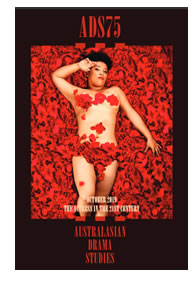 Australasian Drama Studies
Australasian Drama Studies
Issue 75 | December 2019
Table of Contents
- Issue 075 (Full Issue PDF)
- Editorial: The Actress in the 21st Century Mary Luckhurst
- Woman as Subject: Critical Perspectives of Australian Commercially Successful Plays with Leading Roles for Female Actresses Margaret Haining and Caroline Heim
- Interview with Candy Bowers – Intersectionality and the Australian Theatre Industry Sarah French
- Nicole Kidman: Transformation and the Business of Acting Mary Luckhurst
- Interview with Zoe Coombs Marr Miles O’Neil
- Vanishing Acts: The Actress and the Archibald Prize Fiona Gregory
- Interview with Julie Forsyth – Career Visibility: ‘You Need Someone Who Sees You’ Yoni Prior
- Performing Technical Innovation: The Pioneering Audio Work of Tamara Saulwick Miles O’Neil
- Interview with Margi Brown Ash – Finding Balance: Mental Health, Wellbeing and Female Performers Lynne Bradley
- Cross-Gender Playing Techniques: Actresses and Innovation in the Portrayal of Female Jingju (Beijing /Peking Opera) Roles Megan Evans
- Interview with Yoni Prior Miles O’Neil
- Musical Theatre and Australian Leading Ladies: Legacies of the Past and Current Challenges – ‘How Lucky We Are to Be Alive Right Now’ Trevor Jones
- Playing with Extremes: The Travelling Sisters and Contemporary Sketch Comedy Sarah Peters
- Reviews
- Contributors
Issue 74
Tue, 14 May 2019Printable version
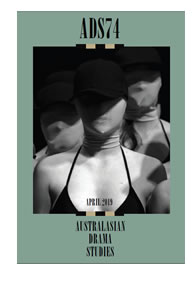 Australasian Drama Studies
Australasian Drama Studies
Issue 74 | April 2019
Table of Contents
- Issue 074 (Full Issue PDF)
- Editorial
- The NDIS and Disability Arts in Australia: Opportunities and Challenges Bree Hadley, Gerard Goggin et al
- Verbatim Theatre and a Dramaturgy of Belonging Sarah Peters
- A West End Celebrity Proselytises the Bonds of Empire: Seymour Hicks and Bruce Bairnsfather’s Old Bill in 1920s Australia Veronica Kelly
- Visions of Restorative Justice in Theatre, Theory and Practice Paul Dwyer, J.R. Martin and Michele Zappavigna
- Breathtaking Performance: a room with no air’s Exhaustive Aesthetics of Holocaust Memory Bryoni Trezise
- Playing the Edinburgh Lottery: Six Decades of New Zealand Theatre at the Edinburgh Festival Fringe James Wenley
- Toward an Ethical Practice: Child Performers in Contemporary Performance for Adult Audiences Sarah Austin
- Creating Feminine/ist Theatre: Écriture Féminine as a Framework for Directors Laura Hartnell
- Ranters: Rehearsal and Development Process – How Is the Text Enacted? Raimondo Cortese
- The Veil of Queer Aesthetics: Lindsay Kemp and the Subtext of Gay Desire in Oscar Wilde’s Salomé Gerrard Carter
- Reviews
- Contributors
Issue 73
Wed, 23 Jan 2019Printable version
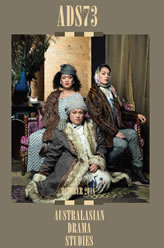 Australasian Drama Studies
Australasian Drama Studies
Issue 73 | October 2018
WARNING: Aboriginal and Torres Strait Islander readers are advised that the article Namatjira: Beyond the Script contains an image of a person who has died.
Table of Contents
- Issue 073 (Full Issue PDF)
- Editorial – Turangawaewae: A Place to Stand in Contemporary Indigenous Performance in Australasia and Beyond Nicola Hyland, Liza-Mare Syron and Maryrose Casey
- Foreword Anne Marshal
- The Hepatitis C Trilogy: A case for Indigenous theatre as a contemporary manifestation of traditional healing business. Blayne Welsh
- Shot Bro: A Theatrical Korero about Depression and Suicide in Aotearoa/ New Zealand Sally Richards
- Engaging with Local First Nations Communities through the Performing Arts Denise Wilson, Tandi Palmer Williams, Karilyn Brown and Liza-Mare Syron
- A Renaissance in Wellington Maori Theatre Tanemahuta Gray
- Transnational Connections: First Nations Conversations through Making Performance Liza-Mare Syron
- Namatjira: Beyond the Script – Visual and Performative Aesthetics as Conduits for the Communication of Western Aranda Ontology Susanne Thurow
- WOER WAYEPA – The Water Is Rising: A Torres Strait Islander Approach to Knowledge Mobilisation, and Saibaian Approach to Cultural Knowledge Transference to Performative Storytelling Margare
- Performances of Belonging Maryrose Casey
- A Conscious Un-couplet: Wahine Maori Stand Up to Shakespeare Nicola Hyland
- Choreographed Pasts: A Historiographic Inquiry into Australian and Indigenous Australian Concert Dance Luke Forbes
- Finding a Sense of Place in the Pacific Diaspora: Pasifika Performance in Aotearoa David O’Donnell
- The Whanau We Have Always Had: The Future Is Indigenous Hone Kouka
- Reviews
- Contributors
Issue 72
Sun, 1 Apr 2018Printable version
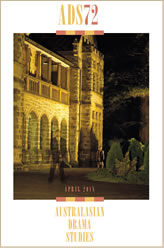 Australasian Drama Studies
Australasian Drama Studies
Issue 72 | April 2018
Table of Contents
- Issue 072 (Full Issue PDF)
- Editorial
Julian Meyrick, Yoni Prior, Meredith Rogers - Harry Lyons Is ‘Here, There and Everywhere’: Australia’s Late-19th-Century Global Entertainment Broker
Gillian Arrighi - A ‘Great Anti-War Play’: Bury the Dead on the World Stage
Lisa Milner - Landscapes as Graveyards: Spectral Return and Performativity in the Contested Landscape
Jonathon W. Marshall, Emily Duncan - Postcard from the Edge: Tom Holloway’s Beyond the Neck and the Limits of Verbatim
Caroline Wake - Diagrams of Influence: A Model for Charting Artistic Lineages
Melanie Beddie - The Precarious Lives of Actors
Ian Maxwell, Mark Seton, Marianna Szabó - 148 Weekly Ticket Footscray – A Fifteen-Year Audience
Merophie Carr - Divisive Dramaturgy: Community Engagement in Contemporary Mediated Publics
Asher Warren - Reviews
- Contributors
Issue 71
Sun, 1 Oct 2017Printable version
 October 2017
October 2017
Full Issue PDF
Contents
Editorial
Denise Varney and Sandra D’Urso
Before The Ham Funeral: ‘The YOUNG MAN Appears’ – John Tasker Returns Home
Laura Ginters
Modernist Drama Decried: Patrick White, Spoiled Identity, and Failure as a ‘Logic of Use’
Julian Meyrick
Robyn Nevin, Patrick White and the Art of the Modern in Australian Theatre
Anne Pender
Making Room for Modernism: The 1979 Sydney Theatre Company Production of Patrick White’s A Cheery Soul
Andrew Fuhrmann
Mayakovsky’s Hammer: Experimental Theatre as Romantic Modernism, Sydney, 1968–1970
Ian Maxwell
Eleanor Roosevelt: Theatrical Emotion for Political Benefit
Peta Tait
Recompositions: Images of Patrick White in William Yang’s My Generation
Edward Scheer and Helena Grehan
From Grotowski to Betty Can Jump
Kerry Dwyer
Transmitting Embodiment: Grotowski to Body Weather
Nicola Heywood
Reviews
RINA KIM,
Disability, Public Space Performance and Spectatorship: Unconscious Performers, by Bree Hadley;
ROBERT REID,
The Mill: Experiments in Theatre and Community, by Meredith Rogers;
PETA TAIT,
Performing Neurology: The Dramaturgy of Dr Jean-Martin Charcot, by Jonathan Marshall;
DAVID O’DONNELL,
Stanislavsky in the World: The System and Its Transformations Across Continents, by Jonathan Pitches and Stefan Aquilina;
LISA WARRINGTON,
Talanoa: Four Pacific Plays and Black Faggot and Other Plays, by Victor Rodger;
RAND HAZOU,
Theatre of Real People: Diverse Encounters at Berlin’s Hebbel am Ufer and Beyond, by Ulrike Garde and Meg Mumford
Contributors
Issue 70
Sat, 1 Apr 2017Printable version
April 2017
Full Issue PDF
Contents
Editorial Note
Meredith Rogers and Julian Meyrick
‘The Elasticity of Her Spirits’: Actresses and Resilience on the Nineteenth- Century Colonial Stage
Jane Woollard
'Chaos' and 'Convergence' on the Western Australian Goldfields: The Politics of Performance in the 1890s
William Dunstone and Helena Grehan
Black, White, and Red Faces: Race and Performance at NIDA
Christopher Hay
'A Rare Opportunity to Fail': STAB's Legacy of Theatrical Experimentation
Emma Willis
Performing Emotion to Remember a Pakeha Worldview
Adriann Smith
Hyperrealism and the Everyday: The Plays of Ranters Theatre
Raimondo Cortese
Dramaturgy of Mobility: Towards Crossover and Fusion in Out of the Ordinary
Maggie Ivanova and Alex Vickery-Howe
'Mad March' in the Festival City: Place-Making and Cultural Clash at Adelaide’s Festivals
Sarah Thomasson
Reviews
SALLY RICHARDS,
Caryl Churchill, by Mary Luckhurst;
MARYROSE CASEY,
Audienceas Performer:The Changing Role of Theatre Audiences in the Twenty-First Century, by Caroline Heim;
DAVID O'DONNELL,
Japanese Robot Culture:Performance, Imagination and Modernity, by Yuji Sone;
LISA WARRINGTON,
Best Playwriting Book Ever, by Roger Hall, plus Shift– three plays, by Alison Quigan, Vivienne Plumb & Lynda Chanwai-Earle, edited by David O'Donnell
Issue 69
Sat, 1 Oct 2016Printable version
October 2016
Full Issue PDF
Contents
Editorial Note
by Meredith Rogers, Mick Douglas and Bree Hadley
Performing Mobilities
Mick Douglas
Mobilising the Mobilities Paradigm in Drama, Theatre and Performance Studies: Potentials, Politics and Pitfalls
Bree Hadley
Moving ‘Misfits’
Kate Maguire-Rosier
Ship Inventory: Preparations Across Twelve Months
Amaara Raheem
Layne Waerea’s Public Laughter
Christopher Braddock
5 Short Blasts
Madeleine Flynn and Tim Humphrey
Migrant Mobilities: Cruel Optimism and the Case of A.J. D’Cruz
Glenn D’Cruz
Algorithmic Misfits
Ben Landau
Unsteady Belongings: Rethinking the Experience of Nation through Movement
Justine Shih Pearson
14 Thoughts about the Ghan – in the Shape of a Train
Meredith Rogers
Like Riding a Bicycle: Achieving Balance through Mobility in Site-Specific Performance – A Comparative Study of Railway Wonderland (2015)
by Northern Rivers Performing
Arts and Sir Don v The Ratpack (2009)
by Guerrilla Street Theatre Paul Davies
Reviews
SHARON MAZER,
Remaking Pacific Pasts: History, Memory, and Identity in Contemporary Theater from Oceania, by Diane Looser, and Places for Happiness: Community, Self, and Performance in the Philippines by William Peterson;
JONATHAN W. MARSHALL,
I Shudder to Think: Performance as Philosophy, by Margaret Cameron;
NICOLA HYLAND,
Here/Now: 8 Plays by Award-Winning NZ Playwrights, edited by David O’Donnell; LISA WARRINGTON, The FitzGerald Brothers’ Circus: Spectacle, Identity and Nationhood at the Australian Circus,by Gillian Arrighi;
EMMA WILLIS,
Despatch, by Angie Farrow; JANE WOOLLARD, Imagined Landscapes: Geovisualizing Australian Spatial Narratives, by Jane Stadler, Peta Mitchell and Stephen Carleton
Issue 68
Fri, 1 Apr 2016Printable version
April 2016
Full Issue PDFContents
Editorial Note
by Meredith Rogers
Screening Live Performance: Australia’s Major Theatre Companies In The Age Of Digital Transmission
by Richard Fotheringham
Top Girls ‘Down Under’
by Campion Decent
Theatre Animals: Sumner Locke Elliott’s Invisible Circus
by Anne Pender
The Sacrifice Of Oriel Gray (1920–2003): Australian Playwright
by Merrilee Moss.
Real Men At Play: Massive Company’s The Brave
by Rand Hazou
Applied Theatre Techniques For Community Workers – Towards A Performative And Anti-Oppressive Ethical Approach
by Athena Lathouras, Jo Loth And Dyann Ross
Acting In Verbatim Theatre: An Australian Case Study by Sarah Peters
Reinterpreting Passion: A Study Of Habib Tanvir’s Theatre
by Prateek
Reviews
Tom Gutteridge,
What a Body Can Do by Ben Spatz
D B Valentine,
Blackta by Nathaniel Martello-White
Amitabh Vikram Dwivedi,
Othello: Language and Writing by Laurie Maguire
Josey De Rossi,
Theatre and Migration by Emma Cox (Foreword by Peter Sellars)
Josey De Rossi,
Theatre and Time by David Wiles
Rand T Hazou,
Performing Digital: Multiple Perspectives on a Living Archive, edited by David Carlin and Laurene Vaughan
Kerryn Palmer,
Children of the Poor by Mervyn Thompson and Stage Adventures and Stage Adventures: Eight Classroom Plays, edited by David O’Donnell
James Wenley,
The Plays of Bruce Mason: A Survey by John Smythe.
Issue 67
Thu, 1 Oct 2015Printable version
October 2015
Full Issue PDFContents
Not Just 'Evocative': The Function of Music in Theatre
by Kim Baston
Music, Silence and the Single Note in the Creation of Meaning in Theatre
by Bagryana Popov
The Theatre of Dreams: Hypnotism and the Science of Historical Action
by Andrew Lawrence-King
Music and Sound Design: A Round Table Discussion with Anna Liebzeit, Kelly Ryall and Ian Moorhead with Kim Baston
Jethro Woodward in Interview with Kim Baston
Sound (Image, Text): Audiovisual Relationships in M+M with Daniel Schlusser, Darrin Verhagen and James Paul.
David N. Martin and the Post-War 'Acts and Actors' of Australian Variety
by Veronica Kelly
Reading and Performing Abjection: Staging Joyce, a Professional Reflection by Frances Devlin-Glass
Reviews
NICOLA HYLAND, Remaking Pacific Pasts: History, Memory, and Identity in Contemporary Theater from Oceania, by Diana Looser;
MARGARET HAMILTON, The Politics of Interweaving Performance Cultures: Beyond Postcolonialism, edited by Erika Fischer-Lichte, Torsten Jost and Saskya Iris Jain;
PRATEEK, Bertolt Brecht: A Literary Life, by Stephen Parker;
SHARON MAZER, The Routledge Companion to Puppetry and Material Performance, edited by Dassia N. Posner, Claudia Orenstein and John Bell;
ANNA KAMARALLI, Women on the Early Modern Stage, edited by Frances E. Dolan, Lucy Munro, Brian Gibbons and Arthur F. Kinney;
CATHERINE FARGHER, The Curious Incident of the Dog in the Night-Time, by Simon Stephens;
MERRILEE MOSS, Engine by Janis Balodis and House on Fire, by Debra Oswald
Issue 66
Wed, 1 Apr 2015Printable version
April 2015
Full Issue PDFContents
Australian Gothic Drama: Mapping a Nation’s Trauma from Convicts to the Stolen Generation
by Stephen Carleton
Andrew Bovell’s When the Rain Stops Falling: Theatre in the Age of ‘Hyperobjects’
by Mohebat Ahmadi
Patrick White and Aesthetic Modernism in Mid-Century Australia
by Denise Varney and Sandra D’Urso
Radical Adaptation: Hypertextuality, Feminism and Motherhood in The Rabble’s Frankenstein (After Mary Shelley)
by Sarah French
The Grotesque and the Gothic in Peter King’s John Gabriel Borkman: A Reflection from the Inside
by Jim Daly
A Thousand Hills: Responding to the Ethical Nightmare
by Emma Willis
Performing Cultural Heritage: Authenticity and the Spirit of Rebellion
by Angela Campbell
Performing Haunting Histories: A Psychogeographical Reading of Two Site-Specific Performance Projects on Rottnest Island
by Hannah Böttcher and Alexandra Ludewig
Community Engagement or Community Conversation?: Boomtown, a Large-Scale Regional, Outdoor Community Theatrical Event
by Danielle Carter and Caroline Heim
The Castanet Club: History, Provenance and Influence
by Terence Crawford
Reviews
JAMES MCKINNON, Theatre’s Heterotopias: Performance and the Cultural Politics of Space, by Joanne Tompkins;
KAREN KARTOMI THOMAS, Performativity and Event in 1960s Japan: City, Body, Memory, by Peter Eckersall;
EMMA WILLIS, Visions and Revisions: Performance, Memory, Trauma, edited by Bryoni Trezise and Caroline Wake;
D.B. VALENTINE, Staging Asylum: Contemporary Australian Plays About Refugees, edited by Emma Cox;
NICOLA HYLAND, Theatricality, Dark Tourism and Ethical Spectatorship: Absent Others, by Emma Willis;
SALLY RICHARDS, International Women Stage Directors, edited by Anne Fliotsos and Wendy Vierow;
LINDSAY ANN REID, Women in Shakespeare: A Dictionary, by Alison Findlay;
SARAH PETERS, Shafana and Aunt Sarrinah: Soft Revolution, by Alana Valentine;
HILARY HALBA, Don’t Mention Casablanca, by Michelanne Forster;
EMMA WILLIS, Falling and Other Short Plays, by Angie Farrow;
STUART YOUNG, Then It Was Now Again: Selected Critical Writings, by Murray Edmond
Issue 65
Wed, 1 Oct 2014Printable version
October 2014
Contents
Introduction
Russell Fewster
Staging David Hicks
Richard Jordan
Digital Alchemy: The Posthuman Drama of Adam J.A. Cass's
I Love You, Bro
Jodie Mcneilly
A Phenomenology of Chunky Move's GLOW: Moves Toward
a Digital Dramaturgy
Lara Stevens
Alienation in the Information Age: Wafaa Bilal's Domestic Tension
Suzanne Kersten, David Pledger, Julian Rickert, Tamara Saulwick and Hellen Sky with Gorkem Acaroglu and Glenn D'Cruz
Working with Technology/Making Technology Work: a Round Table Discussion
Robert Walton
Bewildering Behaviour: Practice as Research for Audiences and
Other Creators of Immersive Performance
Robin Deacon
White Balance: a History of Video
Yoni Prior
Impossible Triangles: Flat Actors in Telematic Theatre
Asher Warren
Mixed Actor Network Reality: a Performance in Three Networks
Susan Broadhurst
Theorising Performance and Technology:
Aesthetic and Neuroaesthetic Approaches
Gorkem Acaroglu
Cyborg Presence in Narrative Theatre
Yuji Sone
Imaginary Warriors: Fighting Robots in Japanese Popular Entertainment Performance
Glenn D'Cruz
6 Things I Know About Geminoid F, or What I Think About
When I Think About Android Theatre
Gorkem Acaroglu
Sayonara Interviews: Android–Human Theatre
Reviews
VERONICA KELLY, Circus and Stage: The Theatrical Adventures of Rose Edouin and G.B.W. Lewis, by Mimi Colligan;
PAUL MONAGHAN, Postdramatic Theatre and the Political, edited by Karen Jürs-Munby, Jerome Carroll and Steve Giles;
NICOLA HYLAND, Enacting Nature: Ecocritical Perspectives on Indigenous Performance, edited by Birgit Dawes and Marc Maufort;
FIONA GREGORY, Rhythm and Meaning in Shakespeare: A Guide for Readers and Actors, by Peter Groves;
CHRIS HAY, Teaching Shakespeare and Marlowe: Learning Versus the System, by Liam E. Semler; and
KATH BICKNELL, The Audience Experience: A Critical Analysis of Audiences in the Performing Arts, edited by Jennifer Radbourne, Hilary Glow and Katya Johanson.
Issue 64
Tue, 1 Apr 2014Printable version
April 2014
Full Issue PDFContents
Meredith Rogers and Julian Meyrick
Introduction
Helen Thomson
Obituary for GJM
Geoffrey Milne
Australian Theatre in the 1980s: Trends and Movements
Robert Reid
A City This Size Should Have So Many Theatres: The Church Theatre, 1983–1989
Paul Davies
Dramatic Tales Stir the Suburbs: Melbourne's Location Theatre Movement, 1979–1990
Meredith Roger
At Home with The Mill: Democratic Theatre-Making in Geelong, 1978–1984
Jane Mullett
Australian New Circus in the 1980s
Peter Eckersall (Moderator) with Russell Walsh, Suzanne Chaundy, Peter King, Patricia Cornelius, Bob Pavlich, John Ellis
Round Table on Theatre in Melbourne in the 1980s
Julian Meyrick
The Logic of Culture: The Fate of Alternative Theatre in the Post-Whitlam Period
Glenn d'Cruz
The Man Who Mistook Marat for Sade: 'Living' Memory and the Video Archive
Alison Richards
Your History: Manning Clark's A History of Australia and the End of the New Wave
Gillian Arrighi
Towards a Cultural History of Community Circus in Australia
Rebekah Woodward-Hanna
A Patchwork of Participation: Wan Smolbag Theatre's 'Big Plays' in Vanuatu
Natalie Lazaroo
We're Off to See the Wizard of Auslan: Translating Deaf Experience Through Community Performance
Jonathan Bollen
From The Silver Lining to The Roaring Days!: Amateur Theatre and Social Class in Broken Hill, 1940s–1960s
Murray Couch
Sex, Gender and the Industrial: Plays Performed by Broken Hill Repertory Society, 1945–1969
Chris Wenn
How I Heard: The 'Phenomenarchaeology' of Performance
Reviews
HELENA GREHAN, Theatre and Performance in the Asia-Pacific: Regional Modernities in the Global Era, by Denise Varney, Peter Eckersall, Chris Hudson and Barbara Hatley;
ANDRÉ BASTIAN, Telling Stories: Aboriginal Australian and Torres Strait Islander Performance, by Maryrose Casey, with an Afterword by Liza-Mare Syron;
KIM BASTON, 'We're People Who Do Shows': Back To Back Theatre: Performance Politics Visibility, edited by Helena Grehan and Peter Eckersall;
KAREN KARTOMI THOMAS, Performance, Popular Culture, and Piety in Muslim Southeast Asia, edited by Timothy P. Daniels;
FELIX NOBIS, The Twentieth-Century Performance Reader, 3rd edn, edited by Teresa Bradshaw and Noel Witts;
MERRILEE MOSS, Transparency, by Suzie Miller, Kelly, by Matthew Ryan, and Cyberbile and Grounded, by Alana Valentine;
LISA WARRINGTON, Downfall: Three New Zealand History Plays, by Michelanne Forster, and Playmarket 40: 40 Years of Playwriting in New Zealand, edited by Laurie Atkinson, and David O'Donnell:
RAND T. HAZOU, Rebellious Mirrors: Community-Based Theatre in Aotearoa/New Zealand, by Paul Maunder;
DAVID O'DONNELL, Me & Robert McKee, by Greg McGee;
EMMA WILLIS, Three Plays: Robert Lord, edited by Philip Mann;
DAVID O'DONNELL, Twenty New Zealand Playwrights, by Michelanne Forster and Vivienne Plumb
Issue 63
Tue, 1 Oct 2013Printable version
October 2013
Table of Contents
- Issue 063 (Full Issue PDF)
- Introduction
- Viewing The Burlesque Hour: The Pleasures of the Masochistic Gaze SARAH FRENCH and GEORGIE BOUCHER
- Skirting Burlesque SHARON MAZER
- ‘Very Scanty Covering for the Chocolate Body’: The Art of Burlesque and the Fijian Cricket Team in Australia, 1907–1908 NICOLE ANAE
- Show Girls and the Choreographers in Australian Entertainment: The Transition to Nightclubs, 1946–1967 JONATHAN BOLLEN
- Eat, Pray, Laugh!: Barry Humphries, Reg Livermore and Cross-dressed Australian Burlesque ANNE PENDER
- Burlesque Costuming and Sensationalist Circus Animal Acts PETA TAIT
- Trickster-infused Burlesque: Gender Play in the Betwixt and Between TERRIE WADDELL
- DIY Australian New Burlesque in the 2000s: An Interview with Madam P. ROSEMARY FARRELL
- Creating Cultural Heat in The Burlesque Hour: An Interview with Moira Finucane SARAH FRENCH
- Review;Scrapbooks, Snapshots and Memorabilia: Hidden Archives of Performance [Book Review] GLENN D’CRUZ
- Review: Not Magic But Work: An Ethnographic Account of a Rehearsal Process [Book Review] LAURA GINTERS
- Review: No Nudity, Weapons or Naked Flames: Monologues for Drama Students [Book Review] JOANNA WINCHESTER
- Review:Hamlet’s Dreams: The Robben Island Shakespeare [Book Review] MARGARET HAMILTON
- Review: Stanislavski: The Basics [Book Review] PAUL MAUNDER
- Review: Plays 2: London Calling [Book Review] DAVID O’DONNELL
Issue 62
Mon, 1 Apr 2013Printable version
April 2013
Issue 61
Mon, 1 Oct 2012Printable version
Australasian Drama Studies
Issue 61, October 2012
Design, space and performance: Introduction
Image gallery
Inside the black margin: An essay in words and images
Image gallery
Practitioners' round table: Australian theatre design - past, present and futur
Image gallery
Scenography from the inside
Image gallery
Drawn to the light: The freehand drawing from the dramatic text as an illumination of the theatre designer's eye of the mind
Image gallery
The Prague quadrennial: Repositioning design for performance
Image gallery
Re-viewing the PQ: Responses to the 2011 Prague quadrennial of performance design and space
Image gallery
Table of Contents
- Issue 061(Full Issue PDF)
- Design, space and performance: Introduction FILMER, ANDREW; HECKENBERG, MIRANDA
- Inside the black margin: An essay in words and images TRUBRIDGE, SAM
- Re-imagining suburbia with my darling patricia FILMER, ANDREW
- Practitioners' round table: Australian theatre design - past, present and future HECKENBERG, MIRANDA; BACON, SEAN; BRITTON, CLARE; MYERS, RALPH; ROSS, IMOGEN; SCHLIEPER, NICK
- Scenography from the inside D'ARCY, EAMON
- Drawn to the light: The freehand drawing from the dramatic text as an illumination of the theatre designer's eye of the mind FIELD, SUE
- 'Uncertain work': Designing through collective processes in the devising of version 1.0's the table of knowledge HECKENBERG, MIRANDA
- The Prague quadrennial: Repositioning design for performance REWA, NATALIE
- Re-viewing the PQ: Responses to the 2011 Prague quadrennial of performance design and space ILMER, ANDREW; HANN, RACHEL; GAZZOLA, PAUL; SCOTT-MITCHELL, MICHAEL; SPURR, SAM
- Review: The Cambridge introduction to scenography FEWSTER, RUSSELL
- Review: An introduction to theatre design LEADER, KATHRYN
- Review: The actor in costume OSMOND, SUZANNE
- Review: Theatre and performance design: A reader in scenography MONAGHAN, PAUL
- Review: Indig-curious: Who can play Aboriginal roles? MONAGHAN, PAUL
- Review: Acting together: Performance and the creative transformation of conflict. Volume I: Resistance and reconciliation in regions of violence HAZOU, RAND T
- Review: Acting together: Performance and the creative transformation of conflict. Volume II: Building just and inclusive communities MAUNDER, PAUL
- Review: King tide DUELL, CASSANDRA
- Author biographies
Issue 60
Sun, 1 Apr 2012Printable version
Australasian Drama Studies
Issue 60, April 2012
Table of Contents
- Issue 060 (Full Issue PDF)
- Editorial note MILNE, GEOFFREY
- ADS at thirty: Three decades of Australasian drama, theatre, performance and scholarly research FOTHERINGHAM, RICHARD; FORGASZ, RACHEL; GINTERS, LAURA; HUNTER, MARY ANN; WARRINGTON, LISA; MILN
- From attack towards absolution: Bruce mason's early plays CORBALLIS, DICK; MCCURDY, MARIAN
- Robert Lord's New York: Big and small, notes on life and art HALBA, HILARY
- Voices unheard: The representation of Australian aborigines by left-wing playwrights 1940s-1960s ZABALA, GABRIELA
- Different kinds of doubling: Comparing some uses of character doubling in the ghosts trilogy, by Janis Balodis, and the captive, by Ben Ellis TILLEY, ELSPETH
- The early Sydney theatre revisited: A recently discovered playbill for 30 July 1796 JORDAN, ROBERT
- 'Celebrated executioner[s]': Shakespearean oratory and space in mid-nineteenth-century colonial Australia ANAE, NICOLE
- Unearthing the Bunyip: Clues to the representation of Australian identity, 1916-1925 LIPTON, MARTINA
- Artistic vibrancy among Australia's five major dance companies CHRISTOFIS, LEE
- Transiting through the cultures of suburbia: How TheatreWorks discovered the community of an audience DAVIES, PAUL
- A great show-family business: Circus and edgley international FARRELL, ROSEMARY; TAIT, PETA
- Making the improbable inevitable: A history of the Malthouse theatre REID, ROBERT
- My body taught me how to act: Towards an epistemology of actor learning and apprenticeship LIYANAGE, SAUMYA
- 'What is to count as knowledge': The evolving directing programme at the national institute of dramatic art HAY, CHRISTOPHER
- Staging virtual worlds FEWSTER, RUSSELL
- Archiving New Zealand theatre: TADB, the theatre Aotearoa database WARRINGTON, LISA
- Review: Performance and technology: Practices of virtual embodiment and interactivity [Book Review] D'CRUZ, GLENN
- Review: Midnight in Moscow [Book Review] O'DONNELL, DAVID
- Review: No. 8 wire: 8 plays/8 decades [Book Review] WARRINGTON, LISA
- Review:Radical visions 1968-2008: The impact of the sixties on Australian drama [Book Review] ACAROGLU, GORKEM
- Review: Ours as we play it: Australia plays Shakespeare [Book Review] KAMARALLI, ANNA
- Review: Transfigured stages: Major practitioners and theatre aesthetics in Australia [Book Review] REID, ROBERT
- Review: Aristophanes: Lysistrata, the women's festival and frogs, translated and with theatrical commentaries [Book Review] MONAGHAN, PAUL
Issue 59
Sat, 1 Oct 2011Printable version
Australasian Drama Studies
Issue 59 October 2011
Table of Contents
- Issue 059 (Full Issue PDF)
- Introduction CASEY, MARYROSE; PETERSON, WILLIAM
- Interculturality, performance and everyday life JENKINSON, AYSHE
- To touch the infinity of a far horizon: A transnational history of transcultural appropriation in beth Dean's Corroboree (1954) HASKINS, VICTORIA
- Borrowed dances: Appropriation, authenticity and performing 'Identity' in Prescott, Arizona, 1921-1990 RUSSELL, LYNETTE
- Performing for Aboriginal Life and Culture: 'Aboriginal Theatre and Ngurrumilmarrmiriyu' CASEY, MARYROSE
- Tu Taha, Tu Kaha: Transcultural dialogues HALBA, HILARY; MCCALLUM, RUA; HOLMES, HUATA
- Maori performance: Marae Liminal space and transformation MCCALLUM, RUA
- Performance: Ethnographer/Tourist/Cannibal MAZER, SHARON
- The Santo Nino made me do it: Falling out of ethnographic time at Ati-atihan PETERSON, WILLIAM
- Translating 'Gaytown': The collision of global and local in bringing Australian queer play bison to belfast CAMPBELL, ALYSON
- Recovering Elfriede Jelinek - but for whom?: Creative homesickness as a motor for cultural transfer BASTIAN, ANDRE
- Telling the self, splitting the self: identity construction in Canadian and Australian multicultural theatre HOPTON, TRICIA
- Review: The Theatre of Naturalism: Disappearing Act D'CRUZ, GLENN
- Review: A raffish experiment: Collected writings of Rex Cramphorn MEYRICK, JULIAN
- Review: The empire actors: Stars of Australasian costume drama 1890s-1920s O'CONNOR, BARRY
- Review: The rise and fall of the VCA MARSHALL, JONATHAN W
- Review: Circus: The Australian story MILNE, GEOFFREY
Issue 58
Fri, 1 Apr 2011Printable version
Australasian Drama Studies
Issue 58, April 2011
Table of Contents
- Issue 058 (Full Issue PDF)
- Editorial Note MILNE, GEOFFREY
- Cultural Stock-taking: An Account of the Future POTTS, MARION
- Flesh or Bones?: Qualitative and Quantitative Descriptions of Theatre Practice MEYRICK, JULIAN
- The Myth of the Mysteriousness of the Creative Process FORGASZ, RACHEL
- The Ethics of Writing Performance from the Archive: The Case of Georgiana Molloy CAMPBELL, ANGELA
- The Sydney Trinity: Performance Space and the Creation of a 'Matrix of Sensibility' MCAULEY, GAY
- Continuing Threads of Modernist Minimalism in the Contemporary Practice and Discourse of Australian Scenographers HECKENBERG, MIRANDA
- Australia's Svengali: Gaston Mervale in Theatre and Film KELLY, VERONICA
- Imbricated Identity and the Theatre Star in Early Twentieth-century Australia LIPTON, MARTINA
- The Recent Political Drama of Dean Parker MCNAUGHTON, HOWARD
- A Bit of Water and Elbow Grease: Cleaning as a Motif in New Zealand Drama WARRINGTON, LISA
- Slow Dramaturgy: Renegotiating Politics and Staging the Everyday ECKERSALL, PETER; PATERSON, EDDIE
- Postfeminist Pleasure and Politics: Moira Finucane and 'The Burlesque Hour' BOUCHER, GEORGIE; FRENCH, SARAH
- New and Liquid Modernities in the Regions of Australia: Reading Ngurrumilmarrmiriyu [Wrong Skin] VARNEY, DENISE
- Challenging Theatre's Hidden Hierarchies: A Comparison of Christoph Schlingensief and Augusto Boal SCHEER, ANNA TERESA
- Review: Theatre and Interculturalism [Book Review] D'CRUZ, GLENN
- Review: Victorian Pantomime: A Collection of Critical Essays [Book Review] EMELJANOW, VICTOR
- Review: Moving across Disciplines: Dance in the Twenty-first Century [Book Review] GARDNER, SALLY
- Review: La Boite: The Story of an Australian Theatre Company [Book Review] MAXWELL, IAN
- Review: Kikia te Poa ; Bloomsbury Women and the Wild Colonial Girl [Book Review] O'DONNELL, DAVID
Issue 57
Fri, 1 Oct 2010Printable version
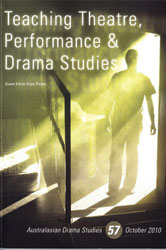 Australasian Drama Studies
Australasian Drama Studies
Volume 57 April 2010
Table of Contents
- Issue 057 (Full Issue PDF)
- Introduction: Gaye Poole Teaching Theatre, Performance and Drama Studies
- IAN MAXWELL "Do You Really Want It?"
- SUZANNE LITTLE Creating the Relective Student-Practitioner
- MICHAEL BALFOUR Developing the Capacities of Applied Theatre Students to Be Critically Reflective Learner-Practitioners
- BRONWYN TWEDDLE The Johnny Depp Effect: Using Contemporary Film to Teach Brechtian Concepts
- STUART GRANT, MATTHEW LOCKITT and ABIGAIL KATE EGAN The Uncertain Musical: An Experiment in Performance as Research as Pedagogy
- GLENN D'CRUZ Teaching/Directing 4.48 Psychosis
- KIM DURBAN 'I Love the Quality of Playing, I': Directing Adventures in Ballarat
- DAVID O'DONNELL and LISA WARRINGTON Teaching the Unteachable: A Dialogue in Director Training
- LIZA-MARE SYRON in conversation with GEOFFREY MILNE Indigenous Performing Arts Training in Australia
- MEREDITH ROGERS An Adaptable Aesthetic: Performing the Happy Accident and the Everyday in Tertiary Performance-Making
- GILLIAN ARRIGHI Devising Place and Social History: A Regional Perspective on Teaching Devised Performance in the Tertiary Sector
- JULIE ROBSON, DANIELLE BRADY and LEKKIE HOPKINS From Practice to the Page: Multi-Disciplinary Understandings of the Written Component of Practice-Led Studies
- MARY ELIZABETH ANDERSON Planned Obsolescence? Technologies of Performance Training in Detroit, Michigan
- RACHEL FORGASZ What in the World Do They Think We're Doing? Practitioners' Views on the Work of the Theatre Studies Academy
- Review: DAVID O'DONNELL, Performing Japan: Contemporary Expressions of Cultural Identity, edited by Henry Johnson and Jerry C. Jaffe;
- Review: RICHARD FOTHERINGHAM, Tivoli King: Life of Harry Rickards, Vaudeville Showman, by Gae Anderson;
- Review: KRIS PLUMMER, The Story of the Miracles at Cookie's Table, by Wesley Enoch;
- Review: GORKEM ACAROGLU, Parramatta Girls, by Alana Valentine; GLENN D'CRUZ, Practice-as-Research in Performance and Screen, edited by Ludivine Allegue, Simon Jones, Baz Kershaw and Angela Pic
- Review: GLENN D'CRUZ, Practice-as-Research in Performance and Screen, edited by Ludivine Allegue, Simon Jones, Baz Kershaw and Angela Piccini;
- Review: RAND T. HAZOU, Performance in Place of War, by James Thompson, Jenny Hughes and Michael Balfour;
- Review; DAWN ALBINGER, ALchemists of the Stage: Theatre Laboratories in Europe, by Mirella Schino (translated by Paul Warrington)
Issue 56
Thu, 1 Apr 2010Printable version
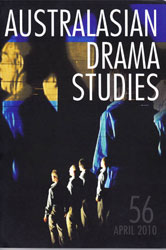 Australasian Drama Studies
Australasian Drama Studies
Volume 56 April 2010
Table of Contents
- Issue 056 (Full Issue PDF)
- Editorial Note Geoffrey Milne
- FIONA WINNING Rex Cramphorn Memorial Lecture: Creativity and Flexibility: The Nexus between Infrastructure Space and Art
- DAWN ALBINGER Resisting Romantic Love: Transforming the Wound of Amputation into a Caress
- HELEN GREHAN Aboriginal Performance: Politics, Empathy and the Question of Reciprocity
- ANGELA CAMPBELL Yandy: Walking the Uneven Lie of a Mining Boom
- PETA TAIT Human Rights, Humanness and the Animalness in Antigone: Empathetic Emotions and Company B's Production
- WILLIAM PETERSON The Fashioning of a Melbourne Event: The Melbourne International Arts Festival 2002-2009
- ELIZABETH HALE The Lost Echo: Introduction
- ADRIAN KIERNANDER Abjected Arcadias: Images of Classical Greece and Rome in Barrie Kosky's Oedipus, The Lost Echo and The Women of Troy
- ELIZABETH HALE The Pursuit of Youth: Adolescence, Seduction and the Pastoral in Act One of The Lost Echo
- JOHN McCallum and TOM HILLARD Shocking Audiences Modern and Ancient
- KIM BASTON Jacques Brel and Circus Performance: The Compiled Score as Discourse in The Spaces Between by Circa
- CAT HOPE Vibrating Performance: Experiencing Music through Vibration in the Work of Abe Sada
- YANA TAYLOR Slow Dance or Fast Sculpture: Suzuki Training in Sydney's Contemporary Performance
- JASNA NOVAKOVIC Dorothy Hewett's Sacred Place
- STEPHEN VAGG Alec Coppel: Australian Playwright and Survivor
- Review: VICTOR EMELJANOW, Impact of the Modern: Vernacular Modernities in Australia 1870s-1960s, edited by Robert Dixon and Veronica Kelly;
- Review: MAY-BRIT AKERHOLT, Belonging: Australian Playwriting in the 20th Century, by John McCallum;
- Review: GILLIAN ARRIGHI, To Watch Theatre: Essays on Genre and Corporeality, by Rachel Fensham;
- Review: BREE HADLEY, Independent Brisbane: Four Plays;
- Review: MAGGI PHILLIPS, Victor Turner and Contemporary Cultural Performance, edited by Graham St John;
- Review: JONATHAN MARSHALL, Performing Femininity: Dance and Literature in German Modernism, by Alexander Kolb;
- Review: ADAM BROINOWSKI, Contemporary African American Women Playwrights: A Casebook, edited by Philip C.Kolin;
- Review: GRETA BOND, Mapping Landscapes for Performance as Research: Scholarly Acts and Creative Cartographies, edited by Shannon Rose Riley and Lynette Hunter.
Issue 55
Thu, 1 Oct 2009Printable version
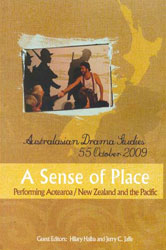 Australasian Drama Studies
Australasian Drama Studies
Volume 55 October 2009
Table of Contents
- Issue 055 (Full Issue PDF)
- JERRY C. JAFFE Loop/I/-ness in the New Zealand Performance of Identity (or, Id Entity)
- DAVID O'DONNELL Politics of Place and Extended Family in Taki Rua Productions' 25th Year: Strange Resting Places and Te Karakia
- STUART YOUNG and MEI-LIN TE PUEA HANSEN A Dramatic Hijacking: Arthur Millerising Haruru Mai at the Auckland Theatre Company
- HILARY HALBA The Flames of Hope: The Representation of Prophecy in Two New Zealand Plays
- ADRIANN SMITH Home Land or Homeland?: Taking Root in the Land of Aotearoa/New Zealand
- LISA WARRINGTON Landscape, Body, memory and Belonging in the plays of Gary Henderson
- GEORGE PARKER Hatching: Hatch or the Plight of the Penguins and the Search for a sense of Place in New Zealand Solo Performance
- PALOMA FRESNO CALLEJA Monodramas for a Multiculture: Performing New Zealand Chinese Identities in Linda Chanwai-Earle's Ka Shue/Letters Home
- MURRAY EDMOND 'I Want You Boys to Cook Pig': the Two No.2s
- IAN GASKELL Truth, Identity and the Sense of 'Pacificness'
- MOIRA FORTIN Takona: Body Painting in Rapa Nui Performing Arts
- Review:MARY ELIZABETH ANDERSON,Unstable Ground: Performance and the Politics of Place, edited by Gay McAuley;
- Review:MARYROSE CASEY, 'Your Genre is Black':Indigenous Performaing Arts and Policy, by Hilary Glow and Katya Johanson;
- Review: JONATHAN W. MARSHALL, Anatomy Live: Performing and the Operating Theatre, edited by Maaike Bleeker;
- Review: GEOFFREY MILNE, Directors/Directing: Conversations on Theatre, by Maria Shevtsova and Christopher Innes;
- Review: JOHN JACOBS, Bertolt Brecht, by Meg Mumford:
- Review: DAVID O'DONNELL, The Cape, by Vivienne Plumb and The Mall, by Thomas Sainsbury
Issue 54
Wed, 1 Apr 2009Printable version
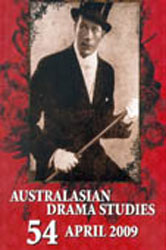 Australasian Drama Studies
Australasian Drama Studies
Volume 54 April 2009
Table of Contents
- Issue 054 (Full Issue PDF)
- EDITORIAL NOTE: Geoffrey Milne
- LAURENCE SENELICK Place Settings: Real Estate or Imagined Estates in Chekhov and Kantor
- MARY-BRIT AKERHOLT A Sense of Otherness? The Balancing Act of Translation
- MEGAN HOFFMAN Is a Fashion Show the Place for Social Commentary? Investigating the Spectacle Dressed Up in Ideas in Hussein Chalayan's After Words
- DAVID A. WILLIAMS Killing the Audience: Forced Entertainment's First Night
- GILLIAN ARRIGHI Negotiating National Identity at the Circus: The FitzGerald Brothers' Circus in Melbourne, 1892
- MARTIN LIPTON 'Our Madge and Cyril': Ghosted framings of the Public and Private Partnership of Madge Elliott and Cyril Ritchard
- NIGEL JAMIESON Rex Cramphorn memorial Lecture: Make it Relevant
- DENISE VARNEY Radical Disengagement and Liquid Lives: Criminology by Arena Theatre Company
- ROB PENSALFINI Not in Our Own Voices: Accent and Identity in Contemporary Australian Shakespeare Performance
- ADELE CHYNOWETH Am Dram and Art Galleries: The Marginalisation of Professional theatre in Australia's National Capital
- JONATHAN BOLLEN, NEAL HARVEY, JULIE HOLLEDGE and GLEN MCGILLIVRAY AusStage: e-Research in the Performing Arts
- Review:GLENN D'CRUZ, , Stage Presence by Jane Goodall;
- Review: GEOFFREY MILNE, Performance and Cosmopolitics: Cross-Cultural Transactions in Australasia by Helen Gilbert and Jacqueline Lo;
- Review: CAROLYN D'CRUZ, What a Man's Gotta Do? Masculinities and Performance by Adrian Kiernander, Jonathan Bollen and Bruce Parr;
- Review: GEOFFREY MILNE, Nick Enright: An Actor's Playwright, , edited by Anne Pender and Susan Lever;
- Review: LISA WARRINGTON, Two Plays: Falemalama and The Packer by Dianna Fuemana and The Daylight Atheist by Tom Scott;
- Review: FINCINA HOPGOOD, Alvin Purple by Catherine Lumby and The Piano by Gail Jones;
- Review: DAVID O'DONNELL, Signatures of the Past: Cultural memory in Contemporary Anglophone North American Dramaedited by Marc Maufort and Caroline De Wagter.
Issue 53
Wed, 1 Oct 2008Printable version
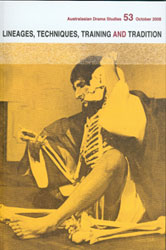 Australasian Drama Studies
Australasian Drama Studies
Volume 53 October 2008
Table of Contents
- Issue 053 (Full Issue PDF)
- MEREDITH ROGERS and ELIZABETH SCHAFER Introduction:Lineages, Techniques, Training and Traditions
- BREE HADLEY Influences, Institutions and Outcomes: A Survey of Masters and Doctoral Theses on Actor Training in Australia, 1979-2004
- IAN MAXWELL 'All Exercise Sessions to Take Place in Complete Silence': Performance Syndicate and the Rise and Fall of the Grotowskian Ideal 1969-1974
- GEOFFREY MILNE Lighthouse: A 'Mainstage" Ensemble Experience
- PETER ECKERSALL and YONI PRIOR Lineages, Training, Techniques and Tradition: Rethinking the Place of Rusden in Melbourne's Contemporary Theatre - A Roundtable Discussion
- LIZA-MARE SYRON 'The Bennelong Complex': Critical Perspectives on Contemporary Indigenous Theatre and Performance Practice
- PETA TAIT Bodies Perform Inner Emotions: Stanislavski's Legacy
- BARRY LAING Physical Practice/Imaginal Play: Un-disciplining the Performer
- ANDREW FILMER The Place of Theatre Practice: Training and Aesthetic Tradition at Belvoir Street
- MEREDITH ROGERS Actors and Chairs: Towards the Genealogy of a Rehearsal Room Exercise
- KATE ROSSMANITH Traditions and Training in Rehearsal Practice
- JULIAN MEYRICK Wayne Blair in Interview
- NIAMH DOWLING Moving into Performance:Using the Principles of the Alexander Technique to Underpin and Enhance the Ator's Training
- LYNN EVERETT Jacques Lecoq's Bouffons in Australia
- ROSEMARY FARRELL Nanjing Project: Chinese Acrobatcs, Australain New Circus and Hybrid Intercultural Performance
- MARIA BRIGIDA DE MIRANDA The NYID Workshop: Physical Performance in Space
- Review: HILARY HALBA, Number Two and BARE by Tao Fraser;
- Review: LISA WARRINGTON, Three Plays: Skin Tight, Mo & Jess Kill Susie, An Unseasonable Fall of Snow by Gary Henderson;
- Review: JERRY JAFFEE, Performing Aotearoa: New Zealand Theatre & Drama in an age of Transition by Marc Maufort and David O'donnell, eds;
- Review: JASNA NOVAKOVIC, Plays of the '50s, Volume 1, by Katherine Brisbane, ed.
- Review: MARK SETON, Riflemind by Andrew Upton;
- Review: MARK SETON, It Just Stopped and Myth, Propaganda and Disaster in Nazi Germany and Contemporary America: A Drama in 30 Scenes by Stephen Sewell;
- Review: ADAM BROINOWSKI, Strangers Inbetween and adaptation of Timothy Conigrave's Holding the Man by Tommy Murphy;
- Review: GLENN D'CRUZ, Stage Presence by Jane Goodall;
- Review: ADAM BROINOWSKI, Class Act: Melbourne Workers Theatre 1987-2007 by Glen D'Cruz ed.
- Review: WILLIAM PETERSON, Haresh Sharma: The Cultural Politics of Playwriting in Contemporary Singapore, Interlogue: Studies in Singapore Literature, Volume 6, by David Birch;
- Review: BRYONI TREZISE, The Theatre of Societas Raffaello Sanzio by Claudia Castellucci, Romeo Castellucci, chiara Guidi, Joe Kelleher and Nicholas Ridout.
Issue 52
Tue, 1 Apr 2008Printable version
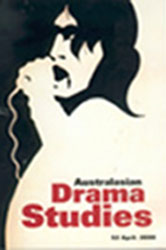 Australasian Drama Studies
Australasian Drama Studies
Volume 52 April 2008
Table of Contents
- Issue 052 (Full Issue PDF)
- MARGARET HAMILTON Postdramatic Theatre and Australia: A 'New' Theatre Discourse
- KIM BASTON 'If I Had Something To See, Would It Be Theatre?' - Musicians Performing the 'Musician'
- T.BERTO Competing Histories, Clashing Cultural Systems: Yanagai! Yanagai! Challenges the Valorisation of Testimony in the Olney Decision
- STEPHEN CARLETON Darwin as the Frontier Capital: Theatrical Depictions of City Space in the North
- GLEN MCGILLIVRAY Mis-recognised Knowledges: National Identity and the Unreliable Narrator in Jack Hibberd's A Stretch of the Imagination and Josephine Wilson's The Geography of Haunted Places
- LAURA GINTERS Interview: Lindy Davies: A Path to a Process, Part 2
- SCOTT RANKIN DIY Virtuosity versus Professional Mediocrity
- NICOLE ANAE Poses Plastiques: The Art and Style of 'Statuary' in Victorian Visual Theatre
- MELISSA BELLANTA The Larrikin's Hop: Larrikin and Late Colonial Popular Theatre
- LUCY CHESSER More Playful than Anxious: Cross-dressing, Sex-impersonation and the Colonial Stage
- RYAN HARTIGAN 'They Watch Me As They Watch This': Alfred Jarry, Symbolism and Self-as-Performance in Fin-de-Siecle Paris
- CHRISTINE COMANS La Boite Theatre Company: A Distinctive History
- Review: MARYROSE CASEY, Contemporary Indigenous Plays by Vivienne Cleven, Wesley Enoch, David Milroy and Geoffrey Narkle, Jane Harriosn and David Milroy;
- Review: DAVID CROUCH, Unsettling Space: Contestations in Contemporary Australian Theatre by Joanne Tompkins;
- Review: FRANCES DEVLIN-GLASS, Creating Frames: Contemporary Indigenous Theatre, 1967-1990 by Maryrose Casey;
- Review: TERENCE CRAWFORD, Frankly Acting by John Nobbs.
- Review: HILARY HALBA, and what remains by Miria George;
- Review: MARK GAUNTLETT, The Stukeley Plays: The Battle of Alcazar by George Peele; The Famous History of the Life and Death of captain Thomas Stukeley edited by Charles Edelman;
- Review: PETER ECKERSALL, The Aesthetics of Quietude: Ota Shogo and the Theatre of Divestiture by Mari Boyd;
- Review: MARK SETON, Etienne Decroux by Thomas Leabhart;
- Review: VICTOR EMELJANOW, The Mask Handbook: A Practical Guide by Toby Wilsher;
- Review: MARK SETON, Making Video Dance: A Step-by Step Guide to Creating Dance for the Screen by Katrina McPherson
Issue 51
Mon, 1 Oct 2007Printable version
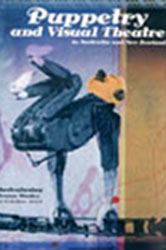 Australasian Drama Studies
Australasian Drama Studies
Volume 51 October 2007
Table of Contents
- Issue 051 (Full Issue PDF)
- GEOFFREY MILNE Editorial Note
- PETER J.WILSON Winds of Change: Seeing Australia into the New Century
- ANNE FORBES From Animism to Digital Animation: Puppetry in New Zealand/Aotearoa
- RICHARD BRADSHAW Thiodon's Wonders: A Mechanical Theatre in Nineteenth-Century Australia
- NICOLE ANAE "Belly-Speaker", Machines and Dummies: Puppetry in the Australian Colonies, 1830's-1850's
- DAVID TREDINNICK Tintookie Man, the LAst of his Tribe: A Story of Peter Scriven
- YUJI SONE "Phontom" Puppetry in Stelarc's Work
- RICHARD HART with JULIA DAVIS Dream Puppets: The Journey of an Independent Puppet Theatre
- SANDY MCKENDRICK in conversation with GEOFFREY MILNE Puppetry as Cultural Exchange in Indigenous Communities
- JENNIFER PFEIFFER Globalisation and the UNIMA Asia-Pacific Commission
- MARGARET WILLIAMS Including the Audience: The Idea of 'the Puppet' and the Real Spectator
Reviews
JASNA NOVAKOVIC, Unspoken by Rebecca Clarke;
HILARY HALBA Awhi Tapu by Albert Belz and The Prophet by Hone Kouka;
DAVID O'DONNELL, Baghdad Baby! by Dean Parker;
ALISON RICHARDS About Performance no 6, ed. Gay McAuley;
LISA WARRINGTON, Nola Millar: A Theatrical Life by Sarah Gaitanos; Just Who Does He Think He Is?: A Theatrical Life by George Webby;
MARY ELIZABETH ANDERSON, Anarchic Dance, eds Liz Aggiss and Bill Cowrie with Ian Bramley;
BREE HADLEY, And Then, You Act: Making Art in an Unpredictable World, by Anne Bogart;
MARK SETON, Jacques Copeau, by Mark Evans;
IAN MAXWELL, Encounters with Tadeusz Kantor, by Krzysztof Miklaszewski translated and edited by George Hyde.
Issue 50
Sun, 1 Apr 2007Printable version
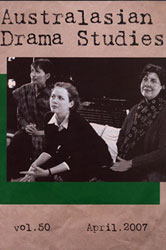 Australasian Drama Studies
Australasian Drama Studies
vol.50 April 2007
Table of Contents
- Issue 050 (Full Issue PDF)
- DANIEL KEENE A Theatre of Difference
- STEPHEN VAGG Finch, Fry and Factories: A Brief History of Mercury Theatre
- ROSEMARY FARRELL Chinese Acrobatics Unmasked in Australian Circus in the Nineteenth Century
- RICHARD FOTHERINGHAM and ROB PENSALFINI Anti-colonial Voices? Non-British Accents and the National Authentication of Shakespeare in Australia in the 1970s
- MEREDITH ROGERS Dramaturgy as Political Desire: Making a Democratic Space-the Orestes Trilogy (Melbourne, Australia,1974)
- MURRAY EDMOND Te Kaainga/Where The Fire Burns- Hone Kouka's Trilogy: Waiora, Homefires and The Prophet
- BREE HADLEY Dis/identification in Contemporary Physical Performance: NYID's Scene of the Beginning from the End
- PAUL DWYER Still Rehearsing the Revolution? 'Theatre of the Oppressed', State Subsidy and Drug War Politics
- MICHAEL ANDERSON and LINDEN WILKNSON
- MARK STEON Recognising and misrecognising the 'X' Factor: The Audition Selection Process in Actor-training Institutions Revisited
Issue 49
Sun, 1 Oct 2006Printable version
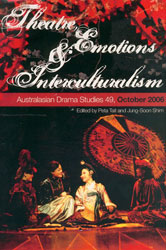 Australasian Drama Studies
Australasian Drama Studies
Issue 49 October 2006
Theatre Emotion & Interculturalism
Edited by Peta Tait and Jung-Soon Shim
A special focus issue of Australasian Drama Studies
Table of Contents
- Issue 049 (Full Issue PDF)
- JUNG-SOON SHIM Introduction: Translating Emotions for the Local Audience
- PETA TAIT Introduction: Reasoning Emotions in Theatre
- SUE-ELLEN CASE Musical The Last Empress: A Korean Staging of Woman and Nation
- JUNG-SOON SHIM Performing Emotion Interculturally: The Korean Production of Love Child
- PETA TAIT Embodying Love: Mother Meets Daughter in Theatre for Cultural Exchange
- YOON-TAEK LEE Translated by JOHN CHA and JUNG-SOON SHIM Playscript: O Gu: The Ritual of Death
- JULIE HOLLEDGE O Gu: A Cross-cultural Case Study of Emotional Expression in Contemporary Korean and Australian Theatre
Reviews
HILARY HALBA, Frangipani Perfume and Dianna Fuemana, Mapaki (Wellington: The Play Press, 2004); Oscar Kightley and Simon Small, Fresh Off the Boat (Wellington: The Play Press, 2005); Albert Wendt, The Songmaker’s Chair (Wellington: Huia, 2004) by Makerita Urale;
JERRY C. JAFFE, Noh Business (Berkeley: Atelos, 2005) by Murray Edmond;
PETA TAIT, The Dolls’ Revolution: Australian Theatre and the Cultural Imagination (Melbourne: Australian Scholarly, 2005) by Rachel Fensham and Denise Varney, with Maryrose Casey and Laura Ginters;
JULIAN MEYRICK, Not Wrong – Just Different: Observations on the Rise of Contemporary Theatre (Sydney: Currency Press, 2005) by Katherine Brisbane;
CAROLYN D’CRUZ, Beneath the Sequined Surface: An Insight into Sydney Drag (Sydney: Currency Press, 2006) by Carol Langley;
IAN MAXWELL, Electoral Guerilla Theatre: Radical Ridicule and Social Movements (New York and London: Routledge, 2005) by L. M. Bogad;
RONALDO MORELOS, The Aesthetics of the Oppressed (London and New York: Routledge, 2006) by Augusto Boal;
IAN GASKELL, A Boal Companion: Dialogues on Theatre and Cultural Politics (New York and London: Routledge, 2006) eds Jan Cohen-Cruz and Mandy Schutzman;
SALLY GARDNER, Exhausting Dance: Performance and the Politics of Movement (New York and London: Routledge, 2006) by Andre Lepecki;
IAN MAXWELL, The Path of the Actor (London and New York: Routledge, 2005) by Michael Chekhov, (edited by Andrei Kirillov and Bella Martin).
Issue 48
Sat, 1 Apr 2006Printable version
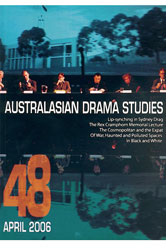 Australasian Drama Studies
Australasian Drama Studies
Number 48 April 2006
Table of Contents
- Issue 048 (Full Issue PDF)
- CAROL LANGLEY Borrowed Voice: The Art of Lip-Synching in Sydney Drag
- LYNDON TERRACINI The Culture of Place: Making Australian Theatre
- NICOLE ANAE Adventures in Nineteenth-Century Gender-Bending: Lady Emilia Don in Tasmania, 1862 and 1865
- ANNA BEMROSE The Boy from Mount Gambier: Robert Helpmann’s Early Career in Australia (1917–1932)
- STEPHEN VAGG Frank Harvey: Australian Screenwriting Pioneer
- FIONA GREGORY High-Cultural Histrionics: Judith Anderson’s 1955 Australian Tour
- DAVID A WILLIAMS Political Theatrics in the ‘Fog of War’
- PAUL DWYER The inner lining of political discourse: presenting the version 1.0 remix of the Senate Select Committee on a Certain Maritime Incident
- JOHN McCALLUM CMI (A Certain Maritime Incident): Introduction
- CMI Performance Script 143
- RUTH THOMPSON Theatre/s of Peace and Protest: The Continuing Influence of Euripides’ Play The Trojan Women at the Nexus of Social Justice and Theatre Practice
- RICCI-JANE ADAMS Inheritors of the Dead Heart: Magical Realism in These People and Falling Petals by Ben Ellis
- ALISON LYSSA Black and White: Australia’s History Onstage in Four Plays of the New Millennium
- JACK TEIWES Nostalgia, Reconciliation or New National Myth?: The Adaptation of Cloudstreet to the Stage
Reviews
JENNY DE REUCK, Prologues to Shakespeare’s Theatre: Performance and Liminality in Early Modern Drama by Douglas Bruster and Robert Weimann
JOHN JACOBS, Talking to the Audience: Shakespeare, Performance, Self by Bridget Escolme
BREE HADLEY, Circus Bodies: Cultural Identity in Aerial Performance by Peta Tait
JONATHAN MARSHALL, Into Performance: Japanese Women Artists in New York by Midori Yoshimoto
DAVID MOODY, Theatrical Events: Borders, Dynamics, Frames eds Vicky Ann Cremona et al
BARRY O’CONNOR, Trade Secrets: Australian Actors and Their Craft by Terence Crawford
JONATHAN DAWSON, Three Dollars: Screenplay by Robert Connolly and Elliot Perlman
Issue 47
Sat, 1 Oct 2005Printable version
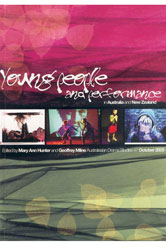 Australasian Drama Studies
Australasian Drama Studies
Issue 47 October 2005
Young People and Performance
Edited by Mary Ann Hunter and Geoffrey Milne
A special focus issue of Australasian Drama Studies
Table of Contents
- Issue 047 (Full Issue PDF)
- Young People and Performance in Australia and New Zealand MARY ANN HUNTER and GEOFFREY MILNE
- Acknowledging the Past: Youth Performing Arts in the 1970s MARGARET LEASK
- Melbourne to Manchester: Arena Theatre's Artform Evolution ROSEMARY MYERS
- Pecking at Your Head: The Flight and Fall of 'Magpie' ROSEMARY NURSEY-BRAY
- White Crocodile, Black Skirt: Theatre for Young People and Cultural Memory HELEN STRUBE
- Welcome to Lallyland: Introducing the plays of Lally Katz as Magical Feminism RICCI-JANE ADAMS
- Shalakazap! - Empowerment in Young People's Theatre, Aotearoa/New Zealand: An Interview with Jenny Wake of Calico Theatre LISA WARRINGTON
- Universality and Specificity, Making Drama From Personal Myth and Point of View JOHN DAVIES
- Promoting Agency or 'Stepping-Stones R Us'? Recent Melbourne Youth Theatre GEOFFREY MILNE
- Of Peacebuilding and Performance: Contact Inc's 'Third Space' of Intercultural Collaboration MARY ANN HUNTER
Reviews
MEREDITH ROGERS, Upstaged: Australian Women Dramatists in the Limelight at Last by Michelle Arrow
DAVID WATT, The Space Between: The Art of Puppetry and Visual Theatre in Australia by Peter J. Wilson and Geoffrey Milne
ALISON RICHARDS, Innovation in Australian Arts, Media and Design: Fresh Challenges for the Tertiary Sector ed. Rod Wissler et al
VERONICA KELLY, Writing and rewriting: National Theatre Histories ed. S.E. Wilmer
RACHEL FENSHAM, Virtual Theatres: An Introduction by Gabriella Giannachi
PENNY GAY, The Cambridge Companion to Victorian and Edwardian Theatre ed. Kerry Powell
PETER ECKERSALL, Eugenio Barba by Jane Turner and The Intercultural Performance Handbook by John Martin
Issue 46
Fri, 1 Apr 2005Printable version
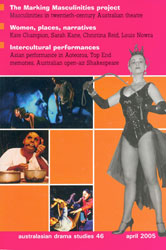 Australasian Drama Studies
Australasian Drama Studies
Number 46 April 2005
Table of Contents
- Issue 046 (Full Issue PDF)
- Remembering masculinities in the theatre of war JONATHAN BOLLEN
- The misfit male body in Adelaide Theatre, 1959 BRUCE PARR
- What’s a man to do? Images of rural Australian masculinities in three plays of the 1950s: Reedy River, The Bastard Country and Lola Montez ADRIAN KIERNANDER
- ‘The play’s the thing’ no longer: non-linear narrative Kate Champion’s Same, same But Different ROSEMARY KLITCH
- Identity performance in Northern Ireland and Australia: The Belle of the Belfast City and Radiance REBECCA PELAN
- Experiencing Kane: an affective analysis of Sarah Kane’s ‘experiential’ theatre in performance ALYSON CAMPBELL
- Brave ‘new world’: Asian voices in the Theatre of Aotearoa LISA WARRINGTON
- Official amnesias and embodiments of memory in Australia’s Top End LESLEY DELMENICO
- ‘Here’s a marvelous convenient place for our rehearsal’: Shakespeare in Australian space ROSEMARY GABY
Reviews
RICHARD FOTHERINGHAM, Shashibiya: Staging Shakespeare in China by Li Ruru
BRIDGET MARY AITCHISON, Merely Players? Actors’ Accounts of Performing Shakespeare by Jonathan Holmes and Inside the Royal Shakespeare Company: Creativity and Institution by Colin Chambers;
VICTOR EMELJANOW, Alice May, Gilbert and Sullivan’s First Prima Donna by Adrienne Simpson
HOWARD McNAUGHTON, Oscar Asche, Orientalism, and British Musical Comedy by Brian Singleton
RUSSELL FEWSTER, Konstantin Stanislavsky by Bella Martin and Vsevolod Meyerhold by Jonathon Pitches
ADRIAN KIERNANDER, Dodin and the Maly Drama Theatre: Process to Performance by Maria Shevtsova
MARYROSE CASEY, Theatre Australia (Un)limited: Australian Theatre Since the 1950s by Geoffrey Milne
WILLIAM PETERSON, Staging Nation: English Language Theatre in Malaysia and Singapore by Jacqueline Lo
GLEN D’CRUZ, Alternatives: Debating Theatre Culture in the Age of Con-Fusion ed. Peter Eckersall, Uchino Tadashi and Moriyama Naoto
Issue 45
Fri, 1 Oct 2004Printable version
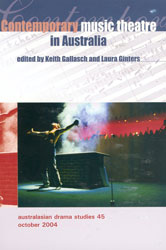 Australasian Drama Studies
Australasian Drama Studies
Issue 45 October 2004
Contemporary Music Theatre in Australia
Edited by Keith Gallasch and Laura Ginters
A special focus issue of Australasian Drama Studies
Table of Contents
- Issue 045 (Full Issue PDF)
- Australian music theatre: continuity and hybridity KEITH GALLASCH and LAURA GINTERS
- ‘A comfortable society’: the 1950s and opera in Australia MICHAEL HALLIWELL
- Larry Sitsky’s The Golem: the esoteric opera ANTONY ERNST
- Matricide and the female divine HELEN RUSAK
- Operatic tradition and ambivalence in Chamber Made Opera’s Recital JONATHAN MARSHALL
- A music theatre life: LYNDON TERRACINI interviewed by KEITH GALLASCH
- Mata Hara and the missionary position: Australian double agents in the seduction of randai DOUG LEONARD, INDIJA MAHJOEDDIN and ADRIAN SHERRIFF
- Suspension, introspection and contradiction: the songs of The Threepenny Opera in rehearsal MIRANDA HECKENBERG
- 'Australian-ness’ in musical theatre: a bran nue dae for Australia? PETER WYLLIE JOHNSTON
Reviews
PETER HOLBROOK, William Shakespeare, ‘The Merchant of Venice’ ed. Charles Edelman
LEAH MERCER, Selected Plays of Hélène Cixous ed. Eric Prenowitz
BRIAN SINGLETON, Antonin Artaud: A Critical Reader ed. Edward Scheer
PAUL MAKEHAM, The Twentieth-Century Performance Reader ed. Michael Huxley and Noel Witts
JONATHAN BOLLEN, Performance: Recasting the Political in Theatre and Beyond by Stephen Chinna
SUE RIDER, The Parsons Lectures: The Philip Parsons Memorial Lectures on the Performing Arts 1993-2003 ed. Katharine Brisbane and Don’t Tell Me, Show Me: Directors Talk About Acting by Adam Macaulay
HELENA GREHAN, Playing Australia: Australian Theatre and the International Stage ed. Elizabeth Schafer and Susan Bradley Smith.
Issue 44
Thu, 1 Apr 2004Printable version
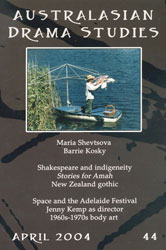 Australasian Drama Studies
Australasian Drama Studies
Number 44 April 2004
Table of Contents
- Issue 044 (Full Issue PDF)
- Outside In: Theatre, Networks and Interdisciplinary Perspectives MARIA SHEVTSOVA
- 'Hello Wien!' The Eighth Rex Cramphorn Memorial Lecture BARRIE KOSKY
- Utopia, Maps and Ecstasy: Configuring Space in Barrie Kosky's 1996 Adelaide Festival MARY ANN HUNTER
- Making a Mythopoetic Theatre: Jenny Kemp as Director of an Imaginary Future-Past-Present RACHEL FENSHAM
- The Question of Authenticity in 1960s-1970s Californian Body art: Posing a Challenge to a Concept of Presence ANJA KANNGIESER
- Reconciling Shakespeare and Indigeneity in Australia: Star-Cross'd communities and Racial Tempests EMMA COX
- '...So Many Types, How Can All Be In The Same Category':Questioning Racial Boundaries in Mark de Silva's Stories for Amah SUSAN PHILLIP
- How Gothic is S/He? Three New Zealand Dramas MURRAY EDMOND
Reviews
IAN MAXWELL, Performance and Evolution in the Age of Darwin: Out of the Natural Order by Jane R Goodall
SIMON DEVEREAUX, The Convict Theatres Early Australia, 1788-1840 by Robert Jordan
MIMI COLLIGAN, The Pollards: A Family and Its Child and Adult Opera Companies in New Zealand and Australia 1880-1910 by Peter Downes
HOWARD McNAUGHTON, Crucible of Cultures: Anglophone Drama at the Dawn of a New Millenium ed. Marc Maufort and Franca Bellarsi
DENISE VARNEY, Popular Theatre: A Sourcebook ed. joel Schechter
ANN WILSON, How Theatre Educates: Convergences & Counterpoints with Artists, Scholars and Advocates ed. Kathleen Gallagher and David Booth
JOANNE TOMPKINS, The Semiotics of Theatre and Drama, second edition by Keir Elam
Table of Contents
- Issue 044 (Full Issue PDF)
- Outside In: Theatre, Networks and Interdisciplinary Perspectives MARIA SHEVTSOVA
- 'Hello Wien!' The Eighth Rex Cramphorn Memorial Lecture BARRIE KOSKY
- Utopia, Maps and Ecstasy: Configuring Space in Barrie Kosky's 1996 Adelaide Festival MARY ANN HUNTER
- Making a Mythopoetic Theatre: Jenny Kemp as Director of an Imaginary Future-Past-Present RACHEL FENSHAM
- The Question of Authenticity in 1960s-1970s Californian Body art: Posing a Challenge to a Concept of Presence ANJA KANNGIESER
- Reconciling Shakespeare and Indigeneity in Australia: Star-Cross'd communities and Racial Tempests EMMA COX
- '...So Many Types, How Can All Be In The Same Category':Questioning Racial Boundaries in Mark de Silva's Stories for Amah SUSAN PHILLIP
- How Gothic is S/He? Three New Zealand Dramas MURRAY EDMOND
Issue 43
Wed, 1 Oct 2003Printable version
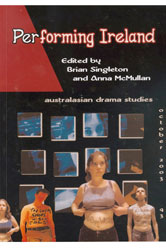 Australasian Drama Studies
Australasian Drama Studies
Issue 43 October 2003
Performing Ireland
Edited by Brian Singleton and Anna McMullan
A special focus issue of Australasian Drama Studies
Table of Contents
- Issue 043 (Full Issue PDF)
- Performing Ireland: New Perspectives on Contemporary Irish Theatre BRIAN SINGLETON and ANNA McMULLAN
- Renegotiating Landscapes of the Female: Voices, Topographies and Corporealities of Alterity in Marina Carr’s Portia Coughlan MELISSA SIHRA
- ‘The Souvenir from Foreign Parts’: Foreign Femininity in Deborah Warner’s Medea AOIFE MONKS
- Shattering Images of Sex Acts and Other Obscene Staged Transgressions in Contemporary Irish Plays by Men STEPHEN DI BENEDETTO
- ‘There’s Something Queer Here’: Modern Ireland and the Plays of Frank McGuinness DAVID CREGAN
- Hard Wired/Tender Bodies: Power, Loneliness, the Machine and the Person in the Work of Desperate Optimists CATHY LEENEY
- The Fantasy of Post-Nationalism in Northern Theatre: Caught Red Handed Transplanting the Planter MARK PHELAN
- Gendered Media Rivalry: Irish Drama and American Film ROBIN ROBERTS
- ‘Inside the Immigrant Mind’: Nostalgic Versus Nomadic Subjectivities in Late Twentieth-Century Irish Drama PAUL MURPHY
- ‘Have you no homes to go to?’ Staging the Diaspora: a Study of Milo’s Wake JULIE-ANN ROBSON
- Kia ora Begorrah: Performing Irishness in Aotearoa DAVID O’DONNEL
NOTE from Helen Thompson
Reviews
NADIA FLETCHER, The Jack Manning Trilogy by David Williamson
JONATHAN DAWSON, Dirty Deeds: Screenplay by David Caesar, and Rabbit-Proof Fence: Screenplay by Christine Olsen
DAVID CARNEGIE, Ben Jonson and Theatre: Performance, Practice and Theory by Richard Cave, Elizabeth Schafer, & Brian Wooland
CATHERINE NEWEY, Reflecting the Audience, London Theatregoing, 1840-1880 by Jim Davis & Victor Emeljanow
RICHARD FOTHERINGHAM, Dames, Principal Boys … and All That: A History of Pantomime in Australia by Viola Tait
MICHELE PIERSON, Why the French Love Jerry Lewis: From Cabaret to Early Cinema by Rae Beth Gordon
IAN MAXWELL, Re:Direction: A Theoretical and Practical Guide ed. Rebecca Schneider & Gabrielle Cody
JULIAN MEYRICK, Nowhere but Broadway by Jill Shearer and In-yer-face Theatre: British Drama Today by Aleks Sierz
Issue 42
Tue, 1 Apr 2003Printable version
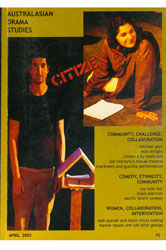 Australasian Drama Studies
Australasian Drama Studies
Number 42 April 2003
Table of Contents
- Issue 042 (Full Issue PDF)
- Believing two things at once MICHAEL GURR
- Collaboration and community The Seventh Rex Cramphorn Memorial Lecture NICK ENRIGHT
- Introduction to Citizen X CITIZEN X by Sidetrack Performance Group JANE GOODALL
- Koorero with Jim Moriarty RUTH GLASSEY and ANA WELHAM
- Guerillas in our midst: contemporary Australian guerilla performance and the poststructural community REBECCA CAINES
- Roy Rene ‘Mo’: Australian clown or monarch of the mob? KATH LEAHY
- Black and Tran: a comedy that laughs in the face of racism? HELENA GREHAN
- Toa Fraser: shifting boundaries in Pacific Island comedy DAVID O’DONNELL and BRONWYN TWEDDLE Women, Collaboration and Intervention
- Black Chicks Talking: an interview with Leah Purcell LYNNE BRADLEY
- The desire to affirm and challenge: an interview with Hannie Rayson DENISE VARNEY
Reviews
RONALDO MORELOS, Three Plays by Asian Australians ed. Don Batchelor
JONATHAN DAWSON, Lantana: Original Screenplay by Andrew Bovell
DAVID CARNEGIE, O Brave New World: Two Centuries of Shakespeare on the Australian Stage ed. John Golder & Richard Madelaine
PETER FITZPATRICK, Workers’ Playtime: Theatre and the Labour Movement Since 1970 by Alan Filewod & David Watt
RACHEL FENSHAM, Mapping Cultural Identity in Contemporary Australian Performance by Helena Grehan
VERONICA KELLY, Siting the Other: Re-visions of Marginality in Australian and English-Canadian Drama ed. Marc Maufort & Franca Bellarsi
KOH TAI ANN, Theatre and Politics in Contemporary Singapore by William Peterson
REBECCA SCHNEIDER, Body Show/s: Australian Viewings of Live Performance ed. Peta Tait
Issue 41
Tue, 1 Oct 2002Printable version
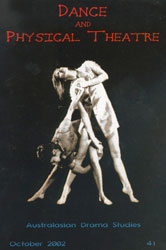 Australasian Drama Studies
Australasian Drama Studies
Number 41 October 2002
Dance and Physical Theatre
Edited by Adrian Kiernander
A special focus issue of Australasian Drama Studies
Table of Contents
- Issue 041 (Full Issue PDF)
- Unnatural Bodies from Violent and Queer Acts in Australian Physical Theatre PETA TAIT
- On Physical Theatre: A Roundtable Discussion from 'Not Yet It's Difficult' with Peter Eckersall, Paul Jackson, David pledger, Greg Ulfan PETER ECKERSALL
- Into the Wilderness: Gilgul's 'Physical' Theatre 1994 ALISON RICHARDS and YONI PRIOR
- Spectacle Effects and Performers of the Sydney Olympics Opening Ceremony MICHAEL COHEN
- An Epic of New Circus MARTINE MALEVAL translated by JANE MULLETT
- Dreaming the Future: The Emergence of Bangarra Dance Theatre STEPHANIE BURRIDGE
- Story Space in Bangarra's Pride: An Imperative for Reconciliation CELIA WEISS
- Documents in Australian Postmodern Dance: Two Interviews with Lucy Guerin JONATHAN MARSHALL
Reviews
BEN PAYNE, Blak Inside by John Harding
JONATHAN DAWSON, Blue Murder: The Screenplay by Ian David and Ned Kelly: The Screenplay by John Michael McDonagh
SUSAN LEVER, Grassroots: Series One by Geoffrey Atherton, Katherine Thomson and Michael Brindley
PETER FITZPATRICK, See How It Runs: Nimrod and the New Wave by Julian Meyrick
SIMON WOODS, The Art of Stillness by Paul Allain
BRIDGET MARY AITCHISON, To the Actor on the Technique of Acting by Michael Chekhov and Acting (Re)considered: A Theoretical and Practical Guide ed., Phillip B. Zarrilli
DAVID WATT, Performing Democracy: International Perspectives on Urban Community-Based Performance ed. Susan C. Haedicke and Tobin Nellhaus
Issue 40
Mon, 1 Apr 2002Printable version
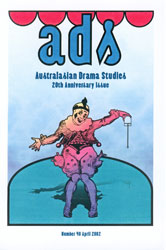 Australasian Drama Studies
Australasian Drama Studies
Number 40 April 2002
Twentieth Anniversary Edition
Table of Contents
- Issue 040 (Full Issue PDF)
- Historiography and rewriting: Performing on/as East Timorese bodies in Death at Balibo and Diablo! LESLEY DELMENICO
- Reviewing Australia’s first performance: The Recruiting Officer in Sydney 1789 NATHAN GARVEY
- Political manoeuvring behind the scenes: the development of the national theatre idea in Australia during the 1940s DONALD BATCHELOR
- The hard road to stardom: the early career of Essie Jenyns JANETTE GORDON-CLARK
- Young colonists on the Australian stage: adaptations of Paul et Virginie by James Cobb and Marcus Clarke IAN HENDERSON
- A director in rehearsal: Neil Armfield and the Company B production of The Blind Giant is Dancing by Stephen Sewell RUSSELL FEWSTER
Reviews
WILLIAM PETERSON, The Singapore Trilogy by Robert Yeo
HELENA GREHAN, Postcolonial Plays: An Anthology by Helen Gilbert
PAUL GALLOWAY, Keep Everything You Love by David Brown;
JONATHAN DAWSON, Chopper: The Screenplay by Andrew Dominik
SUSAN LEVER, Top Shelf 1: Reading and Writing the Best in Australian TV Drama by Greg Haddrick; Top Shelf 2: Five Outstanding Television Screenplays by Greg Haddrick
NERIDA NEWBIGIN, Vasari on Theatre by Thomas A. Pallen
DAVID O’DONNELL, Playing Bit Parts in Shakespeare by M. M. Mahood
BRUCE PARR, The Changing Room: Sex, Drag and Theatre by Laurence Senelick
MURRAY BRAMWELL, As Many Lives As A Cat: The University of Adelaide Theatre Guild 1938-1998 by Kerrie Round, and The Pram Factory: The Australian Performing Group Recollected by Tim Robertson
Issue 39
Mon, 1 Oct 2001Printable version
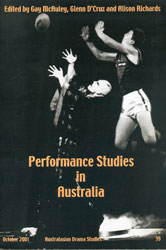 Australasian Drama Studies
Australasian Drama Studies
Number 39 October 2001
Performance Studies in Australia
Edited by Gay McAuley, Glenn D’Cruz and Alison Richards
A special focus issue of Australasian Drama Studies
Table of Contents
- Issue 039 (Full Issue PDF)
- Performance Studies: Definitions, Methodologies, Future Directions GAY McAULEY
- Performance Studies in Australia Today: a Survey of the Field GLENN D’CRUZ
- Learning in/Through Crisis IAN MAXWELL
- Shaking the Frame: Erving Goffman and Performance Studies ALISON RICHARDS
- Toil and Traffic: Australian Appropriations of the Suzuki Method HELEN GILBERT and JACQUELINE LO
- The Dialectics of Inter-Cultural Performance: Towards a Historiographic Cross-Cultural Praxis JONATHAN MARSHALL
- The More Things Change the More They Stay the Same…’? Feminisms and Performance Studies KERRIE SCHAEFER and LAURA GINTERS
- Performance Studies: a Tour Through the Field JONATHAN BOLLEN
- Discourses of an ‘International’ Disciplinary F ormation: Australian and International Performance Studies Conference Diaries 1991-2001 RACHAEL FENSHAM
- Discussing Theory-Practice Relationships in Performance: a Round-Table Discussion with Annette Tesoriero, Tess de Quincey,Deborah Pollard, John Baylis, David Pledger, Josephine Wilson PETER EC
- Review:HELEN THOMSON, Meat Party by Duong Le Quy
- Review: BARBARA JOSEPH, Sweet Road by Deborah Oswald
- Review: GEOFFREY MILNE, Melbourne Stories: Three Plays: Who’s Afraid of the Working Class? by Andrew Bovell, Patricia Cornelius, Melissa Reeves, Christos Tsiolkas and Irine Vela; Polly Blue by
Reviews
TOM BURVILL, The Chekhov Theatre: A Century of the Plays in Performance by Laurence Senelick
REBECCA PELAN, The Politics of Irish Drama: Plays in Context from Boucicault to Friel by Nicholas Grene
JACQUELINE LO, The Politics of Cultural Practice: Thinking Through Theatre in an Age of Globalization by Rustom Bharucha
Issue 38
Sun, 1 Apr 2001Printable version
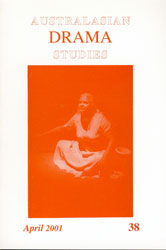 Australasian Drama Studies
Australasian Drama Studies
Number 38 April 2001
Table of Contents
- Issue 038 (Full Issue PDF)
- ‘We Want Hope’: the Power of Indigenous Arts in Australia today. The 2000 Rex Cramphorn Memorial Lecture WESLEY ENOCH
- Teaching Shakespeare in locked facilities PHILIPPA KELLY
- Post-feminist Physical Theatre: the Abject and the Split Subject in My Vicious Angel by Christine Evans ADELE CHYNOWETH
- Sugar, Land and Belonging: Summer of the Seventeenth Doll and No Sugar RUSSELL McDOUGALL
- ‘What Happens to the Spectator of Hysteria’s Realism?’ The Reception of Elizabeth Robins’and Florence Bell’s Alan’s Wife (1893) SUE THOMAS
- Proscenium Arches and Fashion Columns: Brisbane Theatre and the Role of Women During the Wars DELYSE RYAN
- Whose Turn to Shout? The Crisis in Australia Musical Theatre PETER FITZPATRICK
Reviews
GEOFFREY MILNE, Crazy Brave by Michael Gurr and A Beautiful Life by Michael Futcher and Helen Howard
DON BACHELOR, Georgia by Jill Shearer
JONATHAN DAWSON, Looking for Alibrandi: The Screenplay by Melina Marchetta
DENISE VARNEY, Feminist Theatre Practice: A Handbook by Elaine Aston
HAROLD LOVE, Visual Ephemera: Theatrical Art in Nineteenth-century Australia by Anita Calloway
IAN MAXWELL, Corpus Delecti: Performance Art of the Americas ed. Coco Fusco
BARBARA GARLICK, Defiance: Political Theatre in Brisbane 1930-1962 by Connie Healy
HOWARD McNAUGHTON, The Theatre of Form and the Production of Meaning: Contemporary Canadian Dramaturgies by Ric Knowles
Issue 37
Sun, 1 Oct 2000Printable version
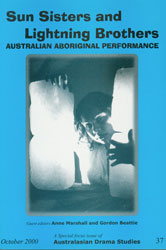 Australasian Drama Studies
Australasian Drama Studies
Australian Aboriginal Performance
Issue 37, October 2000
Table of Contents
- Issue 037 (Full Issue PDF)
- ANNE MARSHALL Casting about for the scent: Researching Aboriginal performance
- JARED THOMAS Land of opportunity?
- JUNE PERKINS 7 valleys of nurturing: Exploring the performing arts philosophy of Wesley Enoch: a profile
- GEOFFREY MILNE The Festival of the Dreaming: Intimate, contemporary, true
- JAN PINKERTON Fish out of water
- KEIRYN BABCOCK Power and performance: Aboriginality and the Academy
- LYNNE BRADLEY Choosing good ground: a forum interview with Kooemba Jdarra artistic directors Lafe Charleton, Wesley Enoch and Nadine McDonald
- ADRIAN MARSHALL Writing Truly, Madly, Country
- GORDON BEATTIE Reflections
- MARYROSE CASEY From the wings to centre stage: a production chronology of theatre and drama texts by Australian Indigenous writers
- Review: PETER FITZPATRICK Cloudstreet by Nick Enright and Justin Monjo
- review: VERONICA KELLY English Stage Comedy 1490 1990 by Alexander Leggatt
- Review: PHILLIPA KELLY New sites for Shakespeare: Theatre, the Audience and Asia by John Russel Brown
- Review: RICHARD FOTHERINGHAM, The Cambridge History of American Theatre; Volume 1, ed. Don B. Wilmeth and Christopher Bigsby
- Review: HAROLD LOVE The Silent Showman:Sir George Tallis by Michael and Joan Tallis, and Civilising the Colonies: Pioneering Opera in Australia by Alison Gyger
- Review: BRUCE PARR Lovesic: Modernist Plays of Same-Sex Love, 1894-1925,ed. Laurence Senelick
- Review: PAUL DWYER Legislative Theatre: Using Performance to Make Politics by Augusto Boal
- Review: JULIAN MEYRICK 1956 and All That: The Making of Modern British Theatre by Dan Rebellato
- Review: JOANNE TOMPKINS The Drama of South Africa by Loren Kruger
- Review: KERRIE SCHAEFER, Space in Performance: Making Meaning in the Theatre by Gay McAuley
Issue 36
Sat, 1 Apr 2000Printable version
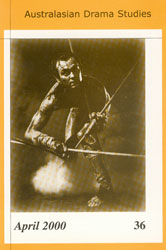 Australasian Drama Studies
Australasian Drama Studies
Issue 36, April 2000
Table of Contents
- Issue 036 (Full Issue PDF)
- NEIL ARMFIELD AND GEOFFREY RUSH The 1999 Rex Cramphorn memorial lecture: Tearing the cat
- MARYROSE CASEY Nindethana and the National Black Theatre: interrogating the mythology of the New Wave
- MURRAY EDMOND The 'original' Downstage and the theatre of its history
- MIKE FOSTER Community/communitas: renegotiating community theatre today. An interview with Graham Pitts
- PAUL MAKEHAM 'The city's surrounded by fire': Michael Gow's The Kid
- JULIA MANT The testimonial stage: theatrical presentations of the prisoner of war, 1995
- BILL DUNSTONE 'Orders of nature': press, gender and performance in colonial Western Australia 1839-1880
- MARGARET WILLIAMS and HILARY GOLDER Fighting Jack: a brief Australia melodrama
- Review:MEREDITH ROGERS The woman in the Window by Alma De Groen
- Review:GEOFFREY MILNE Chilling and Killing my Annabel Lee by Aidan Fennessy and Secret Bridesmaid's Business by Elizabeth Coleman
- Review: MELISSA WESTERN X-Stacey by Margery Forde
- Review: JULIAN MEYRICK The Dogs Play and a A Few Roos Loose in the Top Paddock by Tee O'Neill
Issue 35
Fri, 1 Oct 1999Printable version
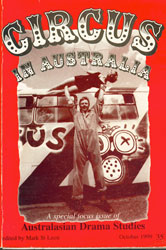 Australasian Drama Studies
Australasian Drama Studies
Issue 35, October 1999
Table of Contents
- Issue 035 (Full Issue PDF)
- MARK ST LEON Introduction
- REG BOLTON Circus as education
- RICHARD WATERHOUSE Travelling shows in rural Australia 1850-1915
- MIMI COLLIGAN Circus in theatre: Astley's amphitheatre, Melbourne 1854-1857
- GAVIN ROBBINS The passion and totality of your body, mind and soul: an interview with Nigel Jamieson
- LYNN EVERETT Thrills and spills: the precarious life of Circus Monoxide
- JOHN WHITEOAK The development of Australian Circus Music
- DAVID C S SISSONS Japanese acrobatic troupes touring Australasia 1867-1900
- CATHY J BARRETT and HEATHER VALLANCE The wild west show: socio-historic spectacle and character as circus
- PETA TAIT Circus bodies as theatre animals
- NICOLA BRACKERTZ The battle for colonial circus supremacy: John Bull, Uncle Sam and their 'Chariots of Fire'
- MARK ST LEON Noms d'arena: the use of pseudonyms in Australian circus
- MARK ST LEON Noms d'arena: the use of pseudonyms in Australian circus
- SUE BROADWAY Circus Oz - the first seven years: a memoir
- Review: MURRAY BRAMWELL The Blind Giant is Dancing the rev. ed by Stephen Sewell
- Review:JOANNE TOMPKINS Natural Life adapted by Humphrey Bower
Issue 34
Thu, 1 Apr 1999Printable version
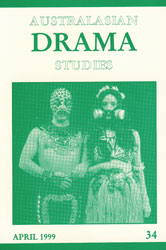 Australasian Drama Studies
Australasian Drama Studies
Issue 34, April 1999
Table of Contents
- Issue 034 (Full Issue PDF)
- LINDY DAVIES The 1998 Rex Cramphorn memorial lecture: Become the change
- CLAY DJUBAL From minstrel tenor to vaudeville showman: Harry Clay, 'a friend of the Australia performer'
- PETER COPEMAN 'Looking closer afield': Carillo Gantner on Australian theatre and Asia
- CHERYL STOCK Moving bodies across cultures: an analysis of a Vietnamese/Australian dance and music project
- DENISE VARNEY and RACHEL FENSHAM 'Help me, I'm drowning!' calls the man in Jenny Kemp's The black sequin dress: heterosexual masculinity in feminist performance
- MIMI COLLIGAN Waxworks shows and some of their proprietors in Australia, 1850s-1910s
- HELENA GREHAN Negotiating discovery in The Geography of Haunted Places
- JANE GOODALL Objects of curiosity and subjects of discovery: humans on show
- Review: GEOFFREY MILNE Navigating by Katherine Thomas
- Review:RACHEL FENSHAM Australian Women's Drama: texts and feminisms
- Review:VERONICA KELLY Honour and Redemption by Joanna-Murray Smith
- Review: GEOFFREY MILNE Love suicides by John Romeril and Some Mother's Son by Jill O'Callaghan
- Review: PHILLIPA KELLY Ms-Directing Shakespeare by Elizabeth Schafer
- Review: MARK GAUNTLETT Franquin, Master Showman by Jenny Rowley Lees
- Review:JONATHAN DAWSON The Road to Nhill: original screenplay by Alison Tilson and The Boys: The Screenplay by Stephen Sewell
- Review: PENNY GAY John Barrymore, Shakespearean Actor by Michael A Morrison and Much Ado About Nothing ed. John F Cox
- Review: ALAN FILEWOOD Our Australian Theatre in the 1990s ed Veronica Kelly, and Sightlines: Race, Gender and Nation in Contemporary Australian Drama by Helen Gilbert
Issue 33
Thu, 1 Oct 1998Printable version
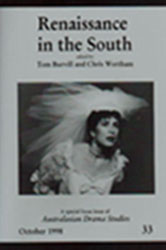 Australasian Drama Studies
Australasian Drama Studies
Number 33 Oct 1998
Table of Contents
- Issue 033 (Full Issue PDF)
- TOM BURVIL and CHRIS WORTHAM Foreward
- LLOYD DAVIS Why speak to the dead?!! Teaching and researching Renaissance drama
- FRANCES DEVLIN-GLASS “Teaching the audience with the play’: feminism and Shakespeare at the Melbourne Theatre Company, 1984-93
- PHILLIPA KELLY ‘Laughing in his face’: Australia’s Shakespeare
- ADRAIN KIERNANDER ‘Cupid’s bow burn’d; or, difference endangered in John Lily’s Gallathea and Shakespeare’s cross-dress comedies
- GEOFFREY MILNE Shakespeare under the stars: a new ‘Elizabethan’ tradition
- ANTHONY MILLER ‘Imperial Caesar’: Shakespeare’s Julius Caesar on the Australian stage, 1856-1889
- LUCY POTTER Hamlet and the scene of pedagogy
- KAORI KOBAYASHI Shakespeare wallah: George C. Miln’s Shakespearean productions in India
- MARK MINCHINTON The right and only direction: Rex Cramphorn, Shakepeare, and the Actor’s Development Stream
- PAUL WASHINGTON ‘Bardbiz’ in colonial Australia: the formation of a cultural institution
- LLOYD DAVIS Reviewing the Renaissance
- Review: PAMELA A FOULKES, My Body. My Blood by Margaret Kirby
- Review: MEREDITH ROGERS, Black Sequin Dress by Jenny Kemp
- Review: RACHEL FENSHAM, Australian Women's Drama, ed. Peta Tait and Elizabeth Schafer
- Review: GREG McCART, Three Plays by Aristophanes: Staging Women trans, Jeffrey Henderson
- Review: ALAN BRISSENDEN, Shakespeare's The Merchant of Venice, d. Penny Gay
- Review: JOHN DOWNIE. Shakespeare and the moving Image: The Plays on Film and Television, ed. Anthony Davies and Stanley Wells
- Review: RICHARD MADELAINE, The Texts of 'Othello' and Shakespearian Revision by E.A.J. Honigmann
- Review: HAROLD LOVE Come to Dazzle: Sarah Bernhardt's Australian Tour by Corille Fraser
- Review: IAN MAXWELL, Performing Brecht Forty Years of British Performances by Margaret Eddershaw
- Review: JANE GOODALL, A Sourcebook of Feminist Theatre and Performance: On and Beyond the Stage,ed. Carol Martin
- Review: TOM BURVILL, The Intercultural Performance Reader, ed. Patrice Pavis
- Review: TOM BURVILL, The Intercultural Performance Reader, ed. Patrice Pavis
Issue 32
Wed, 1 Apr 1998Printable version
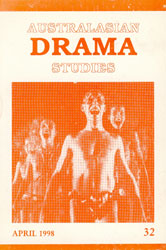 Australasian Drama Studies
Australasian Drama Studies
Number 32 April 1998
Table of Contents
- Issue 032 (Full Issue PDF)
- RHODA ROBERTS The 1997 Rex Cramphorn memorial lecture: A passion for ideas: Black stage
- JUDY PIPPEN Ranged between Heaven and Hades: actors’ bodies in cross-cultural theatre forms
- FRANCES DEVLIN-GLASS ‘Every man who is not Petruchio doth wish he was’: postfeminist anxiety and the resistance in Dead White Males
- KAORI KOBAYASHI Touring companies in the Empire: the Miln company’s Shakespearean productions in Japan
- HELEN THOMSON Dymphna Cusack’s plays
- Playscript: Panaylota by Angela Costi with an introduction by Kim baston
- JOH HARTOG The computerized gaze and the performing arts
- RICHARD FORTHERINGHAM Fingers in the text/book: compiling and editing theatre history
- Review: KATHERINE NEWEY, Modern Drama by Women, 1880s-1930s. An International Anthology, ed. Katherine Kelly.pdf
- Review: SIMON CHAN, Thieving Boy and Like Stars in My Hands by Tim Conigrave
- Review: HELEN THOMSON, The Torrents by Oriel Gray and Blackrock by Nick Enright
- Review: GEOFFREY MILNE Competitive Tenderness by Hannie Rayson and Waking Eve by Robert Hewett
- Review: PAUL MAKEHAM The Ghosts Trilogy (Too Young For Ghosts; No Going Back; My Father's Father) by Janis Balodis
- Review: KIM WALKER, Historiography and Ideology in Stuart Drama by Ivo Kanps
- Review: HAROLD LOVE, Richard Davis, Anna Bishop: the Adventures of an Intrepid Prima Donna by Richard Davis and Florence Austral: One of the Wonder Voices of the World by James Moffat_.pdf
- Review: HOWARD McNAUGHTON, Companion to Theatre in Australia, gen.ed. Phillip Parson with Victoria Chance
- Review: DAVID WILLIAMS, Art Into Theatre: Performance Interviews and Documents by Nick Kaye
- Review: SIMON WOODS, At Work with Grotowski on Physical Actions by Thomas Richards
Issue 31
Wed, 1 Oct 1997Printable version
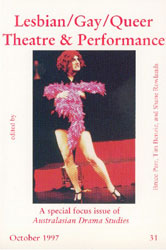 Australasian Drama Studies
Australasian Drama Studies
Number 31 Oct 1997
Table of Contents
- Issue 031 (Full Issue PDF)
- BRUCE PARR, TIM BENZIE and SHANE ROWLANDS Introduction
- LLOYD DAVIS Queer Criticism on Shakespeare
- KEIRAN BABCOCK ‘Pleasure, danger and genderfucking’: an interview with Moira Flaucane
- CHRISTOPHER BECKEY Hom(m)oerotics? Or to queer the male body on stage
- PETA TAIT Interpreting bodily functions in queer performance
- PHILIP BILTON-SMITH ‘Because they’re my people’: an interview with Alex Harding and Barry Lowe
- STUART YOUNG Sleeping with the mainstream: gay drama and theatre in Britain moves in from the margin
- SHANE ROWLANDS Textualities and Sexualities of Bodies in Motion: an interview with Gail Kelly
- JONATHAN BOLLEN ‘What a queen’s gotta do’: queer performativity and the rhetoric’s of performance
- Review: GREG MCCART, Aeschylus: Suppliants and Other Dramas: Persians, Seven Against Thebes, Fragments, Prometheus Bound,ed. Michael Ewans
- Review: PHILIP BILTON-SMITH: Australian Gay and Lesbian Plays ed. Bruce Parr
- Review: JONATHAN DAWSON: Blackrock: The Screenplay by Nick Enright and Love Serenade by Shirley Barrett
- Review: LLOYD DAVIS: The Theatrical City: Culture, Theatre and Politics in London 1576-1649,eds. David L.Smith, Richard Strier & David Bevington, and Reading Shakespeare Historically by Lisa J
- Review: ANDREW MCCANN: Impersonations: the Performance of Gender in Shakespeare's England by Stephen Orgel
- Review: JIM DAVIS: The Theatre Industry in Nineteenth Century France by F.W.J. Hemmings
- Review: RACHEL FENSHAM: Performance; a critical introduction by Marvin Carlson
- Review: PETA TAIT: The Explicit Body in Performance by Rebecca Schneider
- Review: MARGARET HENDERSON: Queer Theory by Annamarie Jagose
Issue 30
Tue, 1 Apr 1997Printable version
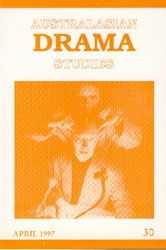 Australasian Drama Studies
Australasian Drama Studies
Number 30 April 1997
Table of Contents
- Issue 030 (Full Issue PDF)
- JOHN ROMERIL Ringing heaven: the second Rex Cramphorn Memorial Lecture
- FRANCES DEVLIN-GLASS An interview with John Bell
- MARGARET HAMILTON Open City: a field of linguistic possibilities
- ALBERT MORAN Try and try again: The Restless Years and nationalizing television drama
- ANNA BEMROSE E.W.O’Sullivan’s Coo-ee; or Wild Days in the Bush: people’s theatre or political circus?
- Review: GEOFFREY MILNE ; Sex Diary of an Infidel, Underwear, Perfume and Crash Helmet, and Jerusalem by MichaelGurr, and All Souls by Daniel Keene
- Review: JOHN DOWNIE. Eugenia by Lorae Parry, and Playlunch:Five Short New Zealand Plays ed. Christine Prentice and Lisa Warrington
- Review: JONATHAN DAWSON: Spotswood: The Screenplay by Max Dann and Andrew Knight and Cosi: The Screenplay by Louis Nowra
- Review: JOANNE TOMPKINS ; Performing Nostalgia: Shifting Shakespeare and the Contemporary Past by Susan Bennett
- Review: JOANNE TOMPKINS ; Performing Nostalgia: Shifting Shakespeare and the Contemporary Past by Susan Bennett
- Review: LLOYD DAVIS: Hamlet Theory in Practice Series, ed. Peter J.Smith and Nigel Wood, and Scocial Shakesoeare: Aspects of Renaissance Dramaturgy and Contemporary Society by Peter J.Smith
- Review: DAVID CARNEGIE Theatre and Government Under the Early Stuarts, ed. j.R. Mulryne Shewring
- Review:GARETH GRIFFITHS: Post-Colonial Drama:Theory, Practice, Politics by Helen Gilbert and Joanne Tompkins
- Review: PAUL MAKEHAM: Australian Contemporary Drama (rev.ed.) by Dennis Carroll
- Review: ALAN FILEWOOD: Challenging the Centre: Two Decades of Political Theatre, ed. Steve Capelinf
- Review: JOANNE TOMPKINS ; Contemporary Dramatists, 5th ed., K.A.Berney
Issue 29
Tue, 1 Oct 1996Printable version
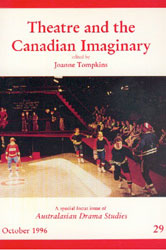 Australasian Drama Studies
Australasian Drama Studies
Theatre and the Canadian Imaginary
Number 29 October 1996
Table of Contents
- Issue 029 (Full Issue PDF)
- JOANNE TOMPKINS Canadian virtual realities: Canadian theatre and Australian theatre criticism
- ANN WILSON Border crossing: the technologies of identity in Fronteras Americans
- ALAN FILEWOD The comintern and the canon: Workers’ Theatre, Eight Men Speak and the genealogy of mise-en-scene
- SHEILA RABILLARD The seductions of theatricality: Mamet, Tremblay and political drama
- RICHARD PAUL KNOWLES The theatre of form and the production of meaning: contemporary Canadian dramaturgies
- ED NYMAN Out with the queers: moral triage and George F. Walker’s Theatre of the Film Noir
- DENIS SALTER Blood….Sex….Death….Birth:Paula de Vascomcelos’s Le Making of de Macbeth: an interview
- NATALIE REWA Astrid Janson’s designs for performance
- VALERIE SHANTZ Colonising Yvette Nolan: the making of an Australian playwright
- Playscript: Child by Yvette Nolan
- Playscript: The Glace Bay Miners’ Museum by Wendy Lill
- HELENE BEAUCHAMP Of desire, freedom, commitment and the mise en scène as a very fine art: the work of the theatre director
- KYM BIRD Leaping into the breeches: liberal feminism and cross-dressing in Sarah Ann Curzon’s The Sweet Girl Graduate
- MARVIN GILMAN Fennario and Ryga: Canadian political playwrights
- CRAIG STEWART WALKER James Reaney’s The Donnelly’s and the recovery of ‘the ceremony of innocence’
- JERRY WASSERMAN Confessions of a vile canonist: anthologising Canadian drama
- Review:HELEN THOMSON, The Incorruptible by Louis Nowra and Pacific Union by Alex Buzo
- Review: JACQUELINE LO: The Gap by Anna Broinowski and Fortune by Hilary Bell
- Review: BRUCE PARR Good Works by Nick Enright
- Review:MARLENE MOSER: Off the Air: Nine Plays for Radio by Elizabeth Jolley
- review: VERONICA KELLY: The Family by Jill Shearer and Composing Venus by Elaine Acworth
- Review: PETER THOMSON: Romeo and Juliet (Bell Shakespeare)
- Review: ALEXANDER LEGGATT: Julius Caesar (Bell Shakespeare)
- Review: KATE NEWEY: Female Playwrights of the Nineteenth Century, ed. Adrienne Scullion
- Review: CAROLYN PICKETT: Enough Blue Sky by Mona Brand
- Review: RACHEL FENSHAM: Playing with Time; Women Writers for Performance, ed. Colleen Chesterman
- Review: TERRY FLEW: Arts, Minister? Government Policy and the Arts by Justin Macdonnell.pdf
- Review: PAUL MAKEHAM: Australian Contemporary Drama by Dennis Carroll
- Review: IAN STOCKS: Canada's Hollywood by Ted Magder
- Review: DAVID WILLIAMS:Writing Dancing in the Age of Postmodernism by Sally Banes and Moving Toward Life: Five Decades of Transformational Dance by Anna Halprin
- Review: HAROLD LOVE: Annotated Calendar of Plays Premiered in Australia 1850-1869,ed. Veronica Kelly
Issue 28
Mon, 1 Apr 1996Printable version
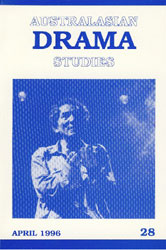 Australasian Drama Studies
Australasian Drama Studies
Number 28 April 1996
Table of Contents
- Issue 028 (Full Issue PDF)
- KEIJI SAWADA The Japanese version of The Floating World: a cross-cultural event between Japan and Australia
- JIM SHARMAN In the realm of the imagination: an individual view of theatre
- ROBERT JORDAN Visualising the Sydney Theatre, 1796
- REMY DAVISON Outside lookingin: an interview with Ray Mooney
- DAVID WILLIAMS in conversation with DAVID GEORGE Listening to images: pleasures and/in the gift
- CAROLYN PICKETT ‘The past is here’: an interview with Tes Lyaslotis
- MICHAEL HALLIWELL ‘the space between’: postcolonial opera?- the Meale/Malouf adaptation of Voss
- SUSAN CROFT A lost Australian playwright: ‘A Lady’, c.1850
- PAUL MAKEHAM Singing the landscape: Bran Nue Dae
- KATH LEAHY Power and Presence in the actor-training institution audition
- GAY McAULEY Theatre practice and critical theory
- GLENN D’CRUZ Artists into academics/academics into artists: the University of Melbourne performance drama program 1975-94
- Appendix: An open letter to gay Gay McAuley
- Review: Veronica Kelly: Crow by Louis Nowra
- Review: HELEN THOMSON: Sanctuary by David Williamson and Falling from Grace by Hannie Rayson
- Review: KATHRYN KELLY:Kafka Dances by Timothy Daly
- Review: GEOFFREY MILNE ; Choice by Ron Elisha and Dead White Males by David Williamson
- Review: DAVID CARNEGIE: Lovelock's Dream Run by David Geary
- Review: KATE HERBERT: No Strings Attached by Hilary Beaton
- Review: LISA HICKEY: Remember Ronald Ryan by Barry Dickins
- Review: NADIA FLETCHER: Collected Plays, Volume II by Patrick White
- Review: GREG McCART: The Oresteia by Aeschylus,ed. and trans. Michael Ewans
- Review: LLOYD DAVIS: Men in Women"s Clothing: Anti-theatricality and Effeminization 1579-1642 by Laura Levine
- Review: SUSAN PFISTERER: Theatre and Fashion: Oscar Wild to the Suffragettes by Joel Kaplan & Sheila Stowell
- Review: RICHARD FOTHERINGHAM: Pioneer Players: The Lives of Louis and Hilda Esson by Peter Fitzpatrick
- Review: CAROLYN PICKETT: The Plays of Alma De Groen by Elizabeth Perkins
- Review: DAVID WATT: Fire on the Water by Neil Cameron
- Review: DAVID WILLIAMS: The Tail of the Dragon: New Dance. 1976-1982 by Marcia B Siegel and Lamb at the Altar: The Story of a Dance by Deborah Hay
- Review: JOHN SENCZUK: Walking on Water: Sydney Theatre Company at the Wharf, comp. Kim Spinks and Sharon Baird
Issue 27
Sun, 1 Oct 1995Printable version
 Australasian Drama Studies
Australasian Drama Studies
Women Making Theatre for Social Change
Number 27 October 1995
Table of Contents
- Issue 027 (Full Issue PDF)
- PETA TAIT, JULIE HOLLEDGE and TONY MITCHELL Introduction
- JULIE HOLLEDGE ‘The monster is still there’: an interview with Fe Remotigue
- MINDANAO CULTURAL WORKERS with JULIE HOLLEDGE ‘To heal our social ills’: community theatre practice in the Philippines
- MATRA ROBERTSON Korean shamanism: an interview with Kim Kum hwa
- MEEWON LEE Sahmanism and Korean theatre
- JUNG SOON SHIM Awakening self: images of women in modern Korean drama
- KAREN HEESON-SMITH ‘True people’s theatre’: an interview with Ranjana Pandey
- LI YING NING Tradition and its re-creation
- FATIMA CHEBCHOUB The female artist in Morocco: with references to actresses
- ANNE-MARIE MORGAN Three approaches to modern theatre in Jakarta in the 1990s: Rendra, Putta Wijaya and Ratna Sarumpaet
- PLAYSCRIPT: Ms Serena Serenata & Beaset, Luv! By Merlinda Bobis
- TONY MITCHELL ‘High Art’ and Low Purse’” Adelaide Ristori tours Australia 22 July- 4 December 1875 Part Two
- SUSAN PFISTERER Cultural anxiety and the new woman playwright: Mrs E.S.Haviland’s On Wheels
- NOTE: Performance studies – a reply by Gay McAuley
- Review: TOM BURVILL, Bali: Adat by Graham Shiel, and Aftershocks nu the Newcastle Workers' Cultural Action Committee with writer-in-residence Paul Brown
- Review: NADIA FLETCHER: Mongrels by Nick Enright, and Furious by Michael Gow
- Review: ROBIN BOND: Aristophanes: Myth, Ritual and Comedy by A.M.Bowie
- Review: BETSY TAYLOR: The Cambridge Companion to Medieval English Theatre ed. Richard Beadle
- Review: DENISE CUTHBERT: Shakespeare and the Geography of Difference by John Gillies
- Review: PHILIP AYRES: Hamlet versus Lear: Cultural Politics and Shakespeare's Tragedies by David Margolies
- Review; LIZ SCHAFER : As She Likes It: Shakespeare's Unruly Women by Penny Gay
- Review: EDWARD SCHEER: Artaud and the Gnostic Drama by Jane Goodall
- Review: BARBARA GARLICK: The Campbell Howard Annotated Index of Australian plays 1920-1955, domp. & ed. Jack Bedson and Julian Croft
- Review: CAROLYN PICKETT:Original Women's Theatre: The Melbourne Women's Theatre Group 1974-77 by Peta Tait, and Playworks: Women Theatre Writers 1993
- Review: PAUL MAKEHAM: John Romeril ed. Gareth Griffiths
- Review: GARETH GRIFFITHS: The Cambridge Guide to Africa and Caribbean Theatre ed. Martin Banham, Errol Hill and George Woodyard
- Review: TOM BURVILL, Theatre and Cultural Interaction by Maria Shevtsova
- Review: GORDON BEATTIE: Architecture, Actor and Audience by Iain Mackintosh
- Review: FRANCES BONNER: Television and Women"s Culture: The Politics of the popular ed. Mary Ellen Brown
- Review: JOHN DOWNIE. The Actor's Way by Erike Exe Christoffersen, and Playing Boal: Theatre Therapy, Activism ed. Mady Schutzman and Jan Cohen-Cruz
- Review: RICHARD CORBALLIS: Avant Garde Theatre 1892-1992 by Christopher Innes
Issue 26
Sat, 1 Apr 1995Printable version
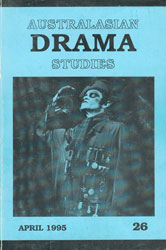 Australasian Drama Studies
Australasian Drama Studies
Number 26 April 1995
Table of Contents
- Issue 026 (Full Issue PDF)
- NADIA FLETCHER Reg Livermore: a laugh in the wilderness
- HELEN GILBERT & MELINDA MAWSON ‘Pulling the rug from under your feet’: an interview with Michael Gurr
- GLENN D’CRUZ From theatre to performance: constituting the discipline of performance studies in the Australian academy
- JOHN GOLDER & RICHARD MADELAINE Elisnore at Belvoir Street: Neil Armfield talks about Hamlet
- RICHARD FOTHERINGHAM The plays of Steele Rudd
- PLAYSCRIPT: Daily Grind by Vicki Reynolds
- MARIA SHEVTSOVA Other cultures, other classes: Patricia Cornelius on writing for the Melbourne Workers’ Theatre
- ARIENNE SIMPSON Putting entertainment on the map: the New Zealand touring circuits in 1874
- TONY MITCHELL Adelaide Ristori tours Australia 22 July – 4 December 1875 Part One
- Review: NADIA FLETCHER: St. James Infirmary and Property of the Clan by by Nick Enright
- Review: ALLAN GARDINER :On the Whipping Side, Popular Front and Faces in the Street by Errol O'Neil
- Review: LLOYD DAVIS: Shakespeare and Multiplicity by Brian Gibbons, and Shakespeare's books: Contemporary Cultural Politics and the Persistence of Empire, ed. Philip Mead and Marion Campbell
- Review: DAVID GUNBY: Madness and Drama in the Age of Shakespeare by Duncan Salkeld
- Review: MICHAEL NEILL: Guise and Disguise: Rhetoric and Characterization in the English Renaissance by Lloyd Davis
- Review: KATHERINE NEWEY, The Britannia Diaries, 1863-1875, ed. Jim Davis
- Review: HOWARD McNAUGHTON, The New Zealand Stage 1891-1900 by John Thomson
- Review: SUSAN PFISTERER: A Stage of their Own: Feminist Playwrights of Suffrage Era, by Sheila Stowell
- Review: HAROLD LOVE: The Wizard of the Wire: the Story of Con Colleano by Mark St Leon, and The Story of the Theatre Royal by Ian Bevan
- Review: DAVID WILLIAMS: Ariane Mnouchkine and the Théatre du Soleil by Adrian Kiernander
- Review: SHANE ROWLANDS: Converging Realities: Feminism in Australian Theatre by Peta Tait et al.
Issue 25
Sat, 1 Oct 1994Printable version
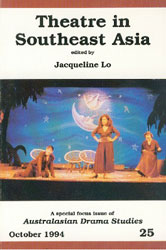 Australasian Drama Studies
Australasian Drama Studies
Theatre in Southeast Asia
Number 25 October 1994
Table of Contents
- Issue 025 (Full Issue PDF)
- JACQUELINE LO Introduction
- RON VERBURGT ‘I am because You are: You are because I am’: an interview with Rendra
- BARBARA HATLEY Stage texts and life texts: women in contemporary Indonesian theatre
- JANET PILLAI & CHARLENE REJENDRAN Teater Muda – an integrated arts approach towards devising plays with young people
- WILLIAM PETERSON Sexual minorities on the Singapore stage
- Playscript: Boss by Peter Wijaya
- DOREEN G. FERNANDEZ The past is present: the development of modern Philippine theatre
- MERLINDA BOBIS Re-inventing the epic: notes on adapting a traditional genre
- PAUL DOWSEY-MAGOG Demons with mobile phones: evolutionary discourse in Thai shadow pupperty
- HOANG SU The past and the present of Vietnamese theatre
- NOELLE JANACZEWSKA They’re dancing the Lambada in Hanoi
- PETER COPEMAN The Hearts and Minds project: towards an Austral/Asian theatre
- HELEN GILBERT Occidental sex tourists: Michael Gurr’s Sex Diary of the Infidel
- Review: PAUL MAKEHAM: Radiance by Louis Nowra
- Review: JOHN McCALLUM: All Stops Out by Michael Gow, and Backstage Pass by Wendy Harmer
- Review: MELINDA MAWSON: Sex Diary of an Infidel by Michael Gurr
- Review: PETER FITZPATRICK: The Temple by Louis Nowra, and The Adman by Robert Hewett
- Review: JONATHAN DAWSON: Strictly Ballroom by Baz Luhrmann & Craig Pearce
- Review: HELEN THOMSON: The Garden of Grand-daughters by Stephen Sewell, and Love Child by Joanna Murray-Smith
- Review: JANE GOODALL: Unmarked; The Politics of Performance by Peggy Phelan
- Review: LLOYD DAVIS: Staging the Renaissance: Reinterpretation of Elizabethan and Jacobean Drama ed. David Scott Kastan & Peter Stallybrass
- Review: GEOFFREY MILES : Looking at Shakespeare: A Visual History of Twentieth-Century Performance by Dennis Kennedy
- Review: TIM FITZPATRICK: Scripts and Scenarios: The Performance of Comedy in Renaissance Italy by Richard Andrews, and Commedia dell'Arte: An Actor's handbook by John Rudlin
- Review: JIM DAVIS: Pinero: A Theatrical Life by George Rowell
- Review: JOANNE TOMPKINS : Wole Soyinka Revisited by Derek Wright
- Review: TONY MITCHELL: Giorgio Strehler by David Hirst
Issue 24
Fri, 1 Apr 1994Printable version
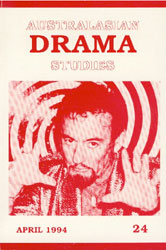 Australasian Drama Studies
Australasian Drama Studies
Number 24 April 1994
Table of Contents
- Issue 024(Full Issue PDF)
- MARK GAUNLETT ‘When I count to three’: stage hypnotism and the nature of performance
- JOANNE TOMPKINS and LISA MALE ‘Twenty-one native women on motorcycles’: an interview with Tomson Highway
- HELEN GILBERT Monumental moments: Michael Gow’s 1841, Stephen Sewell’s Hale, Louis Nowra’s Capricornia and Australia’s Bicentenary
- VERONICA KELLY ‘A form of music’: an interview with Nick Enright
- BRUCE PARR Peter Kenna’s The Cassidy Album: a call for re-viewing
- ROBYN ARCHER Introduction to Emma
- IRIS O’LOUGHLIN ‘I refuse to give easy answers’: an interview with Therese Radic
- MARK ST LEON Robert Avis Radford: ‘The Tasmanian Astley’
- ADRIENNE SIMPSON Footlights and Fenians: the adventures of a touring concert party in gold-rush New Zealand
- Review: ELIZABETH PERKINS: The Girl Who Saw Everything by Alma De Groen and Diving for Pearls by Katherine Thomson
- Review: CHRIS WORTH: International Dictionary of Theatre, ed. Mark Hawkings-Dady, picture ed. Leanda Shrimpton
- Review: BETSY TAYLOR: Medieval Theatre in Context: An Introduction by John Wesley Harris
- Review: DENISE CUTHBERT: Theatre and Reformation: Protestantism, Patronage and Playing in Tudor England by Paul Whitfield White
- Review: LLOYD DAVIS: Drama and the Market in the Age of Shakespeare by Douglas Bruster and The Social Relations of Jonson's Theatre by Jonathan Haynes
- Review: CLIVE PROBYN: Shakespeare's Professional Career by Peter Thomson
- Review: BRUCE PARR: Erotic Politics: Desire on the Renaissance Stage, ed. Susan Zimmerman
- Review: JACQUELINE LO: Games for Actors and Non-Actors by Augusto Boal
- Review: DAVID WILLIAMS: Systems of Rehearsal: Stanislavsky, Brecht, Grotowski and Brook by Shomit Mitter
- Review: JOHN DOWNIE: To All Appearances: Ideology and Performance by Herbert Blau and Dramatic Structure and Meaning in Theatrical Productions by Thomas Price
- Review: MIKE FOSTER: The Process of Drama:Negotiation Art and Meaning by John O'Toole
- Review: IAN STOCKS: Film and Reform: John Grierson and the Documentary Film Movement by Ian Aitken
Issue 23
Fri, 1 Oct 1993Printable version
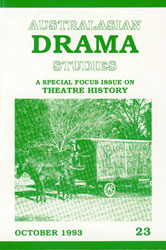 Australasian Drama Studies
Australasian Drama Studies
Number 23 October 1993
Table of Contents
- Issue 023 (Full Issue PDF)
- KAY DREYFUS Reinventing the past: the subjectivities of cultural history
- SUSAN PFISTERER-SMITH Playing with the past: towards a feminist deconstruction of Australian theatre historiography
- BARBARA GARLICK The problem of sources the ‘Bohemian’ Cole collection
- Appendix: The Edward Irham Cole Collection
- BILL DUNSTONE Imperialist Discourse: amateur theatrical performances in Perth to 1854
- KAY FERRES Women making a spectacle of themselves: Ross Praed’s Ariane, melodrama, and marriage reform
- LEAH MERCER ‘A worthy scaffold’: George Rignold’s rewriting and staging of Henry V
- JOSIE FANTASIA J.C.Williamson’s vision for Australia: Australis; or the City of Zero(1900)
- FELIX CHERNIAVSKY Eileen Terry’s tour of Australasia, 1914
- PLAYSCRIPT: Giovanni in Botany, ed. Veronica Kelly
- PAUL MAKEHAM Framing the landscape: Prichard’s Pioneers and Erson’s The Drover’s
- JACQUELINE LO Theatre in Singapore: an interview with Kuo Pao Kun
- GEOFFREY MILNE Wanted (presumed dead): community theatre in Victoria
- DAVID CARNEGIE Casting and doubling in the Elizabethan theatre: a review article
- Review: HELEN THOMSON: Summer of the Aliens by Louis Nowra
- Review: KIM WALKER: Shakespeare and Feminist Criticism: An Annotated Bibliography and Commentary by Philip C. Kolin, and Anxiety: Circulations of Sexuality in Shakespearean Drama by Valerie Tr
- Review: HARRY GARLICK: Italian Renaissance Festivals and Their European Influence, ed. J.R. Mulryne and Margaret Shewring
- Review: DAVID GUNBY: Shakespeare's Theatre by Peter Thomson
- Review: JIM DAVIS: The Profession of the Playwright: British Theatre 1800-1900 by John Russell Stephens
- Review: JOHN DAWICK: British Theatre in the 1890s, ed. Richard Foulkes
- Review: FRANCES BONNER: Australian Film Index: A Guide to Australian Films since 1900, cons. ed. Sandra Hall.pdf
- Review: DAVID MOODY: Peter Brook and the Mahabharata: Critical perspectives, d. David Williams, and The Death if the Actor by Martin Buzacott
- Review: JOHN DOWNIE: The Theatre of Steven Berkoff et. al., and I am hamlet by Steven Berkoff
- Review: JOANNE TOMPKINS : Post-Colonial English Drama: Commonwealth Drama since 1960, ed. Bruce King
- Review: ADRIAN GUTHRIE: Not in Front of the Audience: Homosexuality on Stage by Nicholas de Jongh
- Review: CARL CAULFIELD: The Politics of Theatre and Drama, ed. Graham Holderness
- Review: ALISON RICHARDS: Directors in Rehearsal; A Hidden World by Susan Letzler Cole
- Review: TONY MITCHELL: Cold War Theatre by John Elsom
- Review: DAVE WATT: The Politics of Performance: Radical Theatre as Cultural Intervention by Baz Kershaw, and Street Theatre and Other Outdoor Performance by Bim Mason
- Review: JACQUELINE LO: The Playful Revolution by Eugene Van Erven
- Review: JACQUELINE LO: The Playful Revolution by Eugene Van Erven
Issue 22
Thu, 1 Apr 1993Printable version
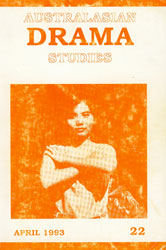 Australasian Drama Studies
Australasian Drama Studies
Number 22 April 1993
Table of Contents
- Issue 022 (Full Issue PDF)
- KERRY L.WILLIAMS The cure for women in comedy: history as TV talk show therapy
- TONY MITCHELL Through Anglo lenses: Italians in Australian television drama
- RON VERBUROT Middle class dissenter: an interview with Alexander Buzo
- JACQUELINE LO Political theatre in Malaysia: 1984 Here and Now
- CAROLYN PICKETT Reality, realism and a place to write in Alma De Groen’s Vocations
- FIONA WINNING Cultural Policy and community theatre
- PLAYSCRIPT Blood Orange by Noëlle Janaczewaks
- MARK GAUNTLETT Theatre going, theatre programmes, tourism
- Review: HELEN THOMSON: Wallflowering by Peta Murray and Wolf by Tobsha Learner
- Review: ANN BLAKE: For the Land They_Loved ed. Cheryl Herr
- review: VERONICA KELLY: Siren and Money and Friends by David Williamson
- Review: TOBY MILlER: My Brilliant Career: The Screenplay by Eleanor Witcombe and Proof: The Screenplay by Jocelyn Moorhouse
- Review: JOHN DOWNIE: Paris by Night by David Hare, The Heat of the Day by Harold Pinter and A Private Function by Alan Bennett
- Review: ELIZABETH PERKINS: Dorothy Hewett: The Feminine as Subversion by margaret Williams and Dorothy Hewett: Collected Plays Vol 1;
- Review: JOHN WEST: The Silver Road by Mervyn King
- Review: HAROLD LOVE: The Salome Dancer by Felix Cherniavsky
- Review: RICHARD CORBALLIS: Stephen Sewell: The Playwrigh as Revolutionary by Peter Fitzpatrick
- Review: COLIN DUCKWORTH: Beckett in Performance by Jonathan Kalb
- Review: KATHERINE NEWEY: Theatre in the Victorian Age by Michael R. Booth
- Review: PAUL McGILLICK: Acting by John Harrop and Theatre Criticism by Irving Wardle
- Review: HOWARD McNAUGHTON: Theatre at the Crossroads of Culture by Patrice Pavis
- Review; MARTIN BUZACOTT: Shakespeare's Festive World by Francois Laroque
- Review: JOHN JOWETT: The\ _Shakespearean Stage 1574-1642 by Andrew Gurr
- Review: LLOYD DAVIS: Stages of History: Shakespeare's English Chronicles by Phyllis Rackin
- Review: RICHARD WHITE: Sport on Australian Drama by Richard Fotheringham
- Review: RICHARD FOTHERINGHAM: From Minstrel Show to Vaudeville: the Australian Popular Stage 1788-1914 by Richard Waterhouse
- Review: RICHARD FOTHERINGHAM: From Minstrel Show to Vaudeville: the Australian Popular Stage 1788-1914 by Richard Waterhouse
- Review: GRAEME TURNER: New Australian Cinema by Brian MacFarlane and Geoff Mayer
Issue 21
Thu, 1 Oct 1992Printable version
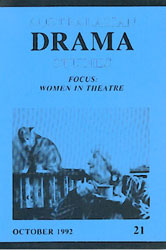 Australasian Drama Studies
Australasian Drama Studies
Women in Theatre
Number 21 October 1992
Table of Contents
- Issue 021 (Full Issue PDF)
- GAYE POOLE A very humanitarian type of socialism: an interview with Mona Brand
- PETA TAIT The act of forming anew: the Melbourne Women’s Theatre Group
- CAROL STEVENSON Vitalstatistix Theatre Company: feminist diplomacy in action
- JOCELYN McKINNON Breaking new ground: an interview with Sandra Shotlander
- HEATHER M. WEARNE Discourses of disruption and Alma De Groen’s The Rivers of China
- PLAYSCRIPT: JULIA’S SONG by Jennifer Compton Introduced by Carolyn Pickett
- BRUCE JOHNSON and MIKE SUTCLIFFE Barbara James: a career in Australian popular music
- HELEN GILBERT Telling it in multiple layers: an interview with Jill Shearer
- JOSIE FANTASIA Considering gender in nineteenth-century Australian theatre history: the case of Maggie Moore
- Review: CAROLYN PICKETT: Around the Edge: Women's Plays
- Review: DAVID CARNEGIE: Jeannie Once by Renée
- Review: GEOFFREY MILNE: Wet and Dry by Janis Balodis
- Review: KERRY L. WILLIAMS: Women and Comedy by Susan Carlson
- Review: TONY MITCHELL: Cinzano: Eleven Plays by Ludmila Petrushevskaya; Stars in the Morning Sky: Five New Plays from the Soviet Union, ed, Michael Glenny; and The Bolsheviks: Three Plays by M
- Review: JIM DAVIS: Actresses as Working Women by Tracy C. Davis
- Review: JOHN DOWNIE: Modern British Drama by Christopher Innes; Retreats from Realism in Recent English Drama by Ruby Cohn
- Review; ERIC IRVIN: Entertaining Australia ed. Katherine Brisbane
Issue 20
Wed, 1 Apr 1992Printable version
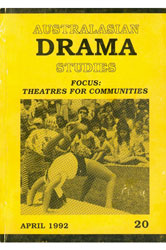 Australasian Drama Studies
Australasian Drama Studies
Theatre for Communities
Number 20 April 1992
Contents
DAVID WATT
Community theatre: a progress report
MARY ANN HUNTER
A Good Yarn and a yarn with Allen Lyne and Alan Holy
DEAN TUTTLE
Street Arts: counting the community
MARKO PAVLYSHYN
Culture and the émigré consciousness: Ukrainian theatre in Australia 1948-1969
GEOFFREY MILNE
Community theatre in Melbourne: The Bridge
PLAYSCRIPT
The Bridge by Vicky Reynolds
MARIA SHEVISOVA
Audiences for Filef Theatre Group’s L’Albero delle rose/The Tree of Roses and Storie in cantlere/Stories in Construction
TONY MITCHELL
Wogs still out of work: Australian television comedy in colonial discourse
Issue 19
Tue, 1 Oct 1991Printable version
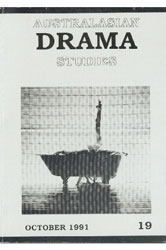 Australasian Drama Studies
Australasian Drama Studies
Number 19 October 1991
Table of Contents
- Issue 019 (Full Issue PDF)
- GEOFFREY MILNE Playbox at the Malthouse: a new home for new Australian writing
- JOANNE TOMPKINS Time passed/Time past: the empowerment of woman and blacks in Australian feminist and Aboriginal drama
- JANE GOODALL Some rooms in outer space
- ELIZABETH SCHAFER Approaching Aphra
- IAN STUART Edward Bond’s Restoration
- MARGARET WILLIAMS Aspects of puppet theatre/ the language of the puppet
- RICHARD BRADSHAW Webb’s Royal Marionettes (1876-1886)
- ERIC IRVIN George Crichton Miln: an individualist on the Australian stage
- PETER LAVERY Actor training at Julliard and RADA
- Review: PETER FITZPATRICK: Daylight Saving by Nick Enright
- Review: JONATHAN DAWSON: Sweetie by Gerard Lee and Jane Campion; The Big Steal by David Parker
- Review: DENISE VARNEY: Top Silk by David Williamson
- Review: HELEN GILBERT: Blood Relations by David Malouf
- Review: PAUL HERLINGER: Reedy River by Dick Diamond
- Review: TONY MITCHELL: Top Girls by Caryl Churchill.; Churchill the Playwright by Geraldine Cousin; File on Churchill by Linda Fitzsimmons; Mad Forest by Caryl Churchill; Moscow Gold by Tariq
- Review: CARL CAUlFIELD: H.I.D. Hess is Dead by Howard Brenton
- Review: ELIZABETH PERKINS: Modern Australian Plays by Elizabeth Webby
- Review: HAROLD LOVE: Opera in New Zealand, ed. Adrienne Simpson
- Review: PHILIP LAWTON: Opera for the Antipodes by Alison Gyger
- Review: HOWARD McNAUGHTON: The State of Play by Leonard Radic
Issue 18
Mon, 1 Apr 1991Printable version
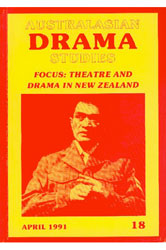 Australasian Drama Studies
Australasian Drama Studies
Theatre and Drama in New Zealand
Number 18 April 1991
Table of Contents
- Issue 018 (Full Issue PDF)
- SEBASTIAN BLACK Guest Editorial and Contributors
- PETER HARCOURT ‘There’s gold in them thar files’: playscripts deposited for copyright registration
- KAREN SHERRY Popular entertainment in Auckland 1870-71
- SIMON GARRETT The plays, playmakers and playhouses of recent New Zealand theatre
- MERVYN THOMPSON Passing through
- ROMA POTIKI A Maori point of view: the journey from anxiety to confidence
- STUART HOAR A playwright’s perspective
- LISA WARRINGTON A life long affair: Renee’s writing for the theatre. Commentary/interview
- SCRIPT: HONE TUWHARE’S IN THE WILDERNESS WITHOUT A HAT
- HONE TUWHARE: Tangi-Hanga, Preamble and Notes In the Wilderness Without a Hat, Music and lyrics
- JUDITH DALE Women’s theatre and why
- MURRAY EDMOND Lighting out for paradise: New Zealand theatre and the ‘other’ tradition
- Review: SIMON GARRETT: Squatter by Stuart Hoar
- Review: JANE STAFFORD; Jones and Jones by Vincent O'Sullivan
- Review: JOHN DOWNIE: Children of the Poor by Mervyn Thompson
- Review: DAVID CARNEGIE: The Land of the Moa by George Leitch, ed. Adrian Kiernander
- Review: HOWARD McNAUGHTON: David Williamson, ed. Ortun Zuber- Skerritt and Williamson by Peter Fitzpatrick
- Review: CHRIS WORTH: Cambridge Guide to World Theatre, ed. Martin Banham
- Review: GREGORY McCART: Public and Performance in the Greek Theatre by Peter D. Arnott
- Review: DAVID WATT: Community Theatre in Australia, ed. Richard Fotheringham
- Review: CARL CAULFIELD: Profiles by Kenneth Tynan
- Review: HARRY GARLICK: The Plantagenets by Adrian Noble
Issue 17
Mon, 1 Oct 1990Printable version
Australasian Drama Studies
Number 17 October 1990
Table of Contents
- Issue 017 (Full Issue PDF)
- INTERVIEW ‘Projecting the inner world onto the existing landscape’ an interview with JANIS BALODIS by Veronica Kell
- INTERVIEW ‘Extremely funny….utterly tragic’; and interview with RICHARD WALLEY by Cliff Watego with notes on Black interviews/Black discourse
- INTERVIEW ‘A fairly hybrid talent’; an interview with JOHN ROMERIL by Leah Mercer
- CHARLES GRAHAME: Valantyne Napier’s Act as Knows with notes on Australian vaudeville
- VALANTYNE NAPIER: The corruption of ‘vaudeville’ in Australia
- MONICA CROUCH: Harry Rickards: the Napoleon of vaudeville
- SCRIPT: ANDREW BOVELL’S THE BALLAD OF LOIS RYAN DAVID WATT
- Introduction The Ballad of Lois Ryan
- SCRIPT: ANTONIETTA MORGILLO’S THE OLIVE TREE SUE CULLEN
- Australian theatre during World War One
- SEBASTIAN BLACK Playboys of the South Pacific: the plays of Greg McGee
- DAVID CARNEGIE The metamorphoses of Foreskin’s Lament
- Review: ADAM SHOEMAKER : The Cherry Pickers by Kevin Gilbert
- Review: VERONICA KELLY: Shimada by Jill Shearer
- Review: CAROLYN PICKETT: Reginka's Lesson by Linda Aronson
- Review: CAROLYN PICKETT: Hiccup by Darrelyn Gunzburg
- Review: TONY MITCHELL: The Forty Lounge Cafe by Tes Lyssiotis
- Review: MIKE NICOLAIDI; Bert & Maisy by_Robert Lord
- Review: MIKE NICOLAIDI; Patrick White by May-Brit Akerholt
- Review: TONY MITCHELL: Dario Fo and Franca Rame by david L.Hirst
Issue 15 & 16
Sun, 1 Oct 1989Printable version
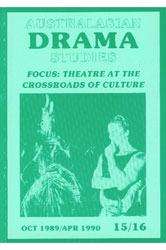 Australasian Drama Studies
Australasian Drama Studies
Theatre at the Crossroads of Culture
Number 15/16 April 1990
Table of Contents
- Issue 015 & 016 (Full Issue PDF)
- GORDON BEATTIE From Maku to mask – from Nepean to Mimili: a report
- INTERVIEW ‘Walking around in other times’: an interview with ALMA DE GROEN by Helen Gilbert
- DAVID GEORGE Casebook: The Tempest in Bali – a director’s log
- MAHMOUD AL-SHETAWI The stage as a political arena: Arab drama in the aftermath of the 1967 war
- IAN CARRUTHERS Julius Caesar in Iraq
- BRIAN GROW Empowering the people – African theatre and neo-colonialism
- CON CASTAN The Uncle from Australia; a play from an ‘ethnic’ space
- CHRISTOPHER BALME New Maori theatre in New Zealand
- SANJAY SIRGAR Appropriate misappropriation and cultural transposition: My Wife’s Mother (1833) and Byopika Bidai (1926)
- Review: MUDROOROO NAROGIN: The Dreamers, No Sugar, and Honey Pot by Jack Davis
- Review: GERRY TURCOTTE: Capricornia by Louis Nowra
- Review: DAVID BIRCH: Prize Winning Plays ed. Max Le Blond and Arthur Lindley
- Review; CLIFF GILLAM: A Fortunate Life by Clem Gorman
- Review; CLIFF GILLAM: The Hope by Heather Nimmo
- Review: JOHN McCALLUM: Away and 1841 by Michael Gow
- Review: PETER FITZPATRICK: Hate by Stephen Sewell
- Review: GEOFFREY MILNE ; After Dinner by Andrew Bovell
- Review: GEOFFREY MILNE ; Only Heaven Knows by Alex Harding
- Review: GEOFFREY MILNE ; Full House, No Vacancies by Paul Davies
- Review: MAREA MITCHELL: The Singing Detective by Dennis Potter
- Review: TONY MITCHELL: Directors' Theatre by David Bradbury and David Williams
- Review: TONY MITCHELL: Feminism and Theatre by Sue-Ellen Case
- Review: DERICK R.C.MARSH: Hamlet, Prince of Denmark(ed. Philip Edwards)
- Review: DERICK R.C.MARSH: The Merchant of Venice (ed.M.M. Mahood) by William Shakespeare
- Review: JIM WHEATLEY: Petty Sessions (trans. Geoffrey Borny) by Racine
- Review: IAN CARRUTHERS: Shakespeare's clown by David Wiles
- Review: DAVID GUNBY: Theatre and Crisis 1632-1642 by Martin Butler
- Review: DAVID GUNBY: Theatre and Crisis 1632-1642 by Martin Butler
Issue 14
Sat, 1 Apr 1989Printable version
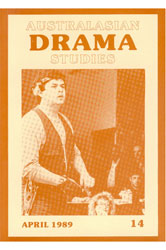 Australasian Drama Studies
Australasian Drama Studies
Number 14 October 1989
Table of Contents
- Issue 014 (Full Issue PDF)
- DAVID WATT The Trade Union movement, Art & Working Life and Melbourne Workers’ Theatre
- CARL CAULFIELD ‘What the bomb does to our minds: Sewell’s Welcome The Bright World and Brenton’s The Genius
- INTERVIEW STEPHEN SEWELL talks to Mary Ann Hunter
- MARY ANN HUNTER CASEBOOK: Sewell’s Miranda
- SCRIPT A Touchy Subject by Darrelyn Gunzburg, Ollie Black & Margaret Fischer
- MARYANNE DEVER Billy Barlow by C.A.Dibdin
- TOM BURVILL Report: The Havana Forum for Cultural Identity and Development
- KAREN SHERRY Locally written plays in Auckland 1870-71
- RICHARD WATERHOUSE Blackface and the beginnings of bifurcation: The minstrel show and the emergence of an Australian popular stage
- Review: KERRYN GOLDSWORTHY: Running Up A Dress by Suzann Spunner
- Review: KERRYN GOLDSWORTHY: The Pathfinder by Darryl Emmerson
- Review: DOROTHY JONES: A Working Man's Castle by Olga Masters
- Review; HELEN THOMSON : La Mama: The Story of a Theatre by Liz Jones with Betty Burstall and Helen Garner
- Review: ELIZABETH PERKINS: Buzo by John McCallum
- Review: BRIAN CROW: Bertold Brecht: Chaos, According to Plan by John Fuegi.pdf
- Review: BRIAN CROW: Modern Tragicomedy and the British Tradition by Richard Dutton
- Review: BETSY TAYLOR: The Medieval Theatre by Glynne Wickham
- Review: DAVID RAWLINSON: Shakespeare's Tragedies: An Introduction by Dieter Mehl
Issue 12 & 13
Fri, 1 Apr 1988Printable version
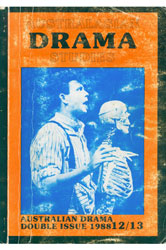
Australasian Drama Studies
Australian Theatre Double Issue
Number 12/13 1988
Table of Contents
- Issue 012 and 013 (Full Issue PDF)
- INTERVIEW ‘Going to the source’: TES LYSSIOTIS talks to Tony Mitchell
- CON CASTAN Greek-Australian Plays
- APPENDICES: Theatrical, Cinematic, Television Material written by Greek Australians
- TEXT Out From Under by Sidetrack Theatre with Dramaturgical & Editorial Note by Tom Burvill
- TOM BURVILL Sidetrack’s Kin: intervening in multiculturalism
- INTERVIEW MICHAEL GOW talks to May-Brit Akerholt
- GEOFFREY MILNE Cho Cho Sam: ‘a triumph of collaboration’
- GAYE POOLE CASEBOOK: Darlinghurst Nights
- PAMELA PAYNE HECKENBERG Women of the Australian Theatre
- THELMA AFFORD Ab-Intra Studio Theatre in Adelaide 1931-35
- Review: DAVID HEADON: God's Best Country by Gordon Francis
- Review: DAVID HEADON: State of Shock by Tony Strachan
- Review: JOHN TULLOCH; Scales of Justice by Robert Caswell
- Review: JOHN TULLOCH; Robert Caswell's 'Scales of Justice' by Don Reid and Frank Bladwell
- Review: JIM DAVIS:Plays by Charles Reade ed. Michael Hammet
- Review: SEBASTIAN BLACK: Wednesday to Come and Pass It On by Renee
- Review: MAY-BRIT AKERHOLT: Europe and On Top of the World by Michael Gow
- Review: HELEN WATSON WHITE: The Share Club by Roger Hall
- Review: SEBASTIAN BLACK: Coaltown Blues by Mervyn Thompson
- Review: SUSAN McKERNAN: Emerald City by David Williamson
- Review: BRONWEN LEVY: Real Estate and Golden Girls by Louise Page
- Review: JEREMY RIDGMAN: The Asian Plays by David Hare
- Review: SUZANNE OLB: From Page to Stage, 'L'Illusion Comique' ed. Gay McAuley
- Review: RICHARD FOTHERINGHAM, Themes in Drama 9: The Theatrical Space ed. James Redmond
- Review: DAVID CARNEGIE: Elizabethan Stage Conventions and Modern Interpreters by Alan C. Dessen
- Review: RICHARD FOTHERINGHAM: Australian Playwrights Speak gen. ed. Ortrun Zuber-Skerritt
Issue 11
Thu, 1 Oct 1987Printable version
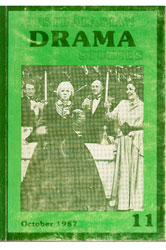 Australasian Drama Studies
Australasian Drama Studies
Number 11 October 1987
Table of Contents
- Issue 011 (Full Issue PDF)
- ELIZABETH PERKINS Form and transformation in the plays of Alma De Groen
- ERIC IRVIN Was John Lang really a four-word dramatist?
- TONY MITCHELL Italo-Australian Theatre: multi-culturalism and neo-colonialism, Part Two
- ROSLYN ATKINSON & RICHARD FOTHERINGHAM Dramatic Copyright in Australia in 1912
- GERRY TURCOTTE ‘The circle is burst’: Eschatological discourse in Louis Nowra’s Sunrise and The Golden Age
- JILL. M .BULL John Hickling: radio drama pioneer
- Review: DAVID CARNEGIE: Every Kind of Weather by Bruce Mason, ed. David Dowling
- Review: HARRY GARLICK :Shakespeare: The art of the dramatist by R.M. Frye
- Review: HARRY GARLICK : The Selected Plays of John Ford, ed. Colin Gibson
- Review: PAUL RICHARDSON: Shakespeare and the Victorian Stage, ed. Richard Foulkes
- Review: NOEL PURDON: Dangerous Matter: English Drama and Politics in 1623/24 by Jerzy Limon
Issue 10
Wed, 1 Apr 1987Printable version
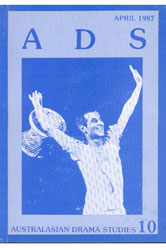 Australasian Drama Studies
Australasian Drama Studies
Number 10 April 1987
Table of Contents
- Issue 010 (Full Issue PDF)
- EUGÈNE VAN ERVEN The Theatre of liberation in India, Indonesia and the Philippines INTERVIEW
- INTERVIEW Renée
- TONY MITCHELL Italo-Australian theatre: multiculturalism and the neo-colonialism Part One
- JON STRATTON Watching the detectives: television melodrama and its genres
- VIC LLOYD Dymphna Cusack’s Morning Sacrifice
- INTERVIEW Jack Hibberd
- LEKKIE HOPKINS Language, culture and landscape in The Men from Mukinupin
- ANN BLAKE Brian Friel and the Irish theatre
- Review: CON CASTAN: The Bread Trap by Vasso Kalamaras
- Review: HELEN THOMSON: Two and Einstein by Ron Elisha
Issue 9
Wed, 1 Oct 1986Printable version
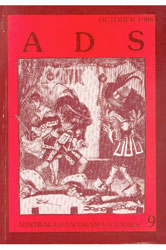 Australasian Drama Studies
Australasian Drama Studies
Number 9 October 1986
Table of Contents
- Issue 09 (Full Issue PDF)
- TERRY GOLDIE Indigenous stages: the indigene in Canadian, New Zealand and Australian drama
- RON BLAIR Understanding the past
- PETER FITZPATRICK Sewell’s Dreams at the Adelaide Festival
- ADRIAN KIERNANDER Actor training at the Centre National d’Art et d’Essai
- JOHN DOCKER In defence of melodrama: towards a libertarian aesthetic
- ALAN HUGHES Coppin and the Australians of Vancouver Island
- VERONICA KELLY Garnet Walch in Sydney
- Review: DAVE WATT: Performance: A Handbook of the Performing Arts in New Zealand 1983/84 ed. Margaret Belich
- Review: HOWARD McNAUGHTON: Page to Stage; Theatre as Translation ed. Ortrun Zuber-Skerritt
- Review: RUSSELL CAMPBELL: Best of British Cinema and Society 1930-1970 by Jeffrey Richards and Anthony Aldgate
- Review: ADRIAN KIERNANDER: A History of the Theatre by Glynne Wickham
Issue 8
Tue, 1 Apr 1986Printable version
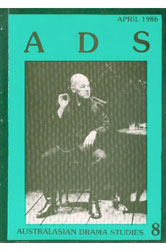 Australasian Drama Studies
Australasian Drama Studies
Issue 8, April 1986
Table of Contents
- Issue 08 (Full Issue PDF)
- Translations and the Australian Theatre May-Brit Akerholt
- Constructing the TV drama audience: a case-study of Channel 2's Sweet and Sour Denis Taylor
- Williams and Kazan: the creative synthesis Geoffery Borny
- Plot and counter-plot in Charles Harpur's The Bushrangers michael Ackland
- Interview: BETTY ROLAND talks to Drusilla Modjeska
- TEXTS: Betty Roland's 'Prosperity Around the Corner' (from Are You Ready, Comrade?) and War on the Waterfront
- Betty Roland's The Touch of Silk and Granite Peak Sue Thomas
- A new direction for 'the_New'? Paul Herlinger
- Review: Miachel Neill: Shuriken by Vincent O'Sullivan
- Review: Jan Howe:Nuigini Nuigini by Raun Raun Theatre, trans. Greg Murphy
- Review: David Bretton: Driftwood by Rachel McAlpine
- Review: Helen White: Objection Overruled by Carolyn Burns
- Review: Brian Kiernan: Sons of Cain and Collected Plays, Vol.1 by David Williamson
- Review: Terry Goldie:Major Plays of the Canadian Theatre 1934-1918 ed.Riachard Perkyns
- Review: Terry Goldie: The Penguin Book of Modern Canadian Drama ed. Richard Plant
- Review: Terry Goldie:Modern Canadian Plays ed. Jerry Wasserman
- Review: Ann Blake:A Critical History of Modern Irish Drama 1891-1980 by D.E.S Maxwell
- Review: Veronica Kelly: Dictionary of the Australian Theatre 1788-1914 by Eric Irvin
- Review: Colin Duckworth: Players of Shakespeare:Essays in Shakespearean Performance by Twelve Players with the Royal Shakespeare Company ed. Philip Brockbank
Issue 7
Tue, 1 Oct 1985Printable version
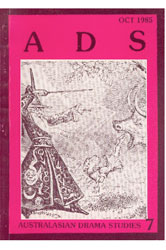 Australasian Drama Studies
Australasian Drama Studies
Number 7 October 1985
Table of Contents
- Issue 07 (Full Issue PDF)
- Performance studies: a personal view GAY McAULEY
- Performance: betrayal or consummation? COLIN DUCKWORTH
- Has Ariane Mnouchkine sold out? GABRIELLE HYSLOP
- Athol Fugard’s ‘insubstantial pageant’: The Road to Mecca STEPHEN GRAY
- Humour in The Dell Trilogy NADIA FLETCHER
- An intertextual adventure: Donna Giovanni, after Mozart and Da Ponte ANNE C. MURCH
- Review: ERIC IRVIN Plays by Dion Boucicault ed. Peter Thomson
- Review: JOHN DRUMMOND Footrot Flats-a stage musical by Roger Hall, Philip Norman, A.K.Grant and Murray Ball
- Review: ELIZABETH PERKINS: Big River and The Marginal Farm by Alx Buzo
- Review: PETER FITZPATRICK: The Golden Age by Louis Nowra
- Review:SANJAY SIRCAR:Rehearsals of Revolution the Political Theatre of Bengal by Ruston Barucha
- Review: BETSY TAYLOR:York Mystery Plays:a selection in modern spelling,ed. Richard Beadle and Pan la King
- Review:GABRIELLE HYSLOP: modern French Drama 1940-1980 by David Bradby
Issue 3.2
Mon, 1 Apr 1985Printable version
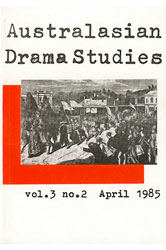 Australasian Drama Studies
Australasian Drama Studies
Issue 6, April 1985
Table of Contents
- ADS Vol.3 (2) April 1985 (Full Issue PDF)
- 'A bit of cackle': Australia's beginnings in English Drama CLIFF HANNA
- INTERVIEW Ray Lawler talks to Alrene Sykes
- The doll and the legend JOHN McCALLUM
- Chinese theatre on the Victorian goldfields 1858-1870 HAROLD LOVE
- INTERVIEW Peter Yeldham talks to Jan Howe
- Paths for a flightless bird: roles for women on the New Zealand stage since 1950 HELEN WHITE
- Reviews The blind giant is dancing PETER FITZPATRICK
- Reviews Australian Drama Productions 1950-1969 JOHN McCALLUM
Issue 3.1
Mon, 1 Oct 1984Printable version
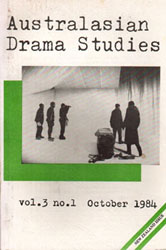 Australasian Drama Studies
Australasian Drama Studies
Volume 3 Number 1 October 1984
Table of Contents
- Issue 3.1 (Full Issue PDF)
- Guest editorial TERRY STURM
- A brief chronology of theatre in New Zealand LAURIE ATKINSON
- Dunedin's Globe Theatre: the Carey years DAVID CARNEGIE
- Dunedin's Globe Theatre: the Carey years DAVID CARNEGIE
- 'What kind of a society can develop under corrugated iron?': glimpses of New Zealand history in New Zealand plays SEBASTIAN BLACK
- Footrot Flats: a casebook RICHARD CORBALLIS
- Raymond Boyce, stage designer JOHN ROBERTS
- 'Divine gossip': interviews with six New Zealand directors RUTH HARLEY
- The third New Zealand playwrights' workshop DAVID CARNEGIE
- Promise and frustration: New Zealand playwrighting since 1975 MERVYN THOMPSON
- Reviews PHILLIP MANN: New Zealand Drama 1930-1980,: an illustrated history by John Thomsom; MICHAEL NEILL: Out in the Cold by Greg McGee; JEAN BETTS: Outside In by Hilary Beaton; SUNNY AMEY: On Stage 1; Four Plays for Secondary Schools, ed. David Dowling; JOHN THOMSON: New Zealand Theatre Annals: Christchurch 1900-1919, comp. Howard McNaughton; MAYBRIT AKERHOLT: Netherwood by Patrick White; RICHARD FOTHERINGHAM: Spangles and Sawdust: the Circus in Australia by Mark St. Leon.
Issue 4
Sun, 1 Apr 1984Printable version
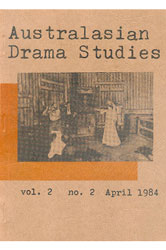 Australasian Drama Studies
Australasian Drama Studies
Volume 2 Number 2 April 1984
Table of Contents
- Writing television drama (with DOCUMENTATION from Crawford Productions on writing requirements for commercial TV series and serials) ROBERT CASWELL
- Feminist theatre: A monologue to start discussion ALISON LYSSA
- ‘The Barnum of Australia’: William Anderson MARGARET WILLIAMS
- Another look at the old war-horse: Alan Seymour’s The One Day of the Year ALRENE SYKES and KEITH RICHARDS
- Ion Maxwell: Forty years in Australian theatre and radio WILLIAM MAXWELL-MAHON
- At the crossroads LOUIS NOWRA
Issue 3
Sat, 1 Oct 1983Printable version
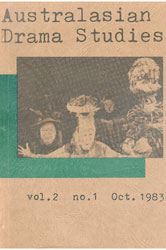 Australasian Drama Studies
Australasian Drama Studies
Volume 2 Number 1 October 1983
Table of Contents
- Epidavria 1982 DENNIS DOUGLAS
- Writing television comedy: Gary Reilly and Tony Sattler talk to Albert Moran
- Performance and interpretation of two recent Beckett plays: ROCKABY and OHIO IMPROMPTU COLIN DUCKWORTH
- ‘Three shillings for a bolt of hessian’: Stage design in Melbourne 1919-1953 PAMELA J.ZEPLIN WAITE
- The banning of Marcus Clarke’s THE HAPPY LAND: Stage, press and parliament VERONICA KELLY
- W.S. Lyster’s 1861-68 opera company: Seasons and repertoire HAROLD LOVE
Issue 1.2
Fri, 1 Apr 1983Printable version
Australasian Drama Studies
Popular Theatre Issue
Volume 1 Number 2 April 1983
Table of Contents
- Vol.1 No.2 April (Full Issue PDF)
- What is popular theatre? Michael Booth
- The politics of the popular Tom Burvill
- Unprecedented in history:drama and the dramatic in television John Docker
- Garnet Walch's AUSTRALIA FELIX: a reconstruction
- 'The Hottentot Venus' and other African attractions in nineteenth-century England
- Louis Nowra, Stephen Sewell, and Neil Armfield talk to Jeremy Ridgmann
- P.R. Stephensen and the early Workers' Theatre Movement in London
- P.R. Stephensen's BLASTING THE REDS (1927)
Issue 1.1
Fri, 1 Oct 1982Printable version
Australasian Drama Studies
Volume 1 Number 1 October 1982
Table of Contents
- Issue 1 Vol. 1 (Full Issue PDF)
- Editorial
- William Archer:The prophet of Ibsen at the feet of false gods Eric Irvin
- William Forster and the drama of ideas Dorothy Green
- The Women and Theatre Project 1980-81 Chris Westwood
- REPORT on the Women and Theatre Project
- Sport and nationalism on Australian stage and screen- From AUSTRALIA FELIX to GALLIPOLI Richard Fotheringham
- A shameful conquest of itself- Images from the Empire in post-war British drama Jeremy Ridgman
- All in the family- Australian television situation comedy Albert Moran
- CASEBOOK - Richard Wherrett directs the Sydney Theatre Company's MACBETH Collete Rayment

